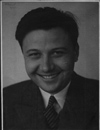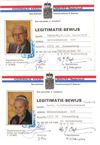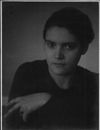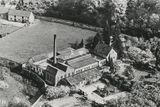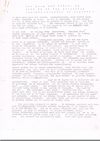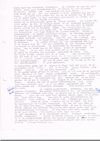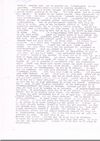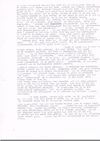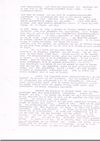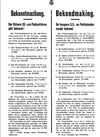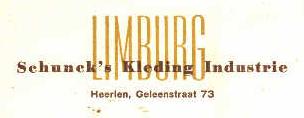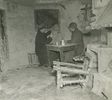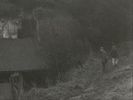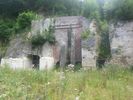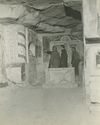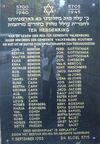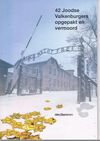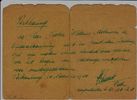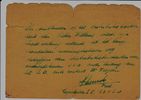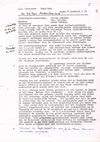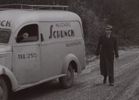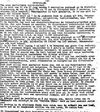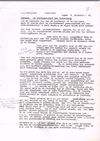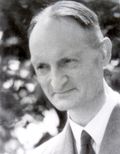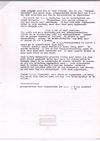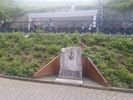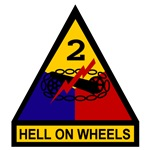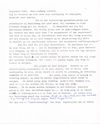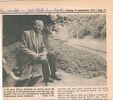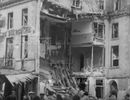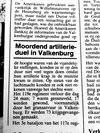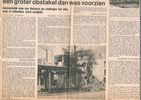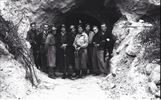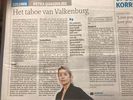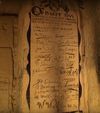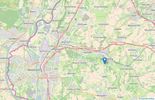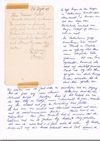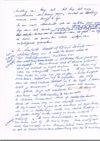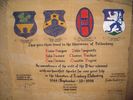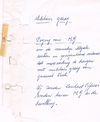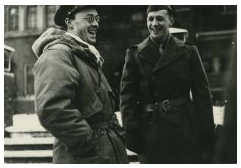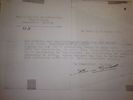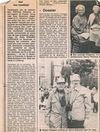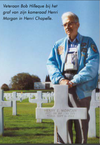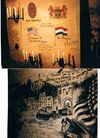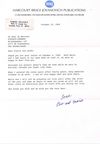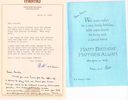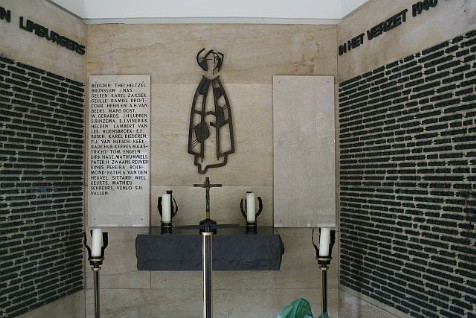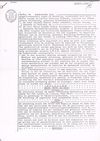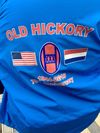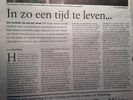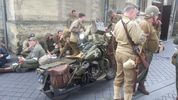

|
|
|
|
|
|
All resistants, who play a role in this story on Valkenburg and its surroundings.
– 55 persons
Berckel Karel C. van, Heerlen
Berix Jan Willem , Heerlen
Betuw Johannes Petrus Maria van, Heerlen
Brands Lambert , Valkenburg
Caldenborg A. , Houthem
Caubo Jean-Michel , Schin op Geul, Paris
Cobbenhaegen Frans Alexander ,
Coenen Jan Hubert , Simpelveld
Corbey George , Valkenburg
Cornips Constant Jozef Ernest , Heerlen
Crasborn Jacobus Reinier Peter , Heerlen
Cremers Anna Maria Johanna , Voerendaal
Cremers Hein , Valkenburg
Cremers Wielke , Valkenburg
Dahmen Leo , Valkenburg
Delahaye Pauline , IJzeren
Donners Kaspar , Valkenburg
Flachs Käthe ,
Francotte Wilhelm Joseph , Vaals
Freysen /Freijsen Wilhelmus Agathus Petrus , Valkenburg
Geelen Theodorus Gertrudis Hubertus , Meerssen
Goossen Theo J.M. , Kerkrade
Gronden Abraham Cornelis van der,
Gronden Gerrit Jan van der, Valkenburg
Grotaers Coen , Berg en Terblijt
Hendriks J. , Berg en Terblijt
Hennekens G. Hub , Valkenburg
Horsmans Louis (Gerardus Aloysius Antonius) ,
Horsmans Wim (Willem Bernard Jozef) ,
Hout Jan (Johannes Franciscus) van, Tilburg
Jansen Sjir / Gerard , Geulhem
Jaspers Marie-Thérèse , Klimmen
Kooten Bep van, Klimmen
Laar H.J.R. van, Margraten
Laeven Albert Hubert ,
Laeven H.P.August , Schin op Geul
Lambriks Jo , Valkenburg
Meijs Sjeng , Valkenburg
Nijst Charles Joseph , Valkenburg
Ogtrop Harie van, Valkenburg
Peusens gezusters ,
Prompers Nicolaas Maria Hubertus , Heerlen, Broekhem
Roks /Rocks Jan Joseph , Valkenburg
Roy Hubertus Andreas van, Valkenburg
Schoenmakers F. , Sibbe
Schunck Pierre , Valkenburg
Schunck-Cremers Gerda , Valkenburg
Smits Gerard Frank , Hulsberg
Soesman Gerhard Lodewijk Robertus , Maastricht
Starmans J. , Valkenburg
Ven Johannes Hendrikus op de, Valkenburg
Vroemen Joseph Hendrik Hubert , Valkenburg
Westerhoven Jan van,
Willems Victor Benedictus Josephus , Valkenburg
Wolf G.A. , Sibbe
Our soldiers can no longer do anything. Now it is our turn.
We will get in the way of the Germans wherever we can.
Henri Vullinghs on the first day of the occupation, May 10, 1940.
Resistance in Valkenburg
during World War II.
Memories of Pierre Schunck and other original textes, collected and commented by Arnold Schunck
 This website is under a Creative Commons license:
This website is under a Creative Commons license:
• No commercial use
• No changing
You are free to share — to copy, distribute and transmit the site, also partially, but not for commercial purposes..
You may not alter, transform, or build upon this work and of course you have to indicate the author and the source as well as the license conditions.
Pierre Schunck, ∗ 24-03-1906 in Heerlen, ⚭ 03-10-1936 Gerda Cremers in Valkenburg, † 02-02-1993 in Kerkrade.
He gained fame mainly because he led the resistance organization L.O. in Valkenburg during WW2.

Identity Cards of the Resistance for Gerda and Pierre Schunck-Cremers
Issued by „Voormalig Verzet Limburg“ (Association of Veterans of the Resistance), registration number (KvK) V 187800
One of the regular occasions on which the members of the VVL met was the annual commemoration in September of their fallen comrades on the Cauberg in Valkenburg. Because in September 1944 most of Limburg (NL) was liberated. In the meantime, this reunion does not take place anymore, as the former resistance fighters are either already deceased or too old. The commemoration of the dead on the Cauberg now takes place, as everywhere in the Netherlands, on May 4.
- Introduction
- Before World War II
- Unorganised Resistance
- Organised Resistance
- Redistribution Clothing for “divers”
- Founding of the L.O. district Z18 (Heerlen)
- The “diver’s inn” in the Caves of Meerssenerbroek
- Building up the “diver’s inn”
- Coen Grotaers
- One unit in every village
- Turkish passports
- District Leader Berix
- The L.O. district of Heerlen 2
- Meetings
- Female couriers are surer
- The stream of the divers increases
- The verger in the confessional
- The Jews in Valkenburg
- Traitor
- Manipulations with Food and Cards
- The Raid on the Distribution Office in Valkenburg
- The Raid on the Distribution Office in Heerlen
- Butter and Eggs
- St. Joseph Hospital
- End of the “diver’s inn” 1
- An Own Intelligence Group
- The disappearing of the residents’ register
- Two Resistance Men shot on the Cauberg
- The End of the War and afterwards
- The Liberators are Approaching!
- The Liberation of Valkenburg
- What did the organisations L.O, K.P., O.D. and R.V.V.?
- The murder of the Nazi collaborator
- Evacuation
- Food for the caves
- Kerkrade destroyed, the entire population fleeing. A large part of the refugees in Valkenburg
- Allied Killed In Action
- South Limburg is free and now the rest!
- Old Soldiers Never Die. The veterans return
- Veterans (NL) and their fallen comrads
- Death of an Ancient Resistance Man
- Commemorations after the war. What is memory culture good for?
- Epilogue of Cammaert
- Sources and the colors of the margin lines at the left side of the page
- Links WW2 & Resistance
This text is a mosaic of different sources, which I have on this item. It is a patchwork of quotations, because they tell different parts of this story, sometimes the same event, but then they are complementary. Here and there they are connected by a commentary of my own. Much has been adopted literally from interviews. Scans of texts written by Pierre Schunck himself after the war have an important place. Whole pages from his memories look like typewriter font. Because that was it. The corresponding scans can be found right next to it, as a miniature. Click for an enlargement.
Also I wrote, what we, his children, can still remember from his stories.
By the color of the margin line at the left you see at a glance whose words these are. If you move with your mouse over a paragraph, the source is displayed as a “tool tip” text. (Does not work on mobile devices.) Literal quote blocks from the interviews have got a darker background (not in the printed version) and are indented.
Below you find an overview of the sources
| Memories Pierre Schunck | |
| Interview Nederlands Auschwitz Comité | |
| Interview NIOD | |
| History of Valkenburg | |
| The hidden front, doctoral thesis by Fred Cammaert | |
| funeral oration for “Paul”, by Theo “Harry” Goossen |
For more information about these colours, go to Sources.
- External links to websites about World War II and the Resistance in Limburg
- In the text that follows below, you can read the words “district” and “subdistrict”. For practical reasons the Dutch resistance divided the existing provinces into smaller parts. This didn’t correspond to any official classification, but it was only based on the resistance work. They used the words “district” and “subdistrict”. The subdistrict of Valkenburg, whose leader was my father, included Valkenburg itself and some villages. In the beginning it was independent, later it belonged to the district of Heerlen.
- You also will find several times the expressions "hiding people" or "divers". The latter one is the translation of the Dutch word "onderduikers". During the war it was used for all persons, who were wanted by the Germans and for whom it was better to hide, to dive into the underground. It is for them that the organization L.O. was founded. For Jews, allied pilots who had crashed on Holland, young men who didn’t want to to go to work in Germany in order to replace the German soldiers.
- To protect themselves and others, they used aliases that had the same initials as the real name. For it was still common practice that the initials of a person were embroidered in their clothes. A famous example is the organizer of the French Resistance Jean Moulin. Amongst others, he had the pseudonyms Joseph Mercier and Jacques Martel. The resistance people knew of each other only these pseudonyms. The real names became known only after the war, but on commemorations and other meetings they usually still used the resistance names. Pierre Schunck called himself Paul Simons.
Introduction

What is a commemorative culture good for?
When preparing the commemoration celebrations Valkenburg 2019 – 75 years liberated, it turned out that almost nobody knew what the resistance in Valkenburg did. In fact, it was hardly known, especially among the youth, that there had been a resistance against the Nazi’s at all. Why is it important that this memory is kept alive? Of course, many will immediately answer, because that should never happen again. Of course that’s true, but everyone knows that history is NOT repeating itself. Hitler is dead and the current right wing populists are not just a copy of the Nazi’s. But still, there have been things back then that we still have to watch over now.
The Gestapo (Secret State Police) would have been jealous of all the options available to today’s internet giants, such as Google, Amazon, Facebook and so on, to spy on us. Today this is not done for political but for commercial reasons. The fact that the religion of people is registered in many countries does not have any political reason either. But still: when the Nazis came to power in Germany, they immediately kwew how to find the Jews, the gypsies, the unionists, the communists etc. When the wrong government is in power, all data collected can be used against us. In China this is already happening in a very effective way.
The resistance started small, almost unnoticed even by those who committed resistance. Until they suddenly realized that they were in the middle of it.
With fascism it is just like that. It starts small. Bullying at school or at work. “Because” someone is different. Different belief, different skin color, different gender orientation – whatever. And in order not to be completely shut out, the victim often laughs with them. Bullies therefore often do not even notice that they are bullying someone. It becomes worse when that bullying happens in order to make feel better the bullies as a group. This way especially disadvantaged groups often feel attracted by foreigners’ haters. Because “we don’t have nothing, but at least we are civilized people“.
Then suddenly it becomes a movement, a party, a mass murder.
If you see someone inciting to hate others, say NO. If you see someone being excluded because he or she is different: resist!
Because the resistance that’s US!
Valkenburg, an important center for people in hiding
This text is from my contribution to the memorial book “Valkenburg 75 years liberated”
The organized resistance in Valkenburg consisted mainly of assistance to hundreds of people in hiding, the so-called onderduikers, which is the Dutch word for divers. For example, men who did not want to work in the German war industry. The subdistrict consisted of Valkenburg, Berg and Terblijt, Sibbe, Margraten, Schin op Geul, Klimmen and Houthem. Each parish had a diver’s leader who had direct contact with the diving addresses. Couriers (mostly women) maintained the connection with the district management. Less and less was written down because of the dangers. Partly because of that, but also because of stupid luck, the LO had no losses in Valkenburg.
Since 1943, people who wanted to go into hiding came in increasing numbers from all parts of the Netherlands, although there were many German soldiers in the seized hotels in Valkenburg. But the presence of so many occupiers turned out to be a plus. Except for the KP-people Coenen and Francotte, who were beaten from one hotel to the other, before they were murdered on the Cauberg during the last days of the occupation. (The KP was the armed arm of the resistance in South-Limburg. They had their HQ in a farm in Ulestraten.)
Quite a lot of people in hiding worked in hotel kitchens, etc. They could therefore earn their own livelihood, as well as people in hiding who were housed with farmers. They hardly needed help in the form of coupons. Many of those, who were in hiding with farmers, received an agricultural exemption from Brands, the boss of the food local agency and could then legally reside and work there.
The rest of about one hundred and fifty people in hiding needed help from by means of ration stamps. That number fluctuated. There are no precise numbers, since they did not write down anything. At the distribution office next to the current chairlift to the Wilhelmina tower, the officials Freysen and Willems put aside between five hundred and eight hundred ration cards every month.
…
The Jews of Valkenburg did not survive the war to a large extent. Almost nobody could believe that those stories about extermination camps were real. But dozens of Jews, also from elsewhere, found shelter here.
Arnold Schunck, son of the subdistrict leader Pierre Schunck
I have to add: I do not know anything about the fate of Sinti or other Roma in Valkenburg, if here were any at all during the occupation.
The resistance against the German occupation during the second world war began on the first day. Spontaneously, disorganized. As forms of civil disobedience. Gradually, particularly the aid to “divers” was organized (This was how people were called, who had to hide from the Nazis for various reasons). It was not a major military contribution to the victory of the allies. The hiding of young men who had to go to Germany to do forced work certainly harmed the German war industry anyhow. But in particular, many lives were saved. Here you find the story of Pierre Schunck and his people, which was typical of this resistance.
However, in some respects the resistance in the province of Limburg and in Valkenburg differs from the rest of the country. The main points:
- In Valkenburg we have to consider the particularly high proportion of supporters of the national socialist party N.S.B. (1935 in Valkenburg: 23.4 %, national average: 7.94%, Limburg altogether 11.7 %, mining district of Limburg 17%). That made resistance especially dangerous in this community.
- Long before the arrival of the German troops, the Dutch archbishop declared the membership of Nazi organizations incompatible with Christianity. Other churches made similar statements . In those years, the dutch province of Limburg was still very Catholic, which meant that large sections of the Catholic clergy quickly took a leading role in the resistance. In the Limburg mining area, the cooperation with trade unionists , socialists and communists was smooth despite ideological differences.
- Limburg was, like the other border provinces, an important area for taking in people from the densely populated West of the country, who had to go into hiding. In the tourist town of Valkenburg, they were housed not only in farms, but also in hotels . See also the epilogue of Cammaert at the penultimate page.
- The geographical position at the southeast corner of the Netherlands, made this region suitable as a transit area for many refugees and allied pilots to Switzerland or Gibraltar. That was an important activity especially in the many border towns . For Valkenburg itself this played a minor role.
This text is a mosaic of different sources, which I have on this item, here and there with a connecting commentary of my own. On the color of the margin line at the left you see at a glance where they come from. If you move with your mouse over a paragraph, the source is displayed as “tool tip” text. Literal quote blocks from the interviews have a darker background (not in the printed version) and are indented.
Below you find an overview of the consulted sources
Before World War II

Pierre Schunck (*24-03-1906, Heerlen †02-02-1993, Kerkrade) was the eldest son of the Dutch businessman Peter J. Schunck and Christine Cloot.
Settela Steinbach,
May 19th, 1944
Already as a student, Pierre Schunck showed a social feeling. Or was it also his desire after an interesting life, that made him help in the Sinti (gypsy) camp near the Heksenberg in Heerlen with a program to teach the children? My father made this job for the Steinbach family. This pleased the mother so much that she promised one of her daughters to him. This, however, never became true.
There were successively several women, who were called ”Mutter Steinbach”. In this case this was probably the later ”old” mother Steinbach, Johanna Bamberger (1893-1935).
The camp was opened on October 27th, 1923. Pierre Schunck was then 17 years old. The Franciscan Justus Merks of the ”Woonwagenliefdewerk” (Caravan work of love) was pastor there and the driving force behind things like the literacy of the children. Perhaps Pierre was inspired by him to become a Franciscan.
As was to be expected, the Nazis killed most of the Sinti people in Limburg, including the Steinbach family.
The genocide of the Romani in Limburg and elsewhere
Who does not know the image of Settela Steinbach looking during the war out of the cattle wagon, with which she is going to be transported to Auschwitz? She was born near Sittard, she belonged to this same family Steinbach. Only her father survived the war and died in 1946 in Maastricht.
Johanna Bamberger (1893-1935) was called the “old mother Steinbach”. She was mother, later grandmother and great-grandmother of the family, where Pierre Schunck gave tutoring in the twenties.
About the Sinti people around the Heksenberg a richly illustrated book was published, which now has its second edition: Settela en Willy en het geheim van de Heksenberg (Settela and Willy and the mystery of the witches’ mountain), ISBN 978-90-822416-3-1, available at the Thermen Museum, Coriovallumstraat 9, Heerlen or at http://www.landvanherle.nl/bestellen
Apart from the beginning, the following movies about the book on YouTube come almost completely without text:
Video 1
Video 2
This picture comes from the second video.
Corresponding to the tradition ruling in that time, the family early made clear to Pierre: “Your future lies here in the business, except if you want to become a priest.”
For different reasons Pierre felt more attracted to become a priest. He completed his studies in Megen near Nijmegen and Hoogcrutz (at the southern edge of southern Limburg). But he left the monastery again before the ordination to priest.
After the time in the monastery in the thirties, he managed by order of his father’s company a laundry in Valkenburg. For lunch he often went to hotel Cremers, which was owned by the parents of a friend, Joop Cremers. There he met his latter wife, Gerda Cremers (DB).
World War II has exerted a big influence on their further life. Due to their moral and national convictions, Pierre and Gerda saw only one possibility: to stand up against the German occupation.
The Hollandsche Stoomwasscherij (= steam laundry) was founded in 1904 on the Plenkertstraat in Houthem (later Valkenburg) by Pierre Cloot from Heerlen, father of Christine Cloot and father in law of Peter J. Schunck. Christine and Peter married in the same year. Peter became owner in 1909, while Leo Cloot became the director. In this case, the Rijckheyt Archive confuses Pierre Schunck (who was 3 years old at that time) with his father Peter Schunck.
Pierre became director (not owner) in the thirties. The laundry was sold in 1947 to E. Hennekens.
See also the inventory list of the archives of Leo (L.H.M.) Schunck in the above-mentioned Rijckheyt: A.12 Hollandsche Stoomwasscherij P. Schunck te Valkenburg, 1904 - 1947
Unorganised Resistance

The First People to Hide (May 1940)

How did one get into such a dangerous resistance adventure?
One didn’t decide to join the resistance. Events, sometimes small incidents, made one to step in; the result was that you did something to help other, something that was forbidden by the occupying forces. So you got from one step to the next. I will try to explain it by my own experiences.
May 10th, 1940, on Friday before Pentecost. Warm weather, blue sky. German airplanes in low flight over our house. In Valkenburg, the hostile tanks climb the Cauberg on their way to Maastricht. We are occupied.
Dutch soldiers, who operated an old cannon on the Cauberg before, tipped over the monster in the middle of the street to hinder the Germans in their advance and then disappeared themselves. They are sitting along the slope of the wood in front of our house, the “Polverbos”, and don’t know where to go. I see them. I couldn’t leave the boys in the hands of the enemy, could I?
We invited them in our house and my wife, Gerda, immediately was busy to serve a nutritious breakfast to them. Twelve soldiers then had to be changed into civilians. With some improvisation we made it. The staff had started the daily work in the meantime. Consultation with the men of the staff yielded a couple of garments and the soldiers were modified to a bit bedraggled civilian boys. So we had at once the first people to hide (we called them divers) because transportation back home was only possible for a couple of boys from South Limburg (that is the direct surroundings) .
In the week after Pentecost the journey back home was organized for the vacationists run aground in Valkenburg and our boys traveled with them. Some of them sent back the lent civvies properly.
But now to the weapons and uniforms they left. Johan de W., our engineer, knew a solution. He burned the uniforms in the steam-boiler in a nice fire. But, Johan said, we could possibly need the guns urgently to chase the Jerries away. He knew what he did. He removed one part. The weapons themselves were greased thickly, wrapped up with rags and buried in the garden one by one. The parts which he had held separately were greased too, packed and hidden separately into a little box. He proceeded this way so that if the NSB-people or the Germans would find the guns, they would not be able do anything with them.
The rest of this page: Chalices And Mass Gowns
Public Resistance

From: The History of Valkenburg-Houthem:
Many Dutch people went out with a white carnation in the buttonhole on June 29th, 1940, prince Bernhard’s birthday. Because this was the coat of arms flower of the prince. It was the first public resistance act against the Nazi power.
Probably the Dutch people never understood better the words in the national anthem
"de tyrannie verdrijven
die mij mijn hert doorwondt"
(banish the tyranny, that wounds my heart)
than in these bitter years of occupation. The number of resistance fighters grew gradually as a result of the obstinacy with which the Nazi ideology was imposed, the increasing lack of rights, the persecution of the Jews, the shootings of hostages, the numerous deportations to the concentration camps, the forced labor service in the German armament industry, the statement of loyalty, that every student had to sign, as well as the captivity of the Dutch army.
These and many other things nursed the resistance will. The hate for German and Dutch Nazis increased. Public resistance to the merciless oppression and the violation of fundamental human rights happened still more frequently.
Initially this resistance consisted mainly of civil disobedience, but gradually they began also to sabotage. The help to divers followed this pattern too: What started as spontaneous, individual help, became progressively organised at ever higher levels. There was a need of humanitarian help in the first place, but this work also had a military significance: young men who didn’t want to go for forced work to Germany, to replace the soldiers in the (armament) industries and food production there, were hidden. Crashed allied pilots were “dispatched” to Gibraltar via the so called pilot line. The story of Pierre Schunck is very typical. He has never “planned” it. You could almost say: it occurred to him.
There were other examples of civil disobedience, in which most people joined in. For instance, everyone who had the opportunity to do so, kept a few chickens, a goat or a pig to have something beyond the rations. These animals had to be registered with the distribution office, and then one got less rations. To circumvent this, they often registered less animals than they really had. Family Schunck also had a gaggle of chickens behind the laundry, of which only a few were registered. If an inspector would come to check the number of the animals, a signal would go backwards, and the chickens would be chased by someone of the staff in the adjacent orchard. This was a popular sport, which already bore the seeds of rebellion inside.
Chalices And Mass Gowns

For one year nothing happened. The Germans softened on nice, our soldiers, who were prisoners of war, were allowed to go home again and we wondered: “Why did we expose ourselves so much to danger by helping these boys? They are officially and properly at home now.” Until the rumor startled Valkenburg that the SS had expelled the Jesuits back to Germany and confiscated their cloister. The rumor was largely true but not all of the fathers returned to their native country. The superior and a couple of further fathers went underground at rector Eck, an uncle of my wife and pastor of the Franciscan nuns cloister St. Joseph in Valkenburg-St. Pieter.
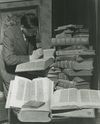
The Antique Books
After the liberation, Pierre Schunck looks at the antique books that were saved from the Jesuit Monastery in Valkenburg in October 1942.
Photo: Dwight W. Miller
Source: https://nimh-beeldbank.defensie.nl/beeldbank/
Film
In October 1942 the evacuation of the Jesuit monastery took place in Valkenburg, in which there was a unique collection of books and a planetarium. A high S.S. delegation went to Valkenburg specially for this purpose. Within a few weeks the monastery church was demolished to the last stone.
…
The monks had literally been put on the road. Since then the building was at the disposal of the Hitler Youth. Should be: Imperial school of the SS
Read also the wikipedia article in German about this Reichsschule der SS or in Dutch
At http://nederland-in-oorlog-in-fotos.clubs.nl/foto/detail/10963416_1942-valkenburg-reichschule01 we read about that theological college: The Jesuit monastery was built in 1893-1895 according to plans of H.J. Hürth as Collegium Maximum or Ignatius College for German Jesuits. A wing and a library were added in 1911. In 1943 the chapel was demolished and from 1948 to 1961 the building was empty. Then it was involved by the Franciscan Sisters of St.Joseph.. These sisters were already in Valkenburg, on Sint Pieter at that time. This monastery with German religious was also created during the "Kulturkampf" under Bismarck.
At that time, W. Eck was rector there. He came from the Dutch side of the German-Dutch border, had a German father and was therefore suitable as a chaplain for German nuns.
We continue reading the original text of Pierre Schunck: „But not all of the monks…
were gone back to their native country. The superior and some other fathers went hiding at the rector of St.Pieter’s monastery, Rector Eck, an uncle of my wife.
He called me with the urgent request to visit him. I only thought that the sisters of St. Pieter were now to be evacuated to Germany. They too were of German origin. But the German monks were sitting in the rector’s room. They had only one big concern. Namely the sacred vessels and precious robes, to which they attach a sacred value, should not fall into the hands of the pagan SS.
Their expulsion from the monastery was already a few days old, and several families in Valkenburg (especially Caselli and Wijsbek-Caselli) had already secured paintings and other accessible things. They had been able to do so easily because the monastery had been abandoned for some days. But now a construction firm was there with workers, to prepare the imminent arrival of the Reichsschule. The monks asked me, as a president of K.A., whether I knew someone who would dare to bring out their precious possessions of monstrances, chalices, mass gowns and relics. They were in a safe under the sacristy of their church. I promised to see what could be done and they gave me the keys of the monastery and sacristy.
Pure coincidence collaborated again. A construction supervisor of the work in the monastery called, whether we could not pick up, wash and return the dirty laundry left by the Jesuits. This was the great opportunity to execute the “chalice job” on the bright day. The vans were all on the road, but the horse and the waggon were at home. My neighbor, Kaspar Donners, and me myself, went there, equiped with some laundry baskets. After we had the baskets almost full, I also went to the sacristy to see if there were not “dirty liturgical vestments” too. We put the monstrances, chalices, and liturgical vestments under the dirty clothes, and the workers helped us to hoist the heavy baskets on the waggon and Kaspar and I came home unharmed. Uncle Eck could calm the fathers, that everything had gone according to their wishes. We however were saddled with a great value of “enemy fortune”. But that was not yet all.
The Reichsjugendführer Rosenberg came from Lithuania. The new board (of the Reichsschule) wanted to give him a precious book collection from Lithuania and there was something like that in the library of the Jesuits. But they could not find anything, because the index card box was mixed up. So the Father Librarian was brought back from Germany. He had to assemble these books. Well, this priest asked me to continue to wash the laundry of the Reichsschule. He said to be able to hide some books under the clothes when the driver would come.
He also smuggled out small books himself, hidden under his long robe. And so every week, as long as the Father worked there, a precious book came to us. In the wardrobe in our bedroom hung precious hand-embroidered chasubles, behind our clothes the chalices were hidden. And in the archive room behind the office stood the old books. It soon ruggedly became clear to me that this storage method was life-threatening.
Potatoes and Weapons

Spring 1942
With the ladies of the “Catholic Action” and farmers from the surroundings, Paul and his people also manage to set up a kitchen for children as an alternative to the (Nazi-) Winter Help. They got hold of the kitchen equipment in the Reichsschule and set it up in the attic of Paul’s laundry:
were gone back to their native country. The superior and some other fathers went hiding at the rector of St.Pieter’s monastery, Rector Eck, an uncle of my wife.
He called me with the urgent request to visit him. I only thought that the sisters of St. Pieter were now to be evacuated to Germany. They too were of German origin. But the German monks were sitting in the rector’s room. They had only one big concern. Namely the sacred vessels and precious robes, to which they attach a sacred value, should not fall into the hands of the pagan SS.
Their expulsion from the monastery was already a few days old, and several families in Valkenburg (especially Caselli and Wijsbek-Caselli) had already secured paintings and other accessible things. They had been able to do so easily because the monastery had been abandoned for some days. But now a construction firm was there with workers, to prepare the imminent arrival of the Reichsschule. The monks asked me, as a president of K.A., whether I knew someone who would dare to bring out their precious possessions of monstrances, chalices, mass gowns and relics. They were in a safe under the sacristy of their church. I promised to see what could be done and they gave me the keys of the monastery and sacristy.
Pure coincidence collaborated again. A construction supervisor of the work in the monastery called, whether we could not pick up, wash and return the dirty laundry left by the Jesuits. This was the great opportunity to execute the “chalice job” on the bright day. The vans were all on the road, but the horse and the waggon were at home. My neighbor, Kaspar Donners, and me myself, went there, equiped with some laundry baskets. After we had the baskets almost full, I also went to the sacristy to see if there were not “dirty liturgical vestments” too. We put the monstrances, chalices, and liturgical vestments under the dirty clothes, and the workers helped us to hoist the heavy baskets on the waggon and Kaspar and I came home unharmed. Uncle Eck could calm the fathers, that everything had gone according to their wishes. We however were saddled with a great value of “enemy fortune”. But that was not yet all.
The Reichsjugendführer Rosenberg came from Lithuania. The new board (of the Reichsschule) wanted to give him a precious book collection from Lithuania and there was something like that in the library of the Jesuits. But they could not find anything, because the index card box was mixed up. So the Father Librarian was brought back from Germany. He had to assemble these books. Well, this priest asked me to continue to wash the laundry of the Reichsschule. He said to be able to hide some books under the clothes when the driver would come.
He also smuggled out small books himself, hidden under his long robe. And so every week, as long as the Father worked there, a precious book came to us. In the wardrobe in our bedroom hung precious hand-embroidered chasubles, behind our clothes the chalices were hidden. And in the archive room behind the office stood the old books. It soon ruggedly became clear to me that this storage method was life-threatening.
in the company had been shut down and the girls stood as nailed on their places. Some cried and sobbed at the top of their voices. The men had gone outside and walked all over in front of the searching policemen whenever it was possible.
Fortunately the gardener, Leo Dahmen, digged in the weapons deeper in another place before and built a potato heap upon them, like they were usual for the winter storage. Another potato heap was at the place which was indicated on the outline. When the policemen began to pull this heap to pieces, loud protest came from the male employees; all of them stood around it there. They said things like: These are our potatoes, hands off, this heap belongs to us, not to the boss, he has nothing to do with it etc. The potato heap was destroyed nevertheless and they found nothing.
“My Son Is No Criminal”

the girls stood as nailed on their places. Some cried and sobbed at the top of their voices. The men had gone outside and walked all over in front of the searching policemen whenever it was possible.
Fortunately the gardener, Leo Dahmen, digged in the weapons deeper in another place before and built a potato heap upon them, like they were usual for the winter storage. Another potato heap was at the place which was indicated on the outline. When the policemen began to pull this heap to pieces, loud protest came from the male employees; all of them stood around it there. They said things like: These are our potatoes, hands off, this heap belongs to us, not to the boss, he has nothing to do with it etc. The potato heap was destroyed nevertheless and they found nothing.
As of this time I was allowed to go inside to my wife. Meanwhile my parents who had come from Heerlen by a cab and chaplain Horsmans sat there, too. Renesse also came in and informed us: „We found copper and about this you will have to answer to the German authorities. So you will be sent to Vught.“ (During the war a German concentration camp was located there.) My wife got order, to prepare pyjamas and toiletries for me. She revolted intensely, she declared that she was pregnant and would go to Vught together with me. I wanted to speak with the chaplain and said: „I would like to confess before I go. “ Renesse permitted this. I asked the chaplain, to contact the engineer Johan because of the weapons, as well as the Jesuits in Maastricht because of her property, so that my wife Gerda wouldn’t further run any risk during my captivity. He promised to regulate everything.
Shortly after this confession Renesse ordered a gendarme to lead me away. I was fastened to his wrist with handcuffs and we had to go by Valkenburg this way. Then my father came into action. He planted himself in front of Renesse and said: „My son is no criminal! Even if he would have hidden weapons, I then would be proud of him. I do not want him to walk tied up onto the street. There stands a cab outside and I insist that you, Mr Offizier, give order to take him away with the cab. If not, then I will inform my son-in-law, who is his brother-in-law, how you humiliate his close relative. And this son-in-law is the local group leader of the NSDAP (German nazi party) in Heerlen.“ Renesse gave way and I went by cab to the police station on the Emmaberg.
The top sergeant sat there. The policeman Renesse wanted to lock me up in a cell, but the top sergeant waved, that I had to come into his office. He sent the young man away and asked me very surprised, what was going on. I answered: „Renesse found copper with me at home.“ By then it was noon. The top sergeant called his wife and asked her to give me something to eat. She brought me a big cup of broth with a beaten egg in it.
Later the top sergeant said after a careful search in different books: „Refer to an ordinance of our Secretary General in The Hague regarding the delivery of copper, alleged to the support of ’Dutch’ Industry. This is a case for the prosecuting attorney’s office, not for the SD in Maastricht!“ ( SD = Sicherheitsdienst des Reichsführers-SS, secret service of the SS )
Renesse comes in, ignores me and goes to the telephone. The top sergeant, who sits next to it, puts his hand on it and says: „This is a copper case, isn’t it?“ „Yes and I have to inform the SD on it.“
As of this time I was allowed to go inside to my wife. Meanwhile my parents who had come from Heerlen by a cab and chaplain Horsmans sat there, too. Renesse also came in and informed us: “We found copper and about this you will have to answer to the German authorities. So you will be sent to Vught.” (During the war a German concentration camp was located there.) My wife got order, to prepare pyjamas and toiletries for me. She revolted intensely, she declared that she was pregnant and would go to Vught together with me. I wanted to speak with the chaplain and said: “I would like to confess before I go. ” Renesse permitted this. I asked the chaplain, to contact the engineer Johan because of the weapons, as well as the Jesuits in Maastricht because of her property, so that my wife Gerda wouldn’t further run any risk during my captivity. He promised to regulate everything.
Shortly after this confession Renesse ordered a gendarme to lead me away. I was fastened to his wrist with handcuffs and we had to go by Valkenburg this way. Then my father came into action. He planted himself in front of Renesse and said: “My son is no criminal! Even if he would have hidden weapons, I then would be proud of him. I do not want him to walk tied up onto the street. There stands a cab outside and I insist that you, Mr Offizier, give order to take him away with the cab. If not, then I will inform my son-in-law, who is his brother-in-law, how you humiliate his close relative. And this son-in-law is the local group leader of the NSDAP (German nazi party) in Heerlen.” Renesse gave way and I went by cab to the police station on the Emmaberg.
The chief officer sat there. Renesse wanted to lock me up in a cell, but the chief waved, that I had to come into his office. He sent the young man away and asked me very surprised, what was going on. I answered: “Renesse found copper with me at home.” By then it was noon. The chief called his wife and asked her to give me something to eat. She brought a big cup of broth with a beaten egg in it.
Later the chief said after a careful search in different books: “Refer to an ordinance of our Secretary General in The Hague regarding the delivery of copper, alleged to the support of ’Dutch’ Industry. This is a case for the prosecuting attorney’s office, not for the SD in Maastricht!” (SD = Sicherheitsdienst des Reichsführers-SS, secret service of the SS)
Renesse comes in, ignores me and goes to the telephone. The chief, who sits next to it, puts his hand on it and says: “This is a copper case, isn’t it?” “Yes and I have to inform the SD on it.” The chief warns him that he will get many problems with the public prosecutor heavily if he passes him over. Renesse begins to discuss with the chief why I am not in the cell. “This man is my friend and I don’t close him to a cell.”
Renesse lifted the telephone receiver. I could follow the conversation with the prosecuting attorney’s office in Maastricht (which apparently knew what was happening). They ordered Renesse, to do nothing else but to confiscate the copper and to write a protocol, but no arrest. After that Renesse said to me with a pissed off face: “I have pleaded for you in Maastricht, so this first time we will leave it at confiscation and protocol. As soon as the men come back and report that they didn’t find anything, you will be free to go.” In the evening the men come back and didn’t find anything. Renesse calls my wife with his kindest voice and pretends that he supported it for the judicial authorities to be allowed to let me go.
Crash Course

The chief (DB) warns him that he will get many problems with the public prosecutor if he passes him over. Renesse begins to discuss with the chief why I am not in the cell. “This man is my friend and I don’t close him to a cell.”
Renesse lifted the telephone receiver. I could follow the conversation with the prosecuting attorney’s office in Maastricht (who knew what was happening from the lawyer Joop Cremers, my brother in law). They ordered Renesse, to do nothing else but to confiscate the copper and to write a protocol, but no arrest. After that Renesse said to me with a pissed off face: “I have pleaded for you in Maastricht, so this first time we will leave it at confiscation and protocol. As soon as the men come back and report that they didn’t find anything, you will be free to go.” In the evening the men come back and didn’t find anything. Renesse calls my wife with his kindest voice and pretends that he supported it for the judicial authorities to be allowed to let me go.
Towards evening I was free again and heard, when I arrived home, that our friend Toon Lampe was walking in the Plenkert (our street) just as police began surrounding the terrain. He then went to chaplain Horsmans (DB) who then warned my parents. These, in turn, asked lawyer Cremers to provide legal assistance to me if necessary. He then inquired at the Prosecutor for which reason a search was done in such a large format. No order had been given to officer Renesse.
Chaplain Horsmans had kept his word. That same evening, after darkness came in a few trusted men brought (without my knowledge) the weapons to another place. During the liberation I saw O.D. boys with guns walking without the bolts (ours?). One night two policemen came to bring me back the copper and said I better should put those barrels of soap elsewhere.
Shortly after this, a brother of the Jesuits came with a box lined with zinc into which we packed the chalices etc. We hided this box in the garage under the tiled floor, this time without witnesses. One gets clever from damage! I hung the mass gowns into a cupboard of the laundry and attached cards with the addresses of several South Limburg cloisters, as we usually did for our clients. My father and I hided the old books in a corridor around the safe of the former “Twentsche Bank” in Heerlen. (In 1939 Peter Schunck had bought a building of the Twentsche Bank in Heerlen, to build an arcade: the passage between the Emmaplein and the market.)
The story of these weapons had gone, with some exaggeration, like a wildfire by Valkenburg. In the street people whom I hardly knew came to me to congratulate me, one of them even said he would know a place for the weapons. However, I had learned a hard lesson. I knew now that one had to proceed prudently. You could say, I had got a crash course in resistance.
From this story we may conclude that meanwhile many people wanted to resist. But it also had other consequences. Not only that a Jewish person came from Amsterdam to Pierre Schunck to hide himself, see below, but also people who were already involved in hiding people for some time became aware of him. See further below.
Jan Langeveld

This house search also had the effect that people became aware of me, who were already busy with resistance activity at that time.
Just before the war, the organization of laundries had recommended me an accountant specializing in this area . Mr. Stoffels from Bussum. He had always kept distance from me. Since this search, his attitude suddenly became more open and he spoke of war and the enemy with me.
In 1941 the company A.Schunck in Heerlen got a problem with the section Confection on the production of mining clothing. Their license was endangered if no separate production line was created. I was invited to take this organization (in fact my profession). With Stoffels I consulted on the set-up of the administration and the way in which the management could be established. Stoffels knew a person in Amsterdam, who was at home in the textile business. He would ask him if he felt something like coming to Limburg.
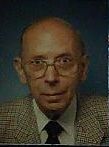
“Jan Langeveld” 1992
A few days later he was back again and now with the message: Indeed, the young man, unmarried, is willing to come. He is a Jew and will come under false flag. Ideally, he would have a living within the company so he would not have to go outside. In 1942 the preparation is ready. the carpenter separated and shielded already a room behind the storage, where the diver could live. I did not know his real name and I did not want to know it. To me he was Jan Langeveld as featured in his ID certificate, which made a poor impression. It was treated with an eraser so that the surface was damaged. Something to attract attention at the first check.
After Jan Langeveld was already installed in our company and no one of the staff, who had come from the glass palace to the Geleenstraat with machines etc., had any wonder about the new manager (after all, a new company also has new people) both my diver and myself were somewhat relieved.
Since a vicar in Heerlen had problems with the clothing of his hiding fellow human beings, we got in contact with him. We were able to help him with his clothing problem and he promised to do something for me with the papers of our hiding man. This vicar was "Giel" Berix. The “diving work” of this vicar didn’t have contact with the national resistance yet. He and his people tried to help whereever it was necessary. Only 1943 the whole was organized on a higher level and taken to a countrywide network, with the participation of two vicars from Venlo and primarily an elementary school teacher Jan Hendrikx, alias Ambrosius. And so I became a member of the resistance so to speak from one occurrence to the next one, in the beginning as the man for the clothes of the hiding people and later as a subdistrict leader (of Valkenburg and surroundings).
If one suddenly would have asked me: come on, join in … then I maybe wouldn’t have had something to do with it, after down-to-earth consideration, and because of the dangers of a married man with children and a company with people who also would be in danger, to lose their jobs. Now I was driven into it. I accepted it and knew that it had to be that way.
At Schunck’s home

For Pierre Schunck, it was logical to do laundry for the German army. This was similar to the camouflage of the municipality official Freysen with his brown shirts and German-friendly chatter, while working at the distribution office of Valkenburg for the underground organisation L.O. During the war, our parents couldn’t always hide their opinion in front of the children already living. And so they took over this opinion, without any idea of the possible consequences.
The German soldiers who served in the occupied territories, were often less fit or older people who were not suitable for use on front. (At the end of the war that was quite different: so many soldiers had died that even boys and old men were sent into the battle.)
One day the two oldest children played outside. It was beautiful weather and the windows were open. An older soldier came to bring the laundry of his unit and saw the playing kids. He asks little Jan in an attempt to speak Dutch: “Well, kid, what’s your name?” “Jantje!” “And would you give me a hand?” Oh, no way! His older sister impossibly could allow this. “Give that Rotmof no hand!”
My mother, who heard all this behind the open window, thought to sink into the ground. Now everything would come out! But the soldier didn’t take offence at it and went on. He probably was just a nice man, who was thinking of his own children or perhaps grandchildren.
One day my father received the command to come (to Maastricht?) and to report to officer Suchandsuch of the german army. He had no idea what about it was. He washed for the army, but for that he never had to come to the barracks. Maybe it was about his candid little daughter? Then he maybe would get only a scolding, that he’d have to educate his children better. Or, which would be of course much worse, maybe someone had charged him? It was still about work for the laundry? Maybe it was better to go underground? No, because if it would turn out to be something harmless and he wouldn’t come, then he probably would wake up sleeping dogs. In addition, the employees would lose their jobs and thus, even his own family would sink into poverty.
He went full of doubts.
“Well, so you are Herr Schunck. Just tell me something. Your name sounds so German. Where is it actually from originally?”
“From Kettenis near Eupen. People speak German there.”
My father studied for a while in Aachen and was fluent in German. That and his descent from a German-speaking region, which had been annexed by Germany by then, made the officer decide:
“But then you are an ethnic German! Then I wonder why you didn’t already voluntarily report a long time ago for the eastern front!”
So that was it. That was a weight off my father’s heart. The relief made him eloquent. He declared that of course he would like to, but that he had a less heroic, but nevertheless not less important role to play. Finally he had to wash for the German army? And in addition, the income of a number of families depended on his laundry.
The mine strike

De overgang naar het grootschalige georganiseerde verzet waren de April-meistakingen, die in Zuid-Limburg vooral een mijnstaking was en dus ook zo wordt genoemd.
Op Wellerlooi, verzetsmonument lezen wij: In 1943 werd door ‘Wehrmachtsbefehlshaber’ generaal F. Christiansen aangekondigd dat 300.000 Nederlandse militairen alsnog in krijgsgevangenschap zouden worden afgevoerd. Als protest tegen deze maatregel brak spontaan overal in Nederland de April-Meistaking uit. Nog voordat de officiële bekendmaking in de avondbladen van donderdag 29 april 1943 verscheen, werd dit nieuws met hoge snelheid verspreid door heel Nederland. Diezelfde middag besloten verschillende personen van particuliere en overheidsbedrijven en instellingen in Twente te gaan staken. Ook in de Limburgse mijnstreek werd het in de loop van die middag onrustig. Lees meer …
Communiqué of the High Führer of the SS and the police of the provinces of Limburg and North Brabant on the death sentences related to the strike in the mines from April to May 1943.
On July 1, 1946, a mass grave containing seven bodies was discovered in Wellerlooi (municipality of Bergen) on the Wellse Heide (now the nature reserve Landgoed de Hamert). There an oak wood cross stands on a red brick wall, the resistance monument, as a permanent reminder of the seven resistance fighters Han Boogerd, Bob Bouman, Leendert Brouwer, Pieter Ruyters, Reinier Savelsberg, Meindert Tempelaars and Servaas Toussaint, shot in connection with the strike in 1943.
In the Dutch coal mining area this strike was called miner’s strike. The actual mining area stretched from Geleen to Kerkrade, but a not inconsiderable number of miners lived outside of it, for example in Valkenburg. In Maastricht, the strike was initiated by government employees. Later bank staff joined in. When the postal workers also wanted to go on strike, the members of the nazi party NSB present forced them to continue working with all sorts of threats. Long queues of people immediately formed in front of all the counters, wanting to buy one single 1-cent stamp. This way the post office was closed too. The factories also joined.
In the beginning there was a party atmosphere. People flocked to the pubs and didn’t suspect (or didn’t want to think about it) that the occupiers would of course not tolerate this and that there would be victims. These events made it clear that attempts to lure the Dutch with the status of an “Aryan brother nation” had failed.
The miners’ strike was part of the strikes of April-May 1943. The background was the return of Dutch soldiers to captivity, planned by the occupiers, to be put to work in the German war industry. They were the transition to a more massive resistance movement throughout the Netherlands, including the province of Limburg. The strikes were brutally suppressed, but the resistance organizations gained more new members (perhaps even because of this?). For the majority of Dutch Jews, however, it was already too late. :(
Zie ook het artikel: als de mijnwerkers staken tegen de Duitse bezetter. Met name de harde repressie, waarmee de bezetters deze staking te lijf gingen, opende velen de ogen. In dezelfde tijd namen ook de deportaties van joden steeds massalere vormen aan. Niemand geloofde meer in een humane bezetting, de verzetsorganisaties kregen toeloop.
Organised Resistance

in Limburg and Valkenburg - and the role of Pierre Schunck in it
The first organized resistance was based on demobilized soldiers. Like the clergy, they had the advantage of knowing each other well before the war. In Limburg this is the origine of the groups of Erkens, Dresen and Bongaerts. The Maastricht citizen Nic Erkens (DB) had contacts with resistance groups in Belgium. The Valkenburger Jan Joseph Rocks (DB) was also part of this group. Nic Erkens went into hiding in guesthouse Rocks, the later Park Hotel Rooding. They fell into German hands by infiltration through the Hannibalspiel of the German Abwehr (counterintelligence).
Some residents of Valkenburg and surroundings began already in 1941 with the help of first divers. A. C. van der Gronden (DB), a brother of G.J. van der Gronden (DB), who was detained on 13 January 1942, helped Jews and communists with accommodation in collaboration with rector G.A. Wolf (DB) from Sibbe. End of 1943 they joined the LO, subdistrict of Valkenburg. Carelessness and talkativeness of the diver A.S. Bron resulted on 17 February 1944 in the arrest of Wolf, Bron and the hidden person Th.M. van Santpoort. Wolf was released for lack of evidence after ten days and van Santpoort after several months. Bron was deported and survived the German camps.
During the farewell ceremony of his companion “Paul”, Theo Goossen (resistance name: Harry van Benthum) made a speech in which he described the activities of Paul, but also of the entire L.O. :
His acting mainly was aimed at assistance to people in trouble:
- To destitute families, whose husband and father had to flee, had gone into hiding, or was confined in jail or in one of the atrocious concentration camps.
- Organising accommodation and hiding places for refugees, for Jews, for crashed allied pilots, for Resistance people wanted by the police, etc.
Those people all needed nourishment, clothing, ration-books, identity cards, ration-coupons etc. - The realisation of this help demanded organisation, consulting together, intensive cooperation etc., and all this inconspicuously and in secret!
“Paul”’s own business interests again and again were interrupted by the distress of other people. This situation requires too: looking out, being carefull and acting inconspicuously. ALWAYS in the hope, to be able to evade the danger (though hidden, but always present). In this atmosphere we have to look at “Paul”’s more than 2 years lasting organised resistance activities.
In addition we have to take into consideration: several times he was in real peril of his life.
In his own words:
“I don’t understand. I cannot explain it. I was very lucky! But I prayed a lot!”. And he adds: “I didn’t do all this alone. And without the support by my wife lots of things would have gone totally wrong.”
The necessity to help the many people who went underground, Jews, crashed allied pilots, and former Dutch soldiers escaped from camps for prisoners of war, stimulated the need for more unity. Smaller opposition groups went to work in a larger context, namely in the L.O. (The national organization for help to people who went underground). They divided Limburg into 10 districts. Apart from this organization the “knokploeg” (task force, thug troop), called K.P. briefly, was set up. They got hold of ID papers and food ration cards, frequently under use of force. As of the end of 1944 the complete K.P. in Limburg was under the management of Jacques Crasborn from Heerlen.
After some time in Valkenburg a K.P. was created, too. It initially consisted of two men, the teachers Jo Lambriks (DB) and Jeng Meijs (DB), whose first had Jacques Crasborn as a pupil in his class some years before. Later Georges Corbey (DB) became the third member of the KP (fighting team) Valkenburg. The name evokes a violent thug gang, but most of the KP people were not combative, though of course sometimes they didn’t shrink from a forceful action, if necessary. The task of the KP was no other than to ensure the livelihood of people in hiding. (The L.O. provided the distribution). They gathered materials, illegal reading, ration stamps & cards and sometimes even German uniforms for use on the occasion of robberies. Most activities took place during the night.
Leader of the L.O. in Valkenburg was Pierre Schunck. Among others, Harie van Ogtrop (DB) and Gerrit van der Gronden (DB) were members. Of course there were more people, up to municipality officials, who cooperated now and then under a complete discretion. Thus it were the municipal officials Hein Cremers (DB) and especially Guus Laeven (DB), who ensured at the end of the war that the entire register of the registry office of Valkenburg “somehow” got lost, when the Germans had the idea to force all male inhabitants between 16 and 60 years old to dig trenches.
The organized resistance in Limburg started in the city of Venlo, in February 1943.
Here it is about the resistance organized at the provincial level. At the local level, individual acts of resistance were made since the beginning of the war, as listed above and others. This resistance achieved a continuously rising higher level of organisation, which finally resulted in the Limburg branch of the L.O.
A primary teacher there, Jan Hendricx (alias Ambrosius), became the leader of the L.O. in Limburg, supported by father Bleijs (alias Lodewijk) and chaplain Naus. The soul of the Limburg resistance was L. Moonen (alias Uncle Leo), the secretary of the diocese. By his help they established the necessary connections all over the diocese in short time so that Limburg had a well established resistance organization by the end of the year 1943.
The historian Christine Schunck, daughter of Pierre Schunck, writes: “Lou de Jong wanted to pull already late 1944 information from resistance people in Limburg, when the front was still quite close (think of the Battle of the Bulge). The leaders of the South Limburg resistance did not want to reveal any names and deeds. De Jong never returned after the war to get additional information, but simply wrote that the resistance in Limburg would have presented not too much. Luckily Dr. Cammaert has done a very thorough research with a light emphasis on Middle-Limburg, where his roots are.”
Because de Jong, not wrongly, is considered the most important authority in the field of the Second World War, many copied from him, so that also …
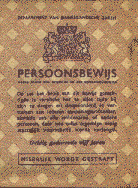
ID card
… in and around Valkenburg, nothing significant happened in this regard. The small private archives of Pierre Schunck (alias Paul Simons), one of the resistance fighters in Valkenburg surviving the war, prove the opposite. Not only his personal report with notes and pictures shows this, but also a number of genuine and forged ID cards, ration coupons, notes of underground people with secret messages (“from Z18 to R8”), illegally printed and stenciled matters, lists of official aid to war victims during the occupation, a file on Jewish victims.
Here are the testimonys on organized hiding aid in the region of Valkenburg during the years of German occupation, on the assistance to crashed allied pilots, the attack on the registry office, which made the deployment of men from this subdistrict in the German production process largely impossible; on the large scale manipulations of distribution records, which made it finally necessary to raid and plunder the distribution office in Valkenburg, so that falsifications not should come to light; on emptying a warehouse of radio equipment in Klimmen; on the hiding of precious liturgical vessels and chasubles from the Jesuit monastery in Valkenburg; on incidental stunts as the pillaging of a railway carriage full of eggs (decorated with a banner: “A gift of the Dutch people to the German army!”) and of a ton of butter from the dairy in Reymerstok.
This dairy worked for the Wehrmacht. With actions like this the German uniforms and the army vehicle mentioned below were very useful. The prey benefited particularly the hospital in Heerlen, where many divers were treated secretly.
Since a chaplain in Heerlen had problems with the clothing of his hiding fellow human beings, we got in contact with him. We were able to help him with his clothing problems and he promised to do something for me with the papers of our hiding man. This chaplain was Giel Berix. The “diving work” of this chaplain didn’t have contact with the national resistance yet. He and his people tried to help whereever it was necessary. Only 1943 the whole was organized on a higher level and taken to a countrywide network, with the participation of two chaplains from Venlo and primarily an elementary school teacher Ambrosius, alias Jan Hendrikx. And so I became a member of the resistance so to speak from one occurrence to the next one, in the beginning as the man for the clothes of the hiding people and later as a subdistrict leader (of Valkenburg and surroundings) .
If one suddenly would have asked me: come on, join in … then I maybe wouldn’t have had something to do with it, after down-to-earth consideration, and because of the dangers of a married man with children and a company with people who also would be in danger, to lose their jobs. Now I was driven into it. I accepted it and knew that it had to be that way.
Redistribution

Clothing for “divers”
I got in contact with chaplain Berix by the company. Because Berix tried to get clothing for (allied) pilots and divers here. He asked for overalls. I say: “Whom for?” “I can not say for whom. Just for poor people”, he said.
He asked for a rather large quantity, so I say: “If it is for the poor, I have to discuss that with Distex.” But he found that a bit dangerous.
It concerned his lack of working clothes for students who went underground at farms (1942). Giel offered, in return for my support in this matter, to provide identity papers and food bills for the Jewish hiding man in the company S.K.I.L. in “the mill” in Heerlen.
I had a Jew as a manager here, who was hiding under the name Langeveld, and he lived here as an Aryan.
We came to an agreement: the costs for the overalls with regard to consumption of material and paid-out wages would be paid by Berix from a fund of the diocese (fund for special needs).
It turned out that the required materials which Distex delivered in large quantities came from textiles from confiscated Jewish enterprises which had been given to Distex to redistribute. Distex didn’t write a bill and so the resistance movement didn’t have to pay for these deliveries. Since Mr Hogenstein of the Distex central store in Arnhem took the redistribution literally, which means from Jews to Jews, he emphasized that Jewish hiding people should have priority at the apportioning of clothes.
Then, Berix asked me, if I did ever something illegal. I said: "Yes, a bit. "
He probably had already the plan to organize the subdistrict of Valkenburg. I replied that I actually brought underground some paraments and golden chalices and books from the monastery of the German Jesuits in Valkenburg, who were driven out by the Reichsschule (school of the SS) , put together some car loads.
Berix found all that very interesting and nice and then he gave me the proposal to bring more people to Valkenburg, because he assumed that there were good opportunities to hide people in Valkenburg and surroundings. (I live in Valkenburg).
Founding of the L.O. district Z18 (Heerlen)

The time was ripe to join forces. An important impulse came from the hospital in Heerlen, where people were gathered for whom commitment to others, a common view of life and trust in each other were a matter of course. More details about the hospital below.Theo “Harry” Goossen (DB), as sub-district leader of Kerkrade one of the co-founders of the district of Heerlen, said during the funeral of “Paul” Schunck (DB):
Curate Giel Berix (DB) from Heerlen, a friend of “Paul”’s and one of the founders of the L.O. in Heerlen, became after the retirement of Rector Prompers (DB) by some good reasons and according to his own wishes, the leader of the district Z18. The district of Heerlen was divided into 9 rayons.
The present Mr. “Paul” became the leader of the subdistrict Valkenburg. The activities of this group stretched away to and reached Gulpen and Maastricht. Also Klimmen and environs were incorporated with the subdistrict Valkenburg.
During several secret meetings and the necessary cooperation they got better acquainted with each other and some learned a little about each other’s familiar situations and even surnames.
“Paul”’s family name was Schunck, he lived in Valkenburg, where he had a laundry. There his wife Gerda was playing an important part too. At set times you could find “Paul” in Heerlen in a clothing factory at the corner Kruisstraat-Geleenstraat.
The resulting contact between the rayon of Valkenburg and the district of Heerlen was uncomplicated, because I was in Heerlen at work every day.
Furthermore we agreed that no hiding persons should be referred to the company but that the need of clothing should be transmitted for them by couriers.
More complicated need of clothing used to be regulated by the director of the municipal social welfare office, Mr Cornips (DB), with me. He was very competent for this due to his function. It was predominating about suits, clothes, coats etc. for families being hidden as a whole (primarily Jews) and suits and coats for prisoners of war (primarily Frenchmen) and pilots.
I had to deal personally with heavily solvable problems e. g. with a very thick Franciscan monk, friar Beatus (DB) and also with a very tall one, friar Amond. There our work had to to be made to measure.
The son of this Constant Cornips was Jan Cornips, the secretary of district leader Berix of the Heerlen resistance.
Read more about the great networker friar Beatus van Beckhoven on the Dutch Wikipedia
The “diver’s inn” in the Caves of Meerssenerbroek

From Pierre Schunck's interview with the Auschwitz Committee:
Since the thirties my father exploited a lime quarry (Near the Meersenerbroek between Geulhem and Meerssen, Open Street Map.) The lime was crushed to small pieces and sold to the farmers as a fertilizer. The director of this company was Heinrich S., a German mining engineer, who lived in Holland. However, his main activity concentrated on a quarry with natural stone trade in Kunrade, in the possession of my father as well.
Until May 1940, this brother-in-law had always given the impression on us to stand extremely hostilely opposite the Hitler regime. We were therefore very astonished to hear that he had been appointed "ortsgruppenführer" (local group leader) by the German nazi party in Heerlen and that he had got a controlling function in the common mines in Limburg as a secretary of the German pit administrator.
In 1942 I heard from chaplain Berix (DB) that a chaplain in Meerssen (DB) was hidung two boys who were looked for by the Germans in the cave belonging to my father. Information confirmed this and I was allowed to pay a visit to these boys. The chaplain swore me, that he knew everybody of the staff of the lime works, and that each one of them was completely reliable. But he didn’t know that the boss was a German party functionary.
In fact, that was the foundation of the rayon (subdistrict) of Valkenburg and they were my first divers. This was done in consultation with chaplain Geelen. (DB)
Here Pierre Schunck leaves the Dutch soldiers out of consideration, that he sent on their way home in the first days of the occupation after they had been waiting for a while in Valkenburg on the tourist season. See above.
Luck played in our favor. My father was in conversation with Heinrich S. about the top-level position of the enterprise because of his workload on the pit and in the party. I knew a student graduated recently in Leuven, he now was an agricultural engineer. He was a brother of one of our priests in Valkenburg, and he was called graduate engineer Horsmans (DB). I asked him whether he would feel like, temporarily, taking on the work of my brother-in-law in the Meerssenerbroek (as long as the war would last). My father and Mr Horsmans reached an agreement.
Berix and I had come onto an idea for these caves in the meantime.
First the guys of chaplain Geelen were in there. But you can not stay longer than three months under the earth, then you have to go again into the fresh air. So in my opinion it would the best idea, to install a diver’s inn there. We accommodated the guys of chaplain Geelen in Schin op Geul at a farm (we took them over completely).
So the cave became a diver’s inn, and if I happened to have no place free and I got but new entries, then I said: “Just let them come”, then I put them in the cave, and they were sure for a while.
Building up the “diver’s inn”

On the basis of a map, Pierre Schunck shows an American soldier the tunnel system in the Dölkesberg.
Photo: Dwight W. Miller
Source: https://nimh-beeldbank.defensie.nl/beeldbank/
Our young organization was absolutely dependent on its own efforts to offer places to hide to people pursued by the enemy. We were not yet associated with a nationwide organization (the L.O.) and it was even still unknown to us (until 1943). Given the tense situation at the universities and the raids after Jews in the North, Berix (DB) feared that we suddenly would have to manage large groups of people. Such a cave would fit exactly as a temporary refugee accommodation. Enquiry among the staff in Meerssen, about the behaviour of S., showed in response: "We only see S. visiting quickly the office, the lime kiln and the open pit quarry. He never enters the underground caves and he also doesn’t know his way around there."
Chaplain Berix found it rather positive that a German party functionary who didn’t know his way around in the cave was the director. The German authorities would never become suspicious against this place.
In the winter of ’44–’45, Pierre Schunck and a comrade play for a film team of the American army how a person is brought into hiding to the Diver’s Inn
In the middle the remains of an old lime kiln, to the left and right of it entrances to the mine. In the area in front of it are still the foundations of the lime works after which this cavern has been named: “Behind the Lime Works”.
There were two caves, completely independent of each other. Coming from Valkenburg, the first cave was behind the lime kiln. It was built in the 20th century, very regularly like a chessboard, in the way of a modern “block breaker quarry”. The only entrance was accessible and visible to everyone. The second cave was below the fruit meadow of my father’s and was not used for the limestone extraction anymore. Its entrance was (and is) almost completely concealed by bushes, only accessible by a steep slope. In front of the entrance was the cottage of Sjir Jansen (DB), a very simple man but a great guy, through and through reliable. In the past this cave was used by the Montfortan fathers from Meerssen. On days off their pupils came to paint wall pictures and they also made a fun to imitate a chapel in the way like they are still found from the French time in the caves of Valkenburg and Geulhem.
This chapel was built by theology students, especially inspired by the nearby underground clandestine church in Geulhem, built during the French occupation by Napoleon.
Photo: Dwight W. Miller
Source: https://nimh-beeldbank.defensie.nl/beeldbank/
Film
We choosed this cave to be our “diver’s inn”.
It wasn’t our intention to set up a durable place of residence for hiding people here. It nevertheless still had to get a bit more comfortable. Firstly, it was rather damp. The temperature is there only durably 10° to 12° degrees Celsius all the year round, just a little too cool to feel well. Berix knew a solution for it. A long electric cable was put to the hiding-place by employees of the coalmine Oranje-Nassau. By arrangement of another Berix acquaintance, a technician of the electricity supplier PLEM installed a safe electric heating, light and an electric cooker. I found electric cookers, light elements and electric heaters in the Jesuit cloister as well as dishes and kitchen utensils. The cable was attached directly to the net without an electricity meter in the control cubicle of the lime kiln.
Furthermore there had to be a escape opportunity, for if the entrance would be blocked by the enemy. It was created by scraping out a doline, a loam tube which led into the Berger Heide (Berg Heath) and which should remain disguised well by the brushwood.

We also had to supply warm meals for the hiding people. Later, in the L.O. time, food coupons were no problem. But at the planning time, we couldn’t yet fall back upon them. Of the food which actually was intended for the children’s eating house in the laundry, my wife put the required part aside and cooked the meal for the cave with that. On weekdays the van of the lime works fetched this food with us and at the weekends I had to take care of it with the bicycle.
Jan has been in there. (Jan Cornips, the secretary of our district leader in Heerlen.)
The district leaders lived there for a while, and people from other districts. I provided them well with good food, even wine and playing cards and my radio stood ready. There was electric light, that was all right.
Berix (DB) and I organized the needed cable at the muncipal services.
In the interview with the Auschwitz Committee, he speaks of a cable from the mine Oranje-Nassau. Possibly, they did not have enough with one cable, because the distance to the switch cabinet was too long.
We organized the mattresses with the nuns of the hospital. That was easy! One evening my wife (DB) got an order for blankets and so I went looking for mattresses as well. We went to Heerlen, where we were able to take some blankets at the company (Fa. A.Schunck). But they had no mattresses. I talked about it with Berix, and asked him, “Couldn’t we get a licence for that in the hospital?”. Then Berix said: “I was there for a visit some days ago, and if you look around there, there is a hallway and there is one mattress next to the other.”
I went there immediately with Berix. The housekeeping nun asked: “What do you want?” “Well, mattresses” we said. She said: “Just take them if the chaplain says it is all right. There they are!”
And we started to carry them away.
But at about ten o’clock the sisters came back and wanted to go to bed. They used to air the mattresses on the floor and we had taken them now!
But in any case, the boys in the cavern had mattresses to the sleep on now.
There, we had about 20 flatbeds. We originally designed the whole thing for pilots because the pilots were a problem for us. They had to be dispersed, and someone came up with the idea: “Why don’t we hide them in a cave?” We set up this thing then. We had the famous family F[****] in there with 9 married men from the same parents. They came from Poland, and they refused en-bloc to join the German army. I had seven of them myself. I made them dig out a cave that was not yet known. With emergency exits, electrical lighting, radio, bath, a sink, a paraffin stove for cooking etc.
This was the pilot’s cave. It is used only by the workers who set it up. We measured the cave to find out the most convenient point for an exit to the forest. We shocked there an old woman who was searching for acorns. Suddenly someone came out off a hole upwards! (We were trying out secret exits).
This was a so-called organ pipe or doline, a Karst phenomenon in the shape of a funnel.
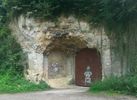
Mouth of the cavern Bronsdalgroeve 2019
Until the summer of 1944 the diver’s inn remained in use. In July of the same year, the Germans shifted some production lines from Philips, as for example the production of radio receivers, from Eindhoven to the bombproof lime caves in the province of Limburg. One of the new sites was in the immediate vicinity of the diver’s inn.
This was about the the Bronsdal cave (Bronsdalgroeve).
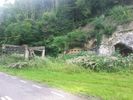
Above-ground ruins Bronsdalgroeve 2019
The flyer published by VVV (tourist office) of Valkenburg for the 75th anniversary of the liberation in 2019 states: From the summer of 1944 a factory of the Philips Valvo Werke from Aachen was established in the Heidegroeve. There 900 (forced) workers worked on the production of radio receiving and transmitting equipment for the experimental (Junkers) JU-388 aircraft. …
From the spring of 1944 the Germans started making the underground Bronsdal limestone quarry suitable for housing a war factory, where about 250 BMW 801 aircraft engines had to be overhauled each month.
That seems more plausible because Aachen is closer than Eindhoven. The Heidegroeve is a few kilometers away, on the Plenkertstraat in Valkenburg.
Go to Streetview to see what is still remaining above ground of the production plant in front of the Bronsdal cave
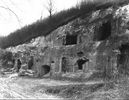
1932, Bronsdalgroeve
March 25th, 1932. The limestone caves Bronsdalgroeve and the Vlaberg on Geulweg, Meerssen-Geulhem. Towards the end of the war, in this subterranean part of the limestone quarry a German workshop for the revision of aircraft engines was set up here. In the vicinity of this underground part of the limestone quarries was the provisional hostel for people to hide (“divers inn”).
The youngest sister (Carla) of Pierre Schunck told that once their father Peter, the owner of the quarry and the cave, should guide a group of Germans through the enterprise. He knew about the divers inn. When the Germans wanted to visit the cave too, he struck with a stick a few pieces of limestone from the ceiling and said, “We can not go on here, because of the risk of collapse!”
Suddenly the Germans wanted to get out and never came back again.
Source of the picture: Historisch Centrum Limburg (HCL)
Coen Grotaers

The following story needs a little explanation.
- It was sent to me from Australia by a son of Coen Grotaers, see below, who was involved in the resistance in the limestone quarry too.
- There were two limestone quarries in Geulhem at the Geul near the Meerssenerbroek at that time. One of them was property of Peter Schunck, the father of Pierre Schunck. One part of it was a far branched cave system. There the diver’s inn was installed. The other quarry belonged to the Wim Curfs mentioned below.
- The following story is probably about „Ausweise“ (ID cards) which had been looted at the raid on the distribution office in Valkenburg. Let’s hope that after that accident somebody went once again with new cards to Kaldenkirchen.
- The methane gas of which he writes, was no wood gas, although only the german army (Wehrmacht) had gasoline. The wood carburettors to produce it were not harmless. A small factory was attached on the tail or on the roof of the vehicle. There the wood was heated up. Wood gas and tar were among others the results. So one didn’t tank but one put some new logs on. Usually one loaded the system, when it was cold. But during a long journey, when the system was hot (because otherwise it wouldn’t work) it could catch fire. But this is not what happened here, writes the son of Coen Grotaers. His father drove a truck powered by methane gas from the factory. Probably a product from the coke oven at the pit.
- This mail shows too, that there were contacts with German resistance groups.
- For a better understanding of this story, you should read also the part of the interviews with Pierre schunck, in which he tells about the resistance activities in the Duikherberg.
Hi, to whom it may concern.
My name is Victor Grotaers and I live in Australia, north-east of Melbourne.
My Father (Coen Grotaers) was part of the group in the Dölkesberrig (Duikherberg) in Geulhem and also worked for Peter Schunck in the mergel-groeve where he operated the steam powered drag-line crane from about 1943 till about 1946, which was used to mine the mergel and load it onto trucks. (This dragline had a 2 cubic meter bucket and I know it was steam powered because I used to go with him sometimes and would have to sit on one of those large brick-shaped compressed coals that went into the boiler!)
I have seen some accounts of the resistance movement on the Internet and recognised a lot of names from their accounts of what our parents had done during their activities in the movement.
Both my parents were involved in the resistance movement. My mother used to also cook meals for the „onderduikers“ and hide these in a false bottom in my pram. Myself and my younger brother Peter were the decoys! (I was born in 1942) (We used to live in the first house up the top of the Bronsdalweg in Berg en Terbijt)
On one occasion my Father was driving a truck (I don’t know if it belonged to Schunck or Wim Curfs). He had to go to Kaldenkirchen in Germany with 172 false "Ausweisen" to get people out of that concentration camp. The truck ran on Methane gas. After filling the truck in Sittard something went wrong and the truck severely caught fire, Dad was badly burned but survived. This happened on the 15th March 1944 the day before my brother Peter was born.
My Father died here in Australia in 1979.
I would love to know if there is any records and photo’s in the archives that corroborate our parent’s involvement in the resistance movement.
Many Thanks, Victor Grotaers
Remark: Do you have any information on the Grotaers family? Please get in touch with me, I then will pass it on.
09/08/2019
Hi Arnold,
Reading through that article pertaining to the Duikerberg. It talks about an escape route in case the Germans entered the Duikerberg. I remember another line of defense that was in place that dad often talked about. There was a tin with a supply of little sponges which had been wiped on the backsides of dogs "on heat". Whenever any Germans came around to search the caves with their tracker dogs, someone would scattered these small sponges around which then rendered their dogs useless.
Victor
One unit in every village

The following story needs a little explanation.
- It was sent to me from Australia by a son of Coen Grotaers, see below, who was involved in the resistance in the limestone quarry too.
- There were two limestone quarries in Geulhem at the Geul near the Meerssenerbroek at that time. One of them was property of Peter Schunck, the father of Pierre Schunck. One part of it was a far branched cave system. There the diver’s inn was installed. The other quarry belonged to the Wim Curfs mentioned below.
- The following story is probably about „Ausweise“ (ID cards) which had been looted at the raid on the distribution office in Valkenburg. Let’s hope that after that accident somebody went once again with new cards to Kaldenkirchen.
- The methane gas of which he writes, was no wood gas, although only the german army (Wehrmacht) had gasoline. The wood carburettors to produce it were not harmless. A small factory was attached on the tail or on the roof of the vehicle. There the wood was heated up. Wood gas and tar were among others the results. So one didn’t tank but one put some new logs on. Usually one loaded the system, when it was cold. But during a long journey, when the system was hot (because otherwise it wouldn’t work) it could catch fire. But this is not what happened here, writes the son of Coen Grotaers. His father drove a truck powered by methane gas from the factory. Probably a product from the coke oven at the pit.
- This mail shows too, that there were contacts with German resistance groups.
- For a better understanding of this story, you should read also the part of the interviews with Pierre schunck, in which he tells about the resistance activities in the Duikherberg.
Hi, to whom it may concern.
My name is Victor Grotaers and I live in Australia, north-east of Melbourne.
My Father (Coen Grotaers) was part of the group in the Dölkesberrig (Duikherberg) in Geulhem and also worked for Peter Schunck in the mergel-groeve where he operated the steam powered drag-line crane from about 1943 till about 1946, which was used to mine the mergel and load it onto trucks. (This dragline had a 2 cubic meter bucket and I know it was steam powered because I used to go with him sometimes and would have to sit on one of those large brick-shaped compressed coals that went into the boiler!)
I have seen some accounts of the resistance movement on the Internet and recognised a lot of names from their accounts of what our parents had done during their activities in the movement.
Both my parents were involved in the resistance movement. My mother used to also cook meals for the „onderduikers“ and hide these in a false bottom in my pram. Myself and my younger brother Peter were the decoys! (I was born in 1942) (We used to live in the first house up the top of the Bronsdalweg in Berg en Terbijt)
On one occasion my Father was driving a truck (I don’t know if it belonged to Schunck or Wim Curfs). He had to go to Kaldenkirchen in Germany with 172 false "Ausweisen" to get people out of that concentration camp. The truck ran on Methane gas. After filling the truck in Sittard something went wrong and the truck severely caught fire, Dad was badly burned but survived. This happened on the 15th March 1944 the day before my brother Peter was born.
My Father died here in Australia in 1979.
I would love to know if there is any records and photo’s in the archives that corroborate our parent’s involvement in the resistance movement.
Many Thanks, Victor Grotaers
Remark: Do you have any information on the Grotaers family? Please get in touch with me, I then will pass it on.
09/08/2019
Hi Arnold,
Reading through that article pertaining to the Duikerberg. It talks about an escape route in case the Germans entered the Duikerberg. I remember another line of defense that was in place that dad often talked about. There was a tin with a supply of little sponges which had been wiped on the backsides of dogs "on heat". Whenever any Germans came around to search the caves with their tracker dogs, someone would scattered these small sponges around which then rendered their dogs useless.
Victor
The contact people between the sub-district leaders and the people in hiding (“onderduikers”, divers) were called duikhoofden, diver’s chiefs.
We had a diver’s chief in each parish. Our thing was organized by parish.
They could take as many helpers, as they wanted to, but I had to know who it was, and then I inquired about them. This may have been wrong, but I thought that the strongest chain can be broken by a weak link and so I didn’t want to take any risk. Before anyone was given a job, I had to know about it. In fact, that protected us from the outset.
He engaged the following persons on as a duikhoofd: chaplain W.B.J. Horsmans (DB) and verger H. van Ogtrop (DB), supported by J. Peusens and J. van de Aa, in Valkenburg; J. Hendriks (DB) in Berg und Terblijt; F. Schoenmakers (DB) in Sibbe; J. van de Laar (DB) in Margraten; A.H. Laeven (DB) in Schin op Geul; L. Horsmans (DB) in Houthem-St.Gerlach and A. Caldenborg (DB) in Houthem. W. Cremers (DB) and the Peusens sisters (DB) worked as couriers. For the time being, the “rayon” of Valkenburg remained independent. J. Starmans (DB) maintained the relations to the other districts.
Anton Laeven, son of the diving head of Schin op Geul mentioned above writes: “As a member of the L.O., Albert Laeven has taken on a number of resistance activities. The most important thing was finding hiding places and then accommodating those “divers” there and taking care of them. This included, among other things, the delivery of ration cards, which were handed to him again via the large organization. Furthermore, identity cards had to be changed (forged). This also applied to company passes and so-called Landwirtschaftsausweise (agricultural ID cards) for people in hiding who worked for farmers. These forged passes were issued by employees of the “Willem-Sophia” mine (where he worked). Albert therefore regularly took forged papers from his work, whereby his fiancé Louisa Bosch was engaged to deliver them to Harrie van Ogtrop (DB). Albert has been able to place no fewer than 34 people in hiding in and around Schin op Geul. He asked and prayed at sixteen addresses to take people. This of course did not always work and it was difficult if people refused to hide somebody at the last minute. On the other hand, this indicates that many people in our village knew that Albert cared for people in hiding, but that treason was never committed.”
Turkish passports

The district leader first had contact with the clergy of the parish, and from there he got the tips about any going underground of boys from Valkenburg.
Then he (the duikhoofd) gave me the addresses of the guys who wanted to dive. Usually, I already knew the boys and knew about their reasons. These were mostly good national reasons. I gave these addresses to Jan Cornips and then he prepared a diving place for them.
Then I prepared Turkish passports [and brought them to the] chapel in Klimmen, and they would take care of the rest. Usually it was [Bessems], who did so. Normally it was him who brought the guys away. Then we had got rid of them.
But on one we accommodated, 10 new came in, because it was a rural community here.
What are the Turkish passports mentioned above?
We find the answer at the https://www.stiwotforum.nl/:
Vin1: Hi Everybody,
I am now reading the book by Hans Poley, “Terug naar de Schuilplaats” (Back to the hiding place). There a meeting between couriers of the resistance from different districts is described, to pass messages to each other. He writes about checking each other’s “Turkish Pass”. If that was good, they did business with each other (exchanging messages or coupon cards, etc.) and then quickly disappeared again.
Does anyone know what is meant by a “Turkish Pass”?
(for those who have the book, it is on page 121)
Thanks in advance
Jeroen: Suppose we make an appointment and do not know each other at all, then you can split a banknote in half and make sure you both have one part. When you meet, they have to fit together.
… but I do not understand what’s so “Turkish” about it.
Wilco_Vermeer: I’m not sure, but I think, the term dates back to World War I or earlier and had something to do with an identification method in Ottoman intelligence, but I can be completely wrong, I have got that really deep in my memory and can not find any confirmation for it.
District Leader Berix

Due to the contact between Berix (DB) and Schunck, soon the first divers could come from Heerlen to Valkenburg.
The contact with the leaders of the district was Berix. Soon we were close friends, not a day passed that we didn’t see each other. This way, the contact was quite easy. So once per period I brought him our remaining ration cards. Klimmen was supplied directly by us, that was Bep van Kooten’s village (The future Commander of all KP groups in Limburg) . And Berix got the rest of the ration cards for distribution on places in the district that had no distribution office.
When he had to go into hiding, Berix moved to me, so the contact grew still closer. So now the district leader lived in my house. He was called Mr de Groot now and wore a wedding ring, and ran a men’s bicycle. As a chaplain he was not used to drive a men’s bicycle and he always beat his legs against the rod!
My staff thought he was an old study partner of mine who had to stay here some months for his health, and had not enough money for a hotel. He was regarded as being married and when he came in with me, then it went: “Giel, how are your wife and children?”, what was of course a bit weird for a chaplain.
Also on the phone, I asked first: “Giel, how’s your wife?” and then he told a story that his wife just finished the washing, and that she could not force herself to bring it to the laundry.
He was a cheerful person, always full of good humor.
He left us for fear of my son. Who was 5 years old, and this little guy once said to him, after having watched him exactly: “You are a priest!” He had found a Breviary prayer book of Berix, and he had seen that he prayed, in contrast to dad, always very reverentially before and after the meal, while his father just did it. He also blessed the food always, and my boy had observed this when other priests (who were often with me also because of illegal work). He had remembered that.
After that Berix said to my wife: “Look, a children’s eye and a child’s ear are sharp. I should go, otherwise you just would get into trouble.” I strongly regretted this. However he remained in the vicinity and so we still stood in daily contact.
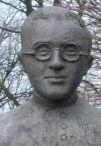
Monument Berix
Meers, monument for J.W. Berix. Source: .
English translation and more information on Giel Berix.
Giel Berix did not survive the war. Dressed like a non-cleric and with fake identity card, he attended 21th june 1944 a top meeting of the province L.O. in Weert. This meeting was betrayed by a man called Vos. Berix and 8 comrades were arrested and brought to the concentration camp of Bergen-Belsen, which they did not survive. Berix died of typhoid fever.
More details on the life and the time in the camp of Jan Willem „Giel“ Berix
The L.O. district of Heerlen 2

Here I should not forget the secretary of our district leader, Jan Cornips, who basically dealt with the daily affairs of the district top, who attended the sessions etc., who divided the divers.
Cornips, student at the »Economische Hogeschool« in Tilburg, had refused to sign the “loyaliteitsverklaring” (declaration of loyalty) and May 1943 he moved to Germany, in order not to endanger his parents. In September, he returned to Heerlen. His father presented him to Berix.
The contact with Jan, I always had at his father’s.
Meetings

In 1943, the organizational framework of the L.O. was completed. In connection with the risks we decided to do without the holding of meetings in the hospital in Heerlen. When a rayon leader found it necessary, small meetings were organized in the apartment of Berix, in the building of patronage, or later in the visiting room of the convent of the Little Sisters of St. Joseph and in the house of the family Seelen. Cornips was the intermediary between the district and the subdistricts. He gave a weekly report to the district council, to which belonged he himself, Berix, chaplain J.J. Keulen, Quint and De Koning. Typically, the meeting of the district council was held a day after the province meeting. Alternately Cornips and Berix visited these conferences.
We regularly had L.O. meetings at district level, which took place directly after the province meeting. Went as a representative of the district either Berix or Jan, and later, when he began to be noticed, it was [?]. They went to the province meetings and then they came back with data for the rayon leaders and they were discussed then.
Ad: Was there a fixed day for this?
Schunck: No. It was about every two weeks, but no fixed date.
Coenjaerts: Those meetings were announced by courier.
Cammaert writes: “G.H.H. Coenjaarts, who worked in the Office of the State Mines, stole over a thousand ID cards of the company for divers. He printed illegal pamphlets and even books at the mine. In the summer of 1944, he threatened to fly up. The entire management of the subdistrict of Heerlen went underground. In the last months of the war Coenjaarts acted as a principal agent in the intelligence service of Goossen in the rayon.” Is that the same person?
Schunck: Later, these meetings were considered a bit too dangerous. At that time Coenjaerts came to stand in for [??], and we met at Jaspers’. Bep van Kooten from Klimmen was there too. In fact we stopped the meetings of the rayon. We said: “We won’t do this anymore, it’s too dangerous”. Ströbel (Chief of the SD =security service of the SS in Maastricht ) was then pretty much behind us.
Female couriers are surer

Schunck: We introduced female couriers. Then the war was nearly over. We communicated that to the heads of the diving cells in the very small circle. That was in Weert, everything went then via female couriers.
W. Cremers (DB) and the Peusens sisters acted as couriers.
That was because the Germans at the roadblocks apparently regarded women as unpolitical creatures and did not control them when they passed by on their bikes. And perhaps many men of the resistance did not feel in very different way about it.
Wielke Cremers was a sister-in-law of Pierre Schunck. He wrote about her:
Then I assigned Ms Cremers as a courier. She cycled to the most high-risk addresses and from her I got notifications on slips of paper. But I found that not a satisfactory solution, because these notes were even more dangerous than the contacts (themselves)!
Since the arrest of Berix (DB), our L.O. district was a bit disoriented. One district leader followed the other. So in fact I had to work in my sub-district indepedantly, I just got no more data and also no divers.
For a while I accommodated some divers from Maastricht, sent by M[emmisman], who was not organized in the L.O., and who finally no longer knew where to go with the people… And there still were the boys who ran away from the Arbeitsdienst (forced labour service) , that had to work for the O.T. (Organisation Todt) , and who went by themselves to farmers in the immediate vicinity. Then these farmers knew who was the (responsible) head of the diving cell.
So our open places were automatically occupied again.
In fact I no longer knew the people who were district leader between July ’44 and end of Aug ’44, because we stood in contact via couriers, and that was a good thing. But I found it wrong that notes were exchanged. People wrote too much.
We monthly allocated ƒ1600 of supports. That was not much, because we had an agricultural municipality and divers, who were accommodated in our subdistrict could work at farms or in hotels. So, of course, they earned their own living. I insisted that if a boy worked for a farmer and he did a good job, then he should get a proper pocket money for it, and if he was a married man, we took measures via the district and that were these ƒ1600,-- for.
In the subdistrict we sometimes received gifts. But especially towards the end of the war, there were a lot of black-marketeers, who eagerly wanted a stamp “for the resistance”. I refused that money. There was even a cattle-dealer, who wanted to give ƒ100,000. The duikhoofd came to me and cheered: “I’ve got ƒ100,000!”
But I said: “And yet we can’t take that”.
If I did not know from whom it came, I always said: “No, we’ll not soil ourselves with this filth”.
We have never had any debt.
In early 1944 the district counted nine subdistricts: Hoensbroek (led by chaplain W.H. Hermans), Brunssum (father W.E.H. van der Geest), Geleen-Beek (H. Smeets), Kerkrade (Th.J.M. Goossen), Ubach over Worms (father Ch. Fréhen), Klimmen (B.J.C. van Kooten), Heerlen (until January 1944 J.H.A.E. Cornips and chaplain J.J. Keulen, then only Keulen and from March each J. (Joep?) Seelen and A.J. Derks), Valkenburg (P.J.A. Schunck) and Sittard (M.P.J.M. Corbeij). After a meeting at the home of B. van Kooten, Klimmen as the last subdistrict was annexed to the district. By the way, the merging was not very smooth. The subdistrict Geleen-Beek finally joined, when it was irrevocably clear that this would have many benefits. The rayon of Sittard stubbornly maintained its independent course, which disliked the neighbouring districts of Roermond and Heerlen. … With the district of Gulpen there also were some troubles. Perhaps, the difficulties were caused partly by the fact that Berix and his people had recruited many people in circles, that participated in the resistance for quite some time and that were part of existing illegal “organisations”, and who disliked to give up their independence.
Although L.O. and K.P. operated separately from each others, there probably was contact between the two organizations: H. Putters appeared as intermediary. The K.P. acted as the strong arm of the L.O.
Only in January 1944, the rayon of Valkenburg, after difficulties with Maastricht, was added to the district of Heerlen.
Ad: What was the subdistrict of Valkenburg consisting of?
Schunck: Of the municipality of Valkenburg-Houthem; the village of Walem, that belonged to the municipality of Klimmen; Geulhem (municipality of Berg en Terblijt); a part of Margraten, and the hamlet of [Schoonbron] in the municipality of Wylré.
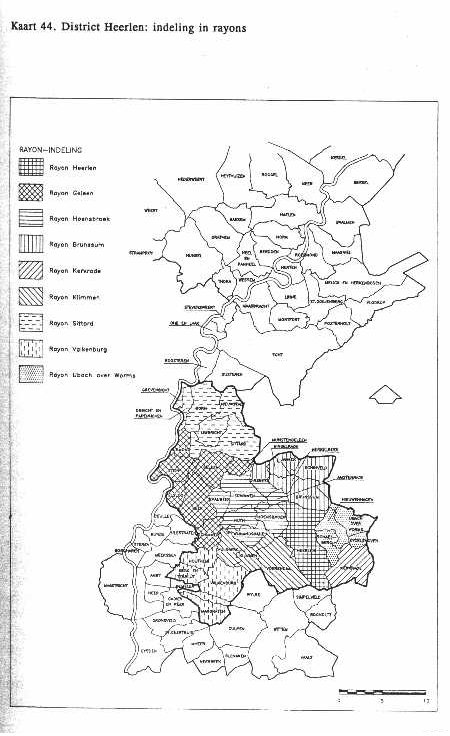
The stream of the divers increases

Sometimes we had some problems, especially with a convoy from the region of Hilversum. For a short while we had a convoy system, so that they suddenly invaded Valkenburg with 20 to 25 divers simultaneously, which in my opinion was a stupid method. Then I stood there with the heads of the diver cells at the train station to receive the men and to share them out between the diving places.
There was espionage behind one of these convoys. Then I made a supervisor of the O.T. (Organisation Todt) declare, that they all were OT workers, who came up with. I made this man say that indirectly, around some corners. And this man happened to be not so un-national, that he would not declare this. These were people from the Betuwe region. I think that something was going on there, so suddenly all divers had to disappear. I got some of them too, and we had to pass them off as O.T. workers.
From Heerlen we also got regular supply of divers. 143 Names are known with us, of people we got from there. There are more unknown names, of guys who already roamed about and whom we gave official work with farmers and businesses in Valkenburg, particularly in hotels. I had a ship’s officer as chef in the Hotel Continental. He said: “We on the ship can do anything. I can cook too.” “OK,” I said, “then you’ll be cook in a hotel. That way you at least will have no need to go outside.” But just a terrible thing came out of this. I was told that the people there were almost poisoned!
At the local distribution office W.A.P. Freysen and V. Willems “freed” monthly between 500 and 800 ration cards. There was even a surplus, from which other subdistricts benefited. Many divers received from an employee of the C.C.D. (Crisis Controle Dienst) and the head of the local Office of Food, L. Brands, an agricultural exemption, so that they could earn their own living, and the rayon leaders only had to support here and there. Monthly on average ƒ 1,600 were paid, which came from the district management in Heerlen. The subdistrict had approximately one hundred and fifty divers. Upon their arrival at the train station in Valkenburg they were controlled by use of a password and a Turkish passport. At one single day in 1944 not less than one hundred divers arrived at the station because of problems in the district of Maas en Waal. Schunck and his people could accommodate most of them at farms with the help of L. Brands, without attracting any attention in this area that was really heavily visited by tourists.
The verger in the confessional

The people who arrived at the station were told, they should go to the church, supposedly to confess. And in front of which confessional they should take place in the church. They’d get a briefing there about how it would go on. These people were from a Catholic area, so they knew that they should wait in the pews, until it would be their turn. In the confessional was not a priest, but the verger Harie van Ogtrop. He asked the one, whose turn it was, who he was, and told him to which diving address he should go. The church was the only place where such an action could take place totally unobtrusive because only there many people at the same time were allowed to be present. Later Harie van Ogtrop lost almost his entire fortune. The former resistance fighter Jan van Betuw below describes the circumstances shameful for our post-war Netherlands. As the verger was also heavily disabled due to an accident, he then fell back on a paltry pension of sexton. He was been hit as a pedestrian on the sidewalk by a car and sat in a wheelchair.
“Paul” undertook still attempts to cancel the decisions of the institute for trust, as well as in the case Soesman, described below by Jan van Betuw, but they failed. Jan van Betuw: “One must regard these things however in the context of the mentality of those days: of the obedient and law-abiding citizen. Legal aid shops were unknown, and/or still for a long time not as generally spread as nowadays.”
The Jews in Valkenburg

On September 11, 1955, in memory of the deported and killed Jewish inhabitants of Valkenburg, a memorial stone was placed on the Jewish cemetery on the Cauberg. Jan Diederen writes in his book „42 Jews from Valkenburg arrested and murdered“: Not all entries are correct. For example, Erna Benedik was not deported from Valkenburg, but together with her husband Theo Sachman from Amsterdam. The widow Henriette Herzog-Berlin survived the war and died a natural death. The name Jacq. Hannef is not only misspelled — it should be Jacob Hanft — he also did not live in Valkenburg but in Dolberg near Klimmen. What also is confusing, is the fact that all married women are listed with the surname of their husband and not with their girl’s names. On the memorial stone the victims deported from Valkenburg Eva Cok de Wilde and Alice Gebhart-Rosenwald are not listed.
In the book mentioned above (ISBN 978-90-805499-3-7) are the correct and more extensive data to be found in the tables ‘Valkenburg’ and ‘Benedik’. It is available for € 10,- from the author, jahdiederen@hotmail.com or Henk Vossen, Prinses Christinalaan 33, Valkenburg, tel. 043-4511312.
This book is the source for our list of Jewish residents of Valkenburg who perished during the war and those who survived.
The L.O.-member P.J.A. Schunck resident in Valkenburg, noted that the local, by the way, small Jewish community did not want to take note of the dangers and rejected offered help. Their attitude was typical of so many Jews and other. They could not believe it, even not think how bad the Evil could be. An elderly Jewish couple for example was firmly convinced that they had to leave their apartment for a large family. In return for their departure, accommodation at a nursing home had been promised to the two aged people. Also other Jewish residents of Valkenburg did not believe the alarming messages that had leaked out. They sincerely thought there would be at most (forced) work in Polish camps. With this view they deceived themselves to put up with their situation. Approximately half of the Jewish inhabitants of Valkenburg did not survive the war.
In other ways Valkenburg also was typical for a widespread phenomenon. The "small", destitute Jews were almost all deported, while in many cases the richer ones could hide in time, sometimes with the help of individuals, sometimes with the help of the L.O. or another resistance group. After the deportation of the local Jews, dozens of Jews from other parts of the country found shelter in the subdistrict of Valkenburg, supported by the LO.
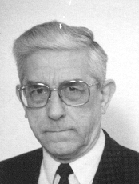
Jan van Betuw
I got the following text from a former resistance man, Jan van Betuw, by e-mail after a conversation with him at the funeral of my mother, Gerda Schunck-Cremers.
Jan (Jules) van Betuw (DB) was a courier of the resistance in Heerlen. In this capacity he escaped on a day in early 1944 to his arrest on the Valkenburgerweg (road to Valkenburg) in Heerlen.
Dear Mr. Schunck,
enclosed the article concerning what your mother told me concerning the Jews in Valkenburg and the verger, as well as the point of view of the Dutch government.
Kind regards
Jan van Betuw
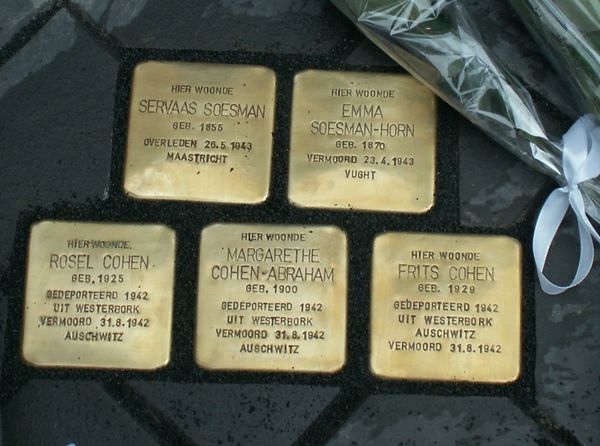
November 07th, 2014. In Valkenburg stumbling stones are embedded in the sidewalk, in this case in front of the house where, among others, the couple Servaas Soesman & Emma Horn lived.
More about these “Stolpersteine”
Wikipedia
Attention: Jules spells the name of this old couple differently than the Stolpersteine foundation: Soesmann-Horn vs Soesman-Horn. Since I do not know which spelling is correct, I let it as it is in the original text.
Vultures after World War II
How a small country can be even smaller
Since World War One the married couple Soesmann-Horn lived in Valkenburg. Already as a school girl Gerda Cremers knew this Jewish married couple, who lived next door. He was of Dutch, she of German origin.
In Valkenburg they were very respected people. At a more advanced age Mr. Soesmann held a prominent position in the Jewish community, he was the deputy rabbi. On Sabbaths the later Mrs. Schunck-Cremers lighted among other things her neighbours' stove.
During World War Two the couples Schunck and Soesmann still lived in Valkenburg. Mr. Pierre Schunck played a prominent role in the resistance movement (where he was called „Paul”) and he knew about the plan, to make Valkenburg „Jew free” soon. Energetically he arranged a place for his acquaintances to submerge: in the hospital of Heerlen (Mr. Soesmann, already older, was sickly). Because Mrs. Schunck knew the Jewish couple already since a long time she was more confidentially with them. So she asked them if they would be aware of the consequences of this making „Judenfrei”. They were actually, as far as possible at that time, however they had, like everybody, no notion of extermination camps and Auschwitz.
During this conversation Mrs. Soesmann said, that she already found a place for many objects of value such as jewelry in their circle of friends. Now she was winding the rest in balls of wool. This way she could carry it unnoticed to have it in reserve for emergency cases. To the question, whether she would have also acknowledgements of receipt of it, she showed her some notes. But about the own house or a will they had not thought yet. Paul settled that too. A brother of Mrs. Soesmann's. who emigrated to America already some time ago, became sole heir. Mrs. Schunck got the documents into safekeeping.
However, about submerging the Jewish couple did not think: „No, if God leads our people into the exile, we older ones must go ahead. And we do not want to endanger anybody for the short time, we still have to live”.
A short time after they were arrested by the Germans and were brought to Maastricht. Everything they had with them was taken away! From Maastricht they went to Aachen, where Mr. Soesmann was separated and „removed” (!) as an old and ill person (and thus of no „value”). Mrs. Soesmann went alone on transport. A fellow prisoner who survived, knew the tragedy and informed Paul after the war.
After the war „Paul” (Pierre Schunck) found out brother Horn's address in New York and informed him about the will. This brother, who was already older and a waiter, lived in needy circumstances and so he was overjoyed, despite the mourning for the fate of his sister and brother-in-law.
Paul arranged a business trip to Bonaire in the Caribbean and inserted a two days break to visit the Dutch consul in New York. He made an appointment with the brother and wanted to settle everything by going with him and the will to the consul. The consul received them, listened to their history, examined the will and seemed bent to react like Paul expected.
„But of course Mr. Horn will have to legitimize himself as the designated heir.” Horn submitted his old German passport, with that large "J" in it, to the consul. The consul reacted as stung by a wasp. „That is hostile fortune, which has to be seized! Because Horn is a German!”
Friendly persuasion and pedantic explanation of the situation did not help a bit. Horn did not get anything and the consul seized the will.
When Paul, deeply disappointed, came back home to Valkenburg again, there a letter from a lawyer waited already, in whom he was summoned to announce all possessions (movable and immovable) of the deceased couple Soesmann-Horn to the so called „Nederlands Beheersinstituut”, (NBI, institute for trust). Paul did so. When the institute for trust claimed the objects of value of the Soesmanns from the persons they gave them to, people in question denied to have received anything for safekeeping. The house of the Dutchman Soesmann was publicly auctioneered. The only offerer was a former Dutch Nazi, who remained living there.
Thus the Dutch state and its citizens appropriated the possession of murdered Jews.
Another scandalous occurence concerned the resistance man van Ogtrop (the verger of Valkenburg). He lost almost his entire fortune. He had married in goods community, a long time before the beginning of the war, the daughter of a German bus entrepreneur. This man lived in Koningsbosch (municipality Echt) and had there his enterprise (among other things miners transport). These people were everything but Hitler followers. Her/his part in the enterprise was just seized. Because the verger became also still severely disabled by an accident, he fell back on a lean vergers pension.
Paul undertook still attempts to cancel the decisions of the institute for trust. But they failed. One must regard these things however in the context of the mentality of those days: of the obedient and law-abiding citizen. Legal aid shops were unknown, and/or still for a long time not as generally spread as nowadays.
12/8/1999 Jan van Betuw.
Traitor

Once I believed to have a traitor here. This was a man, who always just wanted to hide somewhere else. So I brooded how to get rid of this man. He constantly made trouble and said every time he wanted to have another hiding place. I got him to Bep van Kooten, I said to him: “I can give you a nice specimen.” He said: “Just let him come, I have got enough deserted [*****]!” And he solved this case.
Pierre Schunck puts it here briefly and almost cheerful. At home he spoke differently about this. They had this man lying heavy on their stomach. Most of the resistance people in Limburg were convinced and principled Christians who took seriously the 5th commandment. But on the other hand they were in war, and this man was probably an enemy. So martial law and the principle of self-defense was valid here. And the K.P. as “armed arm” had to solve it. That was of course totally different from the actions of “Bijltjesdag” (day of reckoning) after the liberation of which the L.O. dissociated itself.
Victor Grotaers writes in one of his mails:
“I also remember that chapel quite well. … I know I was only 3 and a half years old when the war finished but those images have always stayed with me.
Facing the chapel on the right hand side were also 2 graves of what I believe of 2 people that were executed in those caves.“
One of the two executed was probably the person mentioned above. Betrayal was a major problem for the resistance. The worst case in this context was the arrest of just about the entire top of the Limburg L.O. in Weert, including the district leader Berix of Heerlen, see above. His adjutant Cornips was also suspected for having committed the betrayal. The K.P. “examined him toughly” in the diver’s inn (Cammaert), but the traitor turned out to be the paper forger Jesse, who was overworked and thus psychologically tortured in that condition. They threatened to break the bones of a Jewish child one by one in the presence of the wailing mother and Jesse, until he would say what he knew. He was released from prosecution after the war. The reproach was that he did not warn anyone. Not the “betrayal” itself.
There was also infiltration by Germans who wanted to go into hiding. Were they honest or not?
This quote from Cammaert from  - The KPs (fighting teams) and the history of the Stoottroepen until the summer of 1945 indicates well how the intertwined L.O. and K.P. dealt with this:
The local clergymen and secretary Moonen received constant visits from illegal workers and were consulted on almost all serious moral matters, such as liquidations. They emphasized many times again that the aims pursued, if at all possible, had to be achieved in a non-violent and humanitarian manner. Even the smallest risks had to be avoided.
- The KPs (fighting teams) and the history of the Stoottroepen until the summer of 1945 indicates well how the intertwined L.O. and K.P. dealt with this:
The local clergymen and secretary Moonen received constant visits from illegal workers and were consulted on almost all serious moral matters, such as liquidations. They emphasized many times again that the aims pursued, if at all possible, had to be achieved in a non-violent and humanitarian manner. Even the smallest risks had to be avoided.
All that was a question of life and death and of a different caliber than the revenge action by so-called resistance people against Savelberg on the Grendelplein AFTER the liberation of the southern part of Valkenburg, see below.
Manipulations with Food and Cards

The people in hiding had to be provided with food, clothing and so on. There were two ways to do so: tampering with distribution documents or distributing things that had been obtained outside the official circuits. The miller and civil servant Vic Willems (DB) did both, as can be seen from the following statement by rayon leader Pierre Schunck, better known during the resistance as Paul Simons. After the liberation of Valkenburg he wrote:
Statement
Mr Victor Willems, miller in Oud-Valkenburg, has always made his mill available during the German occupation for the storage of food for people in hiding.
Valkenburg, November 14th, 1944
[Signature Schunck], Paul
Rayon leader L.O. R8-Z18
R8 = District of Heerlen, Z18 = Rayon (Subdisdrict) of Valkenburg
Source: Archive of Ger Willems
But Victor Willems was not only the miller on the water mill near Schaloen Castle (1930 to 1954), he also worked at the distribution office. He and Willem Freysen (DB), who had contact with the L.O., started to forge and steal documents on a large scale. The old director preferred not to notice anything. “Paul” wrote in the style typical for that time:
As a civil servant at the distribution office Mr. Victor Willems has always cooperated in the acquisition of distribution documents for persons in hiding by fraudulent-administrative means, under the direction of the L.O.-distribution contact person W.Freysen.
[Signature Schunck], Paul
Rayon leader L.O. R8-Z18
R8 = District of Heerlen, Z18 = Rayon (Subdisdrict) of Valkenburg
Source: Archive of Ger Willems
The extensive manipulations at the distribution office would become apparent when the chief of the office was about to be replaced by Nazis. To cover them up, the distribution office was raided.
The story below from Pierre Schunck’s notes is not dated by him. But we can somewhat determine the time: the district meetings no longer took place in the hospital, but they took place. So it must have been in the year 1943, see also Meetings.
L.O. Contacts 1940-1944
Sub-District 8 District Z 18
Farmers as cooperators in the meat supply of the people in hiding.
At a district meeting in Joe Seelen’s house on Valkenburgerweg in Heerlen, sausages were distributed to the present sub-district leaders and district staff. The district management was able to be so generous because recently domestic cows had died of an illness and had been declared unsuitable for consumption. However, this did not mean that these cows were stuffed into sausages and given to people in hiding. In such cases, the procedure was as follows:
Imagine a farmer had a sick cow in his stable or a cow that died. Then he called his veterinarian. If the animal had to be killed by order of the veterinarian, he issued a certificate stating the ear tag number of the cow that died. With this document, the farmer could get a new cow. He was supposed to take the carcass to a collection point, where a capper’s car would come to pick it up.
A trustworthy farmer from the area (who usually also had hidden people at his farm) secretly took this carcass away from the collection point and put it in his own stable. The ear tag was carefully removed and replaced by another one, from an own cow. The cow, whose ear tag had been given to the carcass, was then destined to be slaughtered in secret. Then the vet was brought to the carcass and the same cow was registered again, but now with this farmer’s earmark number, as dead. The cows’ bookkeeping remained correct and they still had extra meat.
It has happened that the same carcass has served several times as a meat supplier, even so much that the veterinarian Quadvlieg from Valkenburg once said: “Now you have to stop with this poor animal and look for another one, this one is stinking too much for me. "
When the newspaper issued a warning for the umpteenth time not to buy meat from secret slaughtering because it would come from a cow that had died from a dangerous disease and whose carcass would have been stolen from the concealer’s collection point, then our hidden people had a good piece of meat again.
Manipulations with Cards
With the exception of agriculture, detailed records should be carried by any business, of how much male people aged between 18 and 45 years were working there. A special inspection should determine who came into consideration for de work duty in Germany and who not. The data were entered on a Z (Zurückstellungsverfahren = reset procedure) card. The complexity of this process offered new opportunities for sabotage. Various companies and regional labour offices worked by many means against the measure. The L.O. got a large number of blank Z cards in hands, brought false ones into circulation and sent fictitious ones to the employment offices. By sloppiness, misinformation and delay in the execution, in which officials from all institutions and authorities collaborated, the process sank into utter chaos.
Also in Valkenburg local government officials muscled in with that, in the town hall and at the distribution office.
Ad: Were there still special actions with Z cards or TD’s? (= Tweede Distributiestamkaart / second )
Schunck: Those Z-cards were not that necessary for us, but nevertheless we had an agent. He was a man of the tax office, who often visited business people, and who allegedly came there to check their books. Then he said to such a business man: “Did you present already the Z cards of your employees?” And if they hadn’t, he said: “Come on, then I’ll just fix that.” Then he did it and brought them to me. Then, these entrepreneurs believed that they had their Z cards in order. The man from the IRS provided me with rubber stamps and I brought them back to him, that was very easy.
With regard to my own business, I didn’t mind the Z-cards.
This company (Pierre Schunck gave this interview in the “Mill” in Heerlen, where he was the managing director.) was closed by the Germans and in this time we worked continuously for divers, allegedly as a repair company for pit clothing. We could work quite freely because (?) my assistant was a diver (because of his “non-Aryan blood”).
June ’43, our company was closed, seized by the Germans. I don’t know why. Then the central warehouse of Distex (National office for the sales of textile products by trading) figured it out. One of the gentlemen believed, that he could conclude on a pro Dutch mentality on our part. So he came to me to fathom out, whether we still could continue working (we did) and whether we could do something for him. I ask: “What do you want?”
He says: “The Landwacht (paramilitary auxiliary service of the German occupying forces, consisting mainly of N.S.B. people, founded in November 1943) seizes here and there a lot of cloth, which is stored in our warehouse, and we would like to process it to clothing. We want to give that to the workers of some Dutch industries, which are out of favour with the Germans.” So he wanted to have work clothes.
Well, one word follows the next, and because I somehow guessed it already, he finally came out with it, that sometimes he did something for hiding people and that they have stuff which had to be processed to clothing. I say: “That’s fine, but then I want to have an advantage of it too, then I want to have something for other divers. I will take care to establish contacts. I also want to do something for the people in Limburg.” “I agree,” he says, “we will give you the order.”
Then were we processed 30,000 M of fabric for divers who went back to Distex and partially were distributed in the district here. They were pants, shirts and fabric.
The Raid on the Distribution Office in Valkenburg

These words are important to understand the following chapter:
Ration stamps = In order to distribute scarce goods fairly, the Dutch government had already introduced ration stamps in 1939. Only people who had them could buy food, textiles, etc. in the store. The alternative was the black market, but only well-off people in hiding could afford that.
Stamkaart (master card): Personal card with which people could receive stamps. Of course the people in hiding had none. Therefore they had to be provided "illegally" for them.
Distribution office: There the population could get these ration documents.
By the growing number of divers, their needs could be met only if they also possessed a sufficient amount of ration cards and coupons. Mostly local government officials ensured this, like in Valkenburg. The way howto was one of trial and error:
Only for PB’s (identity cards), the subdistrict of Valkenburg was primarily dependent on help from outside. Schunck appealed to the divers, not to apply for new PB’s if it was not absolutely necessary. In June 1944, the relative self-sufficiency threatened to come to an abrupt end by the introduction of a new insert sheet.
Young men, who had to go to Germany for an Arbeitseinsatz (forced deployment of labor), were supposed to hand in her ration coupons. In return they received a certificate with which they would get their ration coupons in Germany. When they would go into hiding they would starve, the Germans assumed. It was the LO, who often cared for that and provided a new registration card.
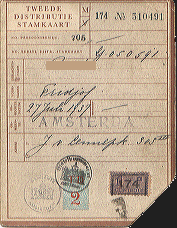
Stamkaart
During a long time, in every period of four weeks, some officials of Valkenburg’s distribution office had been able, via various crooked tours, to obtain clandestinely between 500 and 1000 complete sheets with ration coupons for the people who went underground. However, it could not fail to appear, that this would be discovered one day to come soon. First, they tried to have printed new counterfeit cards in Amsterdam, but a German raid in that print shop prevented this solution.
L.0. Contacten 1940-1944 Rayon 8, District Z 18 Distributie-contacten: Willem Freysen Vic. Willems Office Annie Cremers Valkenburg
In the course of 1943 and the spring of 1944, these contacts had succeeded in branching off between 500 and 800 sheets of ration stamps and cards for the L.O. during each distribution period.
Margin: Van Hinsbergen, the director, was in the picture.
For the district, these cards were absolutely necessary because our people in hiding depended on such illegally acquired documents to feed themselves. The purchase of food on the black market was only possible for the financially strong.
Meanwhile, the rationing office was under the direction of an N.S.B. man, Bosch J.
Hand-written in the margin: Ramaekers and Bosch
Our contact team feared a review at any moment and that they would not manage to correct the deficits in time, which would inevitably lead to their severe punishment.
To free them from this desperate situation, the L.O. acted as follows:
A printer in Amsterdam executed printing work which was difficult to do for the illegality itself. He was ready to falsify the ration cards for our distribution area. With these ration cards our contact persons would be able to correct their deficits.
Footnote: Ration cards of my wife and Mrs. Jaspers from Klimmen were forwarded to the printer.
While we were still awaiting the execution of our order to this printer, the Germans found out that they did illegal work and closed their shop.
Note by the translator: The Dutch resistants called themselves “illegal”!
After consultation with the district management, we decided to attack the distribution office and to establish such a chaos that it would be impossible to control any cards.
The K.P. (knokploeg = fighting team) from Heerlen was found willing to do the job, namely “Kees” (Piet Driessen). He asked for a plan: the ground plan of the building, an exact plan of the front as well as of the back side, the type of guarding and the place where the stock of ration cards was located. The latter was the most difficult point for the entire execution of the attack, for the stamps and cards were stored in a fireproof safe with a heavy door.
Every evening, the key was brought away with the same ceremony: to the station of the Rijkspolitie (gendarmerie) on Emmaberg, where permanently a policeman was present, and there into the safe. For this transport the N.S.B. director put the key into a large envelope, on which were put five wax seals and the signature of the director. Two armed policemen came every evening to get this envelope personally from the director.
The next day the envelope was returned to the distribution office with the same escort.
I had a contact at the distribution office in Valkenburg in ’43. That generated initially about 200 ration cards per period, and later 400. In fact that was too much for the distribution in Valkenburg, but by proper teamwork of the distributors, we could still handle that without difficulty.
Then the old insert sheets became invalid and there came numbers on the new ones: Valkenburg was N° [272]. So I was worried that we would get the insert sheets for Valkenburg in time from the printer.
The director of the distribution office, Th. van Hinsberg, always let these men do as they wanted. But in the beginning of 1944 he had to go underground and was replaced by two dutch Nazis. Freysen and Willems feared, that with the introduction of the new insert sheet the extensive manipulation would come to light. They discussed their problems with the subdistrict management and they suggested an assault team should cause a huge mess in the distribution office. Only in this way, the fraud could remain undetected.
I discussed that with our L.O. contact within the K.P.: Bep van Kooten (sabotage specialist of the K.P., later commander of the “Stoottroepen” in Limburg, see the chapter Valkenburg is free below), who referred me to Jaques Crasborn (K.P. of the district of Heerlen, that Valkenburg meanwhile belonged to. The K.P. was the “armed wing” of the resistance.) We met in Valkenburg and Jaques promised to me to get the needed papers from the distribution office in Valkenburg for me as soon as possible.
J. Crasborn worked out a plan and he agreed to take the command. In turn Freysen would give all needed information, draw a ground-plan, and procure the key.
So they launched a daring plan. It was usual that every evening, the keys of the safe of the distribution office and such things were given to the police for storage in an envelope with five wax seals and the signature of the director. For a while, they fished the wax seals from the wastebasket every day, after much trying the signature was counterfeit on a equal envelope and gradually similar keys were bought. They prepared the envelope with its contents, the signature, and the already used wax seals and ten they just needed to wait until the right moment now, that they could hand over this envelope to the police. The moment came and the chance was used.
Later he (Crasborn) came to me one afternoon and said: “Tomorrow it will happen, but we don’t know how we can get the key of the safe”. So on the same afternoon my contact at the distribution office (Willem Freysen) prepared an envelope with keys, which were about the same size as those of the safe. He had them ready and he swapped the envelopes unnoticed. He had prepared it very well and cleverly: he had collected from the trash the wax seals, soaked off the paper under them and he then glued the wax seals neatly on the new envelope. Also he forged the signature of [??], the director of the Distribution Office, a sympathizer of the N.S.B., and put it on the seal. So that was great.
Every evening the most important keys, in a sealed envelope that was signed by the director, were given into safekeeping in a safe of the police station. Freysen circumvented that obstacle by giving a completely identical envelope with fake security seals and signature to the night watchman, who was inaugurated in the conspiracy, the police officer J.H. op de Ven.
The envelope was issued at the police station and the person who brought it there, didn’t suspect anything. The real one has been brought to the K.P. agent of Valkenburg, who ensured that the K.P. got it, which was waiting for their task.
Some time before the K.P. stole a German army vehicle from a garage in Sittard, along with some cans of gasoline. The car was transferred to Valkenburg, fully recovered in a garage (Garage Corbey (DB)) and then hided in a cave behind the monastery at the Cauberg. That night they committed the robbery using the genuine keys, while the false envelope was under the care of the police.
When an unsuspecting employee gave the real envelope at the police station on the evening of 22 June, officer Op de Ven received it and gave the fake envelope a colleague who put it into the safe. Then Op de Ven (DB) went to the distribution office, where he was supposed to keep guard that night, together with a member of the N.S.B.
Late in the evening, two cars arrived in Valkenburg with a five or six man strong command team. One car was “borrowed” from the Staatsmijnen (= State mines). The other one was provided by the K.P. group of Sittard. Because everything was arranged to the last detail, the raid went flawlessly. The N.S.B. man (Den Haring) got a blow on his head and was unconscious. The K.P. men did not know that a consignment of allocation documents for two months had arrived the day before. The haul was colossal: over 210,000 Bonkaarten (ration cards), about 82,000 ration stamps, over 2500 ration cards, 5000 T.D. master cards, 1600 toeslagkaarten (supplement cards), numerous insert sheets and a typewriter. More than a dozen of jute bags were needed to transport everything. The bags were brought to a farm near Kunrade in Voerendaal. When they sorted it at the home of Mrs M.-T. Jaspers in Klimmen, it partly turned out to be useless, which was burned. Another part of the haul finally landed in Valkenburg and was hidden in the old parish church. The SIPO groped around in the dark. Op de Ven went underground after the raid and attracted thus the suspicion on himself. Freysen and his colleagues were not suspects and were able to continue their practices undisturbedly. The unwitting bearer of the key was strongly grilled, because the envelope in the police safe contained the wrong keys. He knew nothing and returned to free feet after a day.
Jan Diederen schrijft in Mijn oorlog en bevrijding: „In het Valkenburgs gemeentearchief bevindt zich een lijst met een omschrijving van de rantsoenen en losse bonnen en de daarbij behorende aantallen. Hoe de gegevens daarvan met die hierboven vermelde met elkaar overeenstemmen is onduidelijk.
…
Naast de in bovenstaande vermelde bonkaarten en bonnen worden ook nog rantsoenen en rantsoenbonnen buitgemaakt voor diverse soorten zeep, waspoeder, tabak en sigaretten, petroleum, benzine en andere brandstoffen, smeerolie, kaarsen, textiel, serviesgoed, dames- en herenschoenen, werkschoenen en pantoffels, binnen- en buitenbanden voor fietsen en zelfs frames. De bonnen voor brood, boter, kaas, taptemelk en vlees betreffen een heel, een half en een kwart rantsoen. Bij suiker, brood, boter, melk, vlees en aardappelen zijn er nog bonnen voor noodrantsoenen en bij andere voedingsmiddelen puntenbonnen.“
The complete distribution records and other documents disappeared in a car towards Oud-Valkenburg and via Ransdaal to a farm in Kunrade. Later they were brought back to Valkenburg, in a car hidden under straw, because the Germans investigated all the farms in the subdistrict.
On the Plenkertstraat. A lot of clandestine transports for the resistance in Valkenburg were settled with these vans. The person next to it is Pierre Schunck.
This transport was carried out by Pierre Schunck. The straw was for our animals. A few of my older siblings sat on the straw again.
Next morning I heard already in the street, that the attack had been successful, and I got the message from Bep: “Come and get your crap”.
I went to Klimmen with a van, and together with Bep we went to a farm along the railroad, and we loaded the whole shebang into that van of the laundry. It was packed in flour bags, we put straw on it and so we went to Klimmen, to Jaspers. There [????] waited with a bunch of the KP. They took the ration cards and I got the stamkaarten (master cards) and insert sheets with the number, so I was helped too.
This way we could prepare 400 ration cards; 200 via the distributors. And insert sheets, which were glued on, and another 100 via master cards which I distributed to the host families and where the “parents” of the divers could get ration cards for their families.
That was always wonderful, we never had trouble with that.
My mother, Gerda Schunck-Cremers told about this action in an interview with school children. That website no longer exists, but here is what I could save:
Everything worked and the N.S.B. man, who was there as a night guard, was beaten unconscious and locked up in the toilet. Ration cards and stamps were kept for a night at Mrs Jaspers’ in Klimmen. She was not in the resistance, but she helped the resistance now and then. Next morning, Mr Schunck went to pick up the ration cards to bring them to a remote farm on the road from Voerendaal to Heerlen, from where they would be distributed. Together with three children, Mr. Schunck went with a van to get the coupons. Under the guise of: “We want to get hay for our horse,” they passed pretty easily the guards and the cards and stamps were delivered safely.
The illegally distributed newspaper De stem van Londen (The Voice of London) wrote on 19 July 1944 on page 2:
RAIDS.
From our Amsterdam correspondent.
In the week from 20 to 27 June, 5 raids were committed at distribution offices:
1) On 6/20/44 at
…
and many other coupons.
3) On the same day the distribution office in Valkenburg-Houthem was attacked. They arrived by car, the policeman on duty had provided the keys and pointed the way. He disappeared later with the robbers. (Dutch policemen, who will follow!) The following were taken: 78000 ration coupons of reserve, 38000 ration coupons of confectionery, 71000 ration coupons of legumes and thousands and thousands of ration coupons of almost every kind, including several hundred D.S.K (main cards) and almost 10,000 insert sheets.
4) The day after…
The Raid on the Distribution Office in Heerlen

For comparison, the story of the raid on the distribution office in Heerlen follows here. The differences that come to notice: the action was not planned together with the L.O., it was violent and it has brought nothing. Also it is not clear whether the raid of March 9 brought Nitsch on the track of chaplain Berix.
In early March 1944 the K.P. of Heerlen, in collaboration with the one of Nijmegen, made the ambitious plan, one after the other to attack the police headquarters, the distribution office and the town hall in Heerlen in one single coordinated action. The idea came from G.H. Bensen and the K.P. man L. A. van Druenen from Nijmegen. After they had watched the objects a couple of days, they came to the conclusion that the plan was feasible. The K.P. Nijmegen would be divided into two groups. Five K.P. men under the leadership of Van Druenen would take the police headquarters. The second group, led by Th. Dobbe, would attack the distribution office. These two groups, along with the command of Heerlen would then penetrate into the town hall.
In the night from 9 to 10 March at 00:30 the K.P. men knocked at the police headquarters. They claimed to be train passengers who hadn’t found an accommodation after their arrival. The duty officer harbored no suspicions and let them in. The K.P. men overwhelmed the five night guards, whom they gave a cigar and a blanket and they locked them in a cell. A police officer had to give up his uniform. Perhaps it could do a good turn in the next phase of the operation. The commandos took 24 guns, sixteen of them loaded, four pairs of handcuffs, two leather motorcycle jackets and other equipment. After they had made the alarm unusable they went to the distribution office, where Dobbe and his group were waiting. When they arrived, it turned out that Van Druenen in the hurry had forgotten to take the keys to the distribution office, which were kept at the police headquarters. Dobbe was undaunted by this setback, because Bensen and his men waited to strike at the town hall.
The uniformed K.P. man was supposed to ring, whereupon the other K.P. men would go inside to eliminate the guards. But it turned out differently. One of the guards raised the alarm. There was a shootout in which a security guard was wounded. The K.P. men withdrew to Valkenburg. The command from Heerlen didn’t have to come into action anymore. Next day Dobbe and his team returned to Nijmegen. An investigation by the Sipo remained without any result. It is not whether Nitsch came through the RAID of March 9, chaplain Berix on the track. When Berix heard that in Geleen arrests had taken place, he went underground on March 24, 1944.
Monument for chaplain J.W.Berix
Of course the L.O. would have had profits of a successful assault on the distribution office and the town hall, but whether the organization was involved in the plans, is not sure.
Butter and Eggs

On March 25 1944 stationmaster Vroemen (DB) phoned Pierre Schunck with the message that during the next night a wagon full of eggs would stand at the station of Wylré to be brought to Germany, and he proposed to take advantage of this opportunity.
The wagon still had to be decorated with banners like: “A gift of the Dutch people to the Germans” and “For the German winter aid!” But it was of course simply swiped at the farmers. Pierre Schunck gave this information to the K.P. in Heerlen.
L.O. Contacts
Vroemen, the stationmaster of Valkenburg
If there was control by the Landwacht (auxiliar police) or the Germans, I was always warned by the station manager with a code message “you cannot unload your wagon.”
With our coming guests in hiding, we agreed that they should report to the station manager with a previously agreed question.
When the region of Maas en Waal was “ausgekämmt” (searched) and suddenly more than 100 boys had to disappear, our sub-district was assigned this. Vroemen managed to fish them all up.
These more than 100 boys were placed with farmers in the area in one day with the help of the office of Lambert Brands. This office was opposite the station in (now) hotel Tummers. (C.C.D. Crisis Control Service)
When the Jesuit monastery was seized in 1942 and the Germans regularly delivered large boxes at the station for transport to Germany, Vroemen compiled a list of all addresses where the boxes went. Thus after the liberation a precious ant collection o Father Mückermann could, among other things, return to the Netherlands.
One day he calls me if I wanted to come because of materials that have arrived for the company. I thought to find people to hide, but got the following story:
“We had to put a full wagon with eggs on a sidetrack in Wylre. This wagon should be decorated with a inscription tomorrow morning, something like „Geschenk des Niederländischen Volkes an die bombengeschädigten Städte deutschlands“ (Gift of the Dutch people to the bomb-damaged cities of Germany) Further: We did not fix the wagon with the air brake. There is a brake shoe against the wheel that you can pull away. A second brake shoe is ready at the level crossing. If you pull the brake shoe away, the wagon is slowly and silently moving towards the level crossing.
When I got home I did as follows: Calling Z18 (Giel Berix).
I don’t remember exactly who was called. Armenraad (council for the poor) in the Geleenstr., With the request to call me back, was most secure.
Jan Cornips
(He) had a non-observable secret number of the post company, via the service line. I told him the situation when he called me back. (Giel) then informed the K.P. where this was not told to a deaf. If I took care of storage, the job would be done immediately. In the late evening the trucks arrived fully loaded with C.R.E. egg boxes. The next day, our vans distributed these eggs in laundry baskets across South Limburg with the hospital in Heerlen as main customer.
Germans and N.S.B. (Dutch Nazi party) people went to Wylre to sort this case out.
One of the truck drivers, a K.P. man made sure to be there to find out if something would be discovered. (Laeven)
In 1944 the K.P. of Heerlen came into action twice in the district of Gulpen, without previously informing the local L.O., on the basis of news from the subdistrict of Valkenburg. The K.P. of Heerlen captured between six and seven thousand eggs.
Why the K.P. did not inform the L.O. in Gulpen, Cammaert does not write. But we can take for certain that they wanted to avoid that too many people knew about the raid to come. Also there may have been misunderstandings between the resistance groups of Heerlen and Gulpen and they had to act soon. The eggs were brought to Pierre and Gerda Schunck to sort them. There were far too many, even after the rotten eggs had been sorted out. A lot of them went to the hospital in Heerlen.
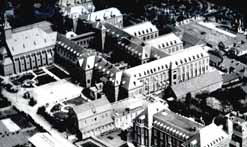
St. Josef hospital Heerlen
St. Joseph Hospital

The St. Joseph Hospital or Putgraaf Hospital in Heerlen was not only the birthplace of many children, but also of the Heerlen district of the L.O., which was founded here. In this hospital a whole floor had been made so perfectly untraceable, that it could be used to treat divers and allied pilots there. This was possible, because the Rector Nic Prompers, one of the founders of the L.O. district of Heerlen, together with the hospital director and surgeon Karel van Berckel and the nuns, who made a large part of the work, ensured that the entire staff was against the Nazis. And if you look at the hospital on the historical aerial photograph, then you understand immediately that this labyrinthic building collaborated with the resistance.
On the hidden floor of the hospital, also a Jewish child, Ephraim Eisenmann was born, with the help of his aunt Johanna Cohen, who was a midwife. (See “The righteous among the nations,” https://righteous.yadvashem.org/?search=Veugelers&searchType=righteous_only&language=en, searching for: Veugelers.
In “The History of Valkenburg” we read about the crashed British plane, where the fire brigade arrived before the Germans:
When an English plane crashed burning between Meerssen and Berg, the wounded pilot was transported by ambulance to the hospital in Heerlen on the pretext, he would be an injured fireman. In this hospital an entire floor was “hidden” for the occupiers, to take care for hiding people and pilots!
This was a bold example of social cohesion, which could work only because those who know about this place, kept her mouth. And that must have been quite a number of people, above all the nuns who operated the hospital. Authors, who find that the resistance in Limburg meant little because they knew / know no better, or because they regard humanitarian aid under war conditions only as civil disobedience, apparently don’t recognize the extent to which these people have put their lives, and often those of their families, at risk.
There was still another important tool for the resistance, which ran entirely outside of the field of view of the occupiers, because they didn’t even suspect its existence: the own telephone network of the Provinciale Limburgse Electriciteits Maatschappij, the electricity company P.L.E.M.
The members of the management of resistance had access via special numbers. This way they had a tap-proof phone network.
I had fun when I saw how the farmers supplied their eggs. The egg boxes have been brought to us and my wife and I distributed them across the districts and subdistricts. From here they were transported with the van of the laundry.
When we opened the boxes, they stunk to high heaven! We had to sort out the eggs very meticulously and carefully, to avoid that our own people would get rotten eggs.
If the Germans would have searched carefully to find the eggs, they could have gone after the stench!
The same was true for a butter robbery in Reymerstok on June 14. (Which took place without knowledge of the L.O. of Gulpen, too.) At this coup the K.P. men, in German Wehrmacht uniforms, stole almost a thousand kilos of butter, which was intended for the German army. It partly came for the benefit of the inhabitants of the prison in Maastricht.
This boy sees how the station manager Vroemen, who has to be present because he is “responsible”, is being scolded by a N.S.B. er who managed the butter factory in Reymerstok.
He hears that N.S.B. manager of the butter factory grumbling as follows: “All of you are dummies. This never would happen to me. I have got 1000 kilos of wehrmacht butter in my cold store, but no so-called white brigade can touch it.”
Our K.P. man decides quickly. He gathers some comrades, who have wehrmacht uniforms and a wehrmacht car at their disposal (pinched from the Vencken garage in Sittard) and they immediately go to Reymerstok, as long as the butter manager is still busy searching for the eggs.
The wife of the N.S.B. manager is alone at home and the butter factory is standing still. “Schnell schnell, unsere butter, wir haben wenig Zeit!” (Quick, quick, our butter, we are in hurry!) The German soldiers in the German Wehrmacht vehicle looked very familiar to this lady and our boys could get the whole bunch of butter in their car.
Our K.P. “wehrmacht soldiers” had no better idea than bringing this non-pre-planned butter to the egg address so that after barely having processed the eggs, I was now saddled with a butter mountain. This natural butter was divided next day partly via K.P. canals, while the majority was stored in the hospital of Heerlen in a hole under an inoperative elevator.
When the N.S.B. manager was back home in Reymerstok, and in addition to his egg riddle he also had to fill in a missing form for butter.
registered by rayon leader of the L.O. R8, district Z18 (= Pierre Schunck)
The dairy in Reymerstok was directed by an N.S.B. man. It worked for the German army. They used a looted German army vehicle and uniforms that did already a good turn on other occasions. This car was hidden in a cave behind the monastery of the fathers on the Cauberg hill.
The owner of the dairy was not suspicious and did not complain when the alleged German soldiers came to “collect a command” of thousand kilos of butter from the cold rooms of the factory. Maybe the fake soldiers had also fake papers, but nothing is known about it.
End of the “diver’s inn” 1

In summer 1944, the safest cave became a training location for the future soldiers of the “Stoottroepen” (part of the Dutch army).
Because the thing gradually had leaked out into the district. So one day Bep van Kooten comes to me with Jantje [Lemmens] and says: “You lost your diver’s inn, to the K.P.”. I was of course not very amused.
I undertook all possible actions against it. I said: “For me, that thing is necessary. But what are you going to do with it? Maybe storing weapons? You could do that just as well elsewhere.”
Van Kooten (DB) was looking for a suitable depot for weapons and a shooting range for the “Knokploegen” (command groups) of South Limburg. That was why this cave had to be evacuated, too. It turned out to be not suitable for the storage of weapons, it was too moist. But firing practice could be made there. During the summer 1944, the cave served as accommodation for the K.P., as a prison and as interrogation rooms for arrested people and possible traitors.
But in fact the K.P. used the thing as a prison. For more details, you must contact the K.P. (There a is known lot about it).
We began to set up the cave behind the lime kiln for the normal work with the diver’s inn. And when we just finished it, came next door a factory of the OT. That’s why cave has never been used. It’s still there. A film has been made by the Americans, which must be at the American army documents.
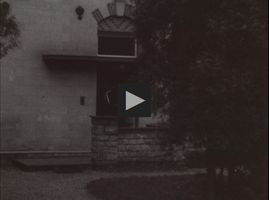
Here it is: Liberation recordings from South Limburg; Operation Market Garden.
Staged film about, among others, the resistance in Valkenburg. People going into hiding are picked up by Pierre Schunck and brought to the diver’s inn in his van, hidden behind laundry baskets. Furthermore, recordings of American military engineers, who inspect the site of a State Mine; removal of German prisoners of war; Jewish people triumphantly pulling the yellow star off their clothes; soldiers washing a jeep.
Click on the picture to see the film.
Source: NIMH (Nederlands Instituut voor Militaire Historie)
Once we had an incident there (at the cave). About 5 kilometres away there was a military training area (shooting site of the barracks in Maastricht). And during the war the German army came to do target practice. We never had any trouble with that.
But then they began to do field exercises as well and of course I didn’t know about that. The whole area was surrounded, also the entrances of our caves. A worker at the lime kiln, who was there a bit porter too, calls me and says: “They surrounded the whole cave!”
I’m going there immediately with a van. I leave it not far from there and walk the last piece. And I see a “mof” (that’s how the Germans were called in the Netherlands during the war) standing there with the rifle in the attack . I go on a bit and see another mof, with the gun in the attack. They were about to hold a practice, and all were standing guard with the gun in the attack. I walk around at the site, but it was completely surrounded.
I hurry back home and call [* lman]. I say: “If you still want to do something for those people, then come up with an armed group of yours and smash the skulls of these guys.” And there they came with a flying brigade. I don’t know how many cars they had commandeered, but when they arrived all German were withdrawn already quietly! So they could go back home. Of course I couldn’t ask the Germans: “Are you looking for the people who sit in there?”
Bep van Kooten was poison-green with anger.
An Own Intelligence Group

Support by and contact with existing underground networks or groups were essential to the intelligence services.
(…) Good results were achieved also by intelligence agencies, which came from existing underground organizations. Both the intelligence services of OD militia and the L.O. of Limburg provided the resistance and the allies valuable information.
In June 1944, the L.O. district leader of Heerlen, Th.J.M. Goossen organized his own intelligence service (I.D. , Informatie Dienst. Goossen was subdistrict leader in Kerkrade before.) to protect the underground in general. Moreover, Goossen’s I.D. collected military information that came among others from employees or repatriates of the “Außenministerium” (see Cammaert, chapter VI, § VIII.5.1. and Chapter VIII, § IV.4.7.). (Quote: The “Außenministerium”, German for Foreign Office, an underground organization formed in student circles, was active in Germany as well as in the Netherlands and was aimed to bring students from Germany back to the Netherlands. Because several L.O. people were involved, both organizations, especially in Limburg, were intertwined more and more.) Shortly before the liberation, the emphasis shifted partially at the request of the O.D. combatant C.M.J.A.F. Nicolas, on military information. In this work, Goossen’s I.D. chalked up remarkable successes. After the liberation, the Americans offered Goossen the opportunity to extend his service to whole Limburg and North Brabant. This I.D. performed also commands of the military authority.
Schunck: We were the first intelligence service, that worked in the front line.
Ad: Who organized that in your region?
Schunck: In our subdistrict it was me. Theo Goossen was the man for that at district level.
Goossen himself says during the farewell celebration for Pierre Schunck:
- On September 6th, 1944 he lets know that the day before Sjeng (John) Coenen (DB) and Joep (Joe) Francotte (DB) have been shot down on the Cauberg and still are lying there. What next?? For “Paul” this shooting has remained a permanent trauma.
- 1944-9-15 he states: “The Germans blew up the bridges over the Geul, closed the roads, they have mounted cannons and defend themselves against the advancing Americans. Several buildings are heavily damaged and several houses are burning. The greater part of the population have put themselves in safety in the lime caves.”
- 1944-9-16 The Resistance leader Bep van Kooten arrives in Heerlen. “Paul” lets him know, on his trip to Maastricht and Brussels he should not go by Valkenburg. This would be dangerous to life. (Van Kooten wants to make contact with the headquarters. More about this in the chapter Valkenburg is free )
In the night from September 16th to 17th, 1944: The Germans leave Valkenburg. “Paul” contacts the liberators, as had been ordered by the resistance. He will help them in all possible ways.
This way Pierre Schunck was the first one from Valkenburg to contact the approaching US army and guided them down into the Geul valley. See underneath the story of the liberation of Valkenburg
The disappearing of the residents’ register

On August 31 at 1 p.m., that is, just before the liberation of Valkenburg, the K.P. (Fighting Squad) South Limburg once again came into action in our town.
This time the town hall was the target. They wanted to prevent that the male population would be forced to build defence installations. They got help from the official H.P.A. Laeven, who faked unconsciousness after the attack. The SIPO contented itself with his explanation of events. The command took all person maps, fifty ID-cards, fifty control stamps and fifty vouchers. They burned the register at the headquarters of the K.P. of South Limburg in Ulestraten.
Two weeks later the liberation of Valkenburg started.
Marca Laeven writes in the book "Valkenburg 75 jaar bevrijd" on p.55 under the title Guus Laeven (1913-1972) made the population register disappear in 1944:
Guus Laeven was deputy head of the population department in the municipality of Valkenburg-Houthem during the war. This kind of town hall departments were well guarded, because the Germans needed the population registers to track down Jewish families. Moreover, this allowed to call up all male residents between the ages of sixteen and sixty to be deployed to dig trenches or to work in the German war industry. The then nazi mayor Schmalbach insisted, that all men had to be drafted. To prevent, that the population register and call-up cards would get into the hands of the Germans, Guus Laeven, in cooperation with the resistance, had conceived a plan. It was in the lunch break of August 30, 1944. Laeven was alone in the office when a truck stopped on Walraven Street. Two men entered the town hall through the little sidegate, which Laeven had opened for them. Armed, they forced the guard, going into the toilet and not coming out again. Then they put the entire population register as well as the summons cards into large bags and deposited them on the truck. From here this cargo was taken to a hiding place in Ulestraten. (In Ulestraten was the headquarters of the K.P.)
Once the whole thing was on the truck, Laeven had to decide: to stay or to go into hiding. He decided to stay, because then he could also keep an eye on things when the index cards should be reconstructed. Thereupon, at his request, the two "robbers" sprayed Laeven with chloroform, because they wanted it to look like a real robbery in which he had not taken part. The truck with all the documents drove away and Laeven lay on the ground allegedly drugged. When a colleague returned back to the office after the lunch break and saw Guus lying there, he immediately called a doctor and the police, who soon appeared. The general practitioner of Valkenburg at the time, Dr. Pinckers, immediately recognized what was going on and said that Guus Laeven needed rest and should go home. Afterwards nobody realized that Guus Laeven had taken part in this resistance action and so many Valkenburg families were spared great suffering. For the sake of completeness it should be mentioned here that after the war police chief Franssen considered the unconsciousness of Laeven to be quite transparent and that the SiPo Maastricht probably understood this too, but that they also knew that the war would soon be over. Knowing the fanatical gentlemen of the SiPo, I don’t think so.
Niemand heeft daarna in de gaten gehad dat Guus Laeven had meegewerkt aan deze verzetsactie en zo bleef voor veel Valkenburgse gezinnen groot leed bespaard.
Volledigheidshalve vermelden we hier, dat opper Franssen van de marechaussee na de oorlog de bewusteloosheid van Laeven nogal doorzichtig vond en dat de SiPo Maastricht dat waarschijnlijk ook wel snapte, maar dat ze ook wisten dat de oorlog binnenkort afgelopen zou zijn. De fanatieke heren van de SiPo kennende, geloof ik dat niet.
Two Resistance Men shot on the Cauberg

In front of the Provincial Resistance Monument in Valkenburg. Here the underground fighters Sjeng (John) Coenen (DB) and Joep (Joe) Francotte (DB) were murdered on 5 September 1944, just before the liberation of Valkenburg. The photo was taken just before the commemorative ceremony for the fallen during the war, on May 4, 2019
Frits: Have comrades of yours been arrested or killed in action?
Schunck: Two divers (no comrades of my group) have been arrested, they were in the cave. One of them belonged to the L.O. of Simpelveld, other one to the K.P. of Vaals.
The same night when the boys were shot, somebody let me know it; before I did not know anything about it. The deputy mayor did [??], and then a nurse of the Red Cross went there to look after the boys. they have been brought into the morgue.
When Pierre Schunck says: “they were in the cave”, then he means their base. They were in the cave in Geulhem, but also in the headquarters of the K.P. South Limburg, in a farm in Ulestraten.
Cammaert writes about J.H. (Sjeng) Coenen from Simpelveld and W.J. (Joep) Francotte from Vaals:
The relative calm in Ulestraten ended suddenly in early September. On Tuesday 5 September J. Coenen and W. Francotte visited the house of Koers in Geulle to pick up two cars, which were needed for the raid on the concentration camp Vught. They drove the car to the farm of J.F.A. Horsmans, Ulestraten, where guns were hidden as well. In the afternoon Horsmans got message that German soldiers would be quartered. At about six o’clock, he informed H. Quicken in the K.P. HQ., who ordered Coenen, Francotte and Meulenkamp to remove the cars and guns immediately from the Horsmans farm. They hided it all in a forest. About nine o’clock, they returned to the farm, where now dozens of German soldiers were walking around. In the eyes of de soldiers, the trio acted quite silly. They had to show their ID card. Coenen made such a fuss from it that Meulenkamp took the opportunity to flee. He got lost in the woods, but eventually he reached Meerssen. After three days, he returned to Ulestraten. Coenen was frisked. When they found a gun at him, great agitation arose among the soldiers. They apparently were dealing with two “terrorists”. This was followed by a brief consultation. About half past nine four soldiers brought Coenen and Francotte to a hotel in Valkenburg. The soldiers who were billeted in the hotel, were excited and nervous, subjected them to a short interrogation, which was accompanied by cursing and threats. A drunken S.S. officer wanted to execute them, but the soldiers could not agree. About ten o’clock four guards brought Coenen and Francotte to an other hotel, where eighteen soldiers were billeted. They decided to vote on the fate of the two.

www.joep.francotte.nl/verhaal.htm
A majority was for the death penalty. About half past ten six soldiers brought the two K.P. men to the hotel of the local commander. On the way the two were mistreated significantly. About an hour later the soldiers went to the Cauberg Hill. There, Coenen and Francotte were shot by major Bernardt. Next day, a passerby discovered the bodies at the roadside. Coenen and Francotte were bound with their wrists together, their skulls were smashed and they had strong injuries in the face. A neck shot had put an end to their life. Next to the mortal remains there was a sign with the text “terrorists”.

The place on the Cauberg, where the resistance men Sjeng Coenen
and Joep Francotte were shot by the Germans.
Here, the resistance monument of the province of Limbug in Valkenburg was built later.
Source: Beeldbank NIMH
The End of the War

The Liberators are Approaching!

After the Allied Forces landed on June 6th, 1944 in Normandy and they started to liberate Europe, an anxious tension reigned in Southern-Limburg. People understood that an inevitable consequence of this enormous offensive of the Allied Forces would be that our province would go to encounter a hard time of war operations. The Germans attempted to give the impression, that they felt unthreatened and started now of all times to equip a lot of Limburg mines as bombproof workshops for their industry of war. They continued working on this until the first grenades of the advancing Americans disturbed them in their work.
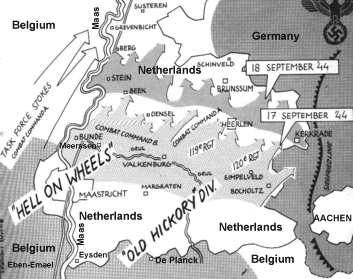

sept. 14th, 1944 The first American infantrymen march from the south down the Daelhemerweg street into Valkenburg.
Picture: Frans Hoffman
On June 7th, 1944, the day after D-Day, the first men of the 19th Corps of the US army landed on european soil. Three months and seven days later, the 14th of September, a little unit of that corps would arrive in Valkenburg.
The 120th Rgt. of the 30th Infantry Division (Old Hickory) of the 19th Corps of the First US Army was employed 6/14/1944, when they took over the central sector of the American front on the peninsula of Cherbourg. In addition to its own artillery, tanks, engineers, scouts and the like, in those days the 19th Corps still consisted of the 29th and 30th infantry division. During exactly 101 days, this corps would participate continuously in the struggle, until the 15th of October, when they contacted another division near Aachen, the first German city they reached. In these 101 days they advanced against Germany, sometimes suffering very serious losses , from their disembarkation point in Vierville-sur-Mer on the french west coast. On this way they also mopped up Valkenburg from Germans on September 14th.
As mentioned above, the time from the beginning of June until the middle of September 1944 was of many suspense. In the beginning, when the English and Americans granted themselves the time to settle a good bridgehead on the European continent, many feared, this situation could be going to last for a long time. In the opinion of the population, the allied offensive of course went too slow, but in fact, once it was in full swing, it went with an insane speed:
On June 6th, more than 132.000 soldiers disembark on French soil, the battle of Brittany is long and it costs thousands of lives. Paris falls the 26th of August, at the same day the 19th Corps near Lille almost reaches the Belgian border, Brussels is liberated on September 3th, Antwerpen one day later. On September 2nd, the right wing of the allied forces, that advance against Germany, including the already mentioned 19th US Corps, already reached the Belgian town of Tournai, but was forced to wait there for a couple of days, until the lines of supply would be recovered. On September 8th a cavalry reconnoitring unit, after crossing Southern Belgium, reached the Albert canal, near the Belgian-Dutch border. On September 10th the renowned fort Eben-Emael fell into the hands of the Americans without a blow. The bridges over the Maas and the Albert canal however all were blown up. The allies built an own bridge over the Maas near Liège to avoid slowing down the advance. Also in the section of the 19th US Corps a bridge over the Maas was built. The infantry immediately put it into use. On September 12th the Americans put the first foot on Dutch soil and dislodged the Germans from Noorbeek and Mheer. On September 13th parts of the 30th Infantry Division, the so called Old Hickory Division, penetrate into Eysden, Gronsveld and Wijk, a suburb of Maastricht. On September 14th Maastricht-West follows. This is the day, a historical one in the history of the little town upon the Geul, that Valkenburg welcomes the first Americans.
Jan Diederen writes in Mijn oorlog en bevrijding (My war and liberation): “Valkenburg is liberated by the 119th regiment of the 80th Old-Hickory division. But on Saturday evening September 16, 1944, when the 119th regiment has already progressed to the line Geneindestraat-Reinaldstraat in Valkenburg, the Second Armored Division also connects to the left wing (west side). The Old-Hickory Division is an infantry division and the Second Armed Division is a tank division. Supporting each other (see map above), they have to liberate the rest of South Limburg north of the Geul line. In Valkenburg itself, the tank division, because of its clout also called Hell on Wheels, did not participate in the fighting. Because of the rationing of the petrol - the army units involved in the Operation Market Garden are given priority - they therefore arrive at the Geul front later than planned.
Fallen in Valkenburg at the Old Hickory and the 2nd Armored
Jan Diederen schrijft in Mijn oorlog en bevrijding: „Valkenburg wordt bevrijd door het 119de regiment van de 80ste Old-Hickorydivisie. Maar op zaterdag-avond 16 september 1944, als het 119-de regiment al tot de lijn Geneindestraat-Reinaldstraat is gevorderd, sluit op de linkervleugel (westkant) ook de Second Armored Division aan. De Old-Hickorydivisie is een infanteriedivisie en de Tweede Gewapende een tankdivisie. Elkaar ondersteunend (zie kaartje hierboven) moeten zij vanaf de Geullinie de rest van Zuid-Limburg bevrijden. In Valkenburg zelf heeft de tankdivisie, vanwege haar slagkracht ook Hell on Wheels genoemd, niet aan de gevechten deelgenomen. Door rantsoenering van de benzine – de legeronderdelen die betrokken zijn bij de slag om Arnhem krijgen voorrang – arriveert zij daarom later dan gepland aan het Geulfront.Gesneuvelden in Valkenburg bij de Old Hickory en de 2nd Armored
The Liberation of Valkenburg 

“September 1944. South Limburg liberated.
I have been asked to write something about our liberation.
Therefore this sketch:
A person in hiding in Valkenburg no longer could stand all those liberation rumors. He disappeared and in the evening he came back with a story. He had been with Americans in Margraten. They wanted to know everything about the bridges over the Geul. He referred them to his boss, “the subdistrict leader of the resistance” who would knew everything about it. The person in hiding was sent back to me with the request to wait for an American officer early in the morning on Daelhemerweg near Sibbe. The password was “Steeplechase”.
Well, I did so with my hiding person. The American was there. At his question I said “On the Cauberg side of the Geul, no more German bridges, all but one destroyed, on the other hand still Germans the only bridge is undermined and guarded.”
The officer started talking in a walkie-talkie, after which a row of jeeps with soldiers appeared. They would attempt to get hold of that bridge.
In two groups, we went down to the Grendelplein. There I warned the few persons who were on the street, not to be noisy. Everything had to be done in silence. (The population was in the caves).
A group went behind the houses in the direction of the school, to get the German bridge guards at gunpoint. The other group went towards the church tower, from where they could see the bridge over the wall of Den Halder castle.
However … in the night, Germans had chosen quarters in the dancing Pavillon, who saw our Americans and … the bridge went up! Only the Cauberg side of the Geul was now liberated. The other side of Valkenburg still had to wait.
, while also the mining area was liberated a few days later, due to this unsuccessful “bridge conquest”.
This was the “front-experience” of Paul, sub-district leader of the L.O. in R8218.”
The center of Valkenburg on Open Street Map
The weekly “Het Land van Valkenburg” wrote on September 13, 1974:
“Mr. Pierre Schunck after thirty years on the bench on Daelhemerweg, where he had an appointment with the American patrol, which was going to take Valkenburg.”
In the morning of September 14th, 1944 Valkenburg is very quiet. The approaching troops make that the few, who haven’t sought safety in the caves, remain indoors.
Since several days all sorts of rumours go the round. The greater part of the German troops have been retired. Only a handful of Germans remain in Hotel Oda, to watch over the only bridge that’s not yet blown, near Den Halder Castle. Early in the morning two men in civilian clothes go up the Daelhemerweg street (→picture above). The day before they searched contact with the Americans, who invaded until De Planck at the Belgian-Dutch frontier. One of them informed the Americans on the the state of affairs in Valkenburg. Today a US patrol will come to Valkenburg. At the bench, a little bit further up than the coal-mine imitation, they will meet. The agreed password is “Steeplechase”.
On their way up they spy along the road. There is an American sitting on the bench indeed. “You want a cigarette?”, he asks.
“I like steeplechase”, Pierre Schunck (38) from Valkenburg answers. In the resistance he is only known as “Paul Simons”.
“I’m captain Sixberry”, the man on the bench says. He clearly wants to know, how many Germans remain in the little town and where they are. He has got an ordnance map upon his knees. Schunck indicates: “At this side of the Geul no one is left. This bridge is the only one, that is still intact, but it is undermined and guarded from Hotel Oda, over there. Possibly there are still some Germans left in the Casino dance-hall too, at this place. Moreover there’s still German traffic from Meerssen via Houthem to Valkenburg and then via Heerlen to Germany.”
The American is accompanied by some soldiers. They are hidden in the vegetation on the banks. Most likely their number is bigger, than the man from Valkenburg guesses now. They have the disposal of a walkie-talkie, the first one, that Pierre Schunck sees in his life. The soldiers pass on the gathered information. There-upon from the other side the briefing follows: try to gain that bridge over the Geul without damage. This should happen by surprise by means of a pincer movement.
Schunck beckons his companion l’Istelle (23), a young man from The Hague, who is in hiding at his’, to come nearer. They deliberate for a moment. The Americans retire and come back in a queue of open jeeps, with fixed machineguns. The engines are switched off, they make use of the incline of the Daelhemerweg Street to approach in total silence.
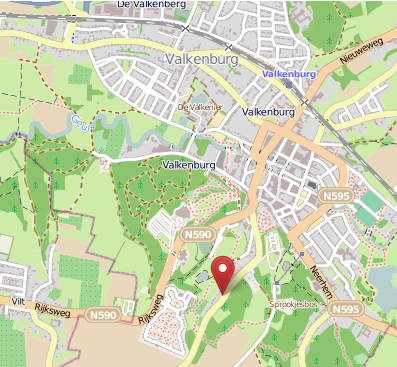 Click on the overview map for a bigger one (Open Street Map). The woods on the southern edge of Valkenburg coincide with the southern slope of the Geul valley. The red arrow is situated halfway on this slope, on the Daelhemer Weg road. During a couple of days, the Geul creek is frontline. See text.
Click on the overview map for a bigger one (Open Street Map). The woods on the southern edge of Valkenburg coincide with the southern slope of the Geul valley. The red arrow is situated halfway on this slope, on the Daelhemer Weg road. During a couple of days, the Geul creek is frontline. See text.
In the first one there is only a driver.The captain and his men take place, but they put Pierre Schunck in front, on the hood. Because they still don’t trust him? Later you wonder things like this. At the moment they slowly roll down towards Valkenburg, every nerve strained to the limit…
They intend to form two groups: one with Schunck, the other with l’Istelle as a guide. On the Grendel Square Pierre Schunck sends some of the people who are there past the houses with the the urgent request to remain absolutely silent and above all things not to start jubilating. Everybody abides by that.
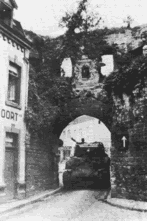
The two platoons go ahead. Schunck and “his” soldiers enter the medieval part of the town through the Grendel Gate. In the Munt Street they enter Hotel Smeets-Huynen (today “Edelweiss”) and leave it laconical through the back door, leaving a perplexed family Smeets. Some soldiers ascend the church-tower, in order to cover the bridge with their machineguns from there. Pierre Schunck accompanies the officer, who is equiped with a periscope. From the brewery Theunissen (later demolished) however, they don’t have enough view, due to the rather high wall of Den Halder Castle (later demolished too). Along this wall they sneak to the low wall on the bank of the Geul. With his periscope the American sees a German soldier on the bridge walking up and down. Pierre Schunck is allowed to watch for a moment too …
In the meantime a couple of jeeps, with heavy machineguns fixed and the engines switched off, are pushed forward and stand between the hotels Neerlandia and Bleesers. From there a small group of soldiers goes with l’Istelle along the back sides of the houses to the protestant church, through the gardens of Hotel Cremers (l’Ambassadeur) and the house Eulenberg (later “Texas Bar”), to Hotel Prince Hendrik. Another group tries to reach the banks of the Geul via the yard of the school at the Plenkert street.
As soon as these two groups will reach their destination, snipers will try to surprise the Germans, in order to prevent them from initializing the blowing of the bridge.
Hotel Croix de Bourgogne, destroyed when the retiring Germans blew up the bridges next to it. September 1944. View from the Grotestraat
The plan was to advance quietly to take the only bridge over the Geul, which was still intact, before the Germans would blow this one too. It was the bridge at the Wilhelminalaan. The Germans let it intact as long as possible to allow their own troops to escape. This attempt failed by treachery by a Valkenburger who collaborated with the Germans. He warned the Germans, as the Americans, creeping from tree to tree, had almost reached bridge.
In the last minute the explosive charge, which was fixed under the bridge, was fired. This event delayed the advance of the American troops by three days.
In the book D-DAY IN ZUID-LIMBURG, De bevrijding van uur tot uur, van plaats tot plaats. (D-Day in South Limburg, liberation from hour to hour, from place to place) by Jan Hendriks and Hans Koenen we read:
Initially, the Americans used the Wilhelmina tower on the Heunsberg as an observation post. But after a German direct hit had knocked a huge hole in it, it had become useless. Although they were well aware of the hostile positions, thanks to information from the Valkenburg resistance, they could not do a lot against them in the long run because their artillery had a lack of ammunition. And because of bad weather they could just as little count on support by the Air Force.
The 119th regiment lost 24 people on this day. Seven were killed, 17 were injured, most of them in Valkenburg by hostile artillery fire. 73 prisoners of war were made.
The weekly newspaper Het land van Valkenburg wrote on Friday, September 13, 1974:
On September 14, 1944, the Americans entered the land of Valkenburg
Thirty years ago, the Geul line became a bigger obstacle than anticipated
The plan (to conquer the undamaged bridge) is not successful. The Germans perceive their enemies in Hotel Prins Hendrik. Perhaps they have been warned from the Pavillon dance-hall, because there are German guards as well. The last bridge over the Geul explodes with a terrible uproar. The scraps fly around Schunck and the American officer behind the little wall. The plan failed in the last moment. Now the Geul temporarily becomes front line.
The staff of the battalion, that captured Valkenburg south of the Geul, arrives in the course of the day. They settle their command post, led by Colonel Beelar, in the cellar of the shop Bours on the corner of Wilhelmina Alley and Plenkert street. Their mission had been, to advance from De Planck (Belgian-Dutch frontier) and Noorbeek and to cross the national highway Maastricht-Aachen towards Margraten, Sibbe and Valkenburg. Now they had to cut off the way to the German traffic and after that to wait for the falling of Maastricht into allied hands.
What did the organisations L.O, K.P., O.D. and R.V.V.?

For a correct understanding of the liberation day in Valkenburg, it is necessary to know which organizations were meant by the not always applicable name “the resistance”. Because in Valkenburg there were and are rumors about “disagreement within the resistance” concerning the execution of the Nazi collaborator (see the next chapter).
After the German troops had occupied the Netherlands, it started everywhere almost immediately with forms of civil disobedience. The first forms of organized resistance could mainly arise where people were already organized and therefore had functioning networks. Often within organizations that were soon forbidden by the Germans. The three main groups were:
- People with a religious background. From these groups came the L.O. (National Organization for Aid to Hiders) often mentioned in this story and the associated armed fighters (Knokploegen, K.P.). One of the roots of the L.O. in Limburg for example, was the aid to French prisoners of war escaped from Germany, who came to Limburg in large numbers from the beginning of the war, and the Catholic Action. The special feature of L.O. and K.P. was that they could still use those ecclesiastical networks during the occupation, because they remained largely intact.
- The members of trade unions, social democrats and communists. During the occupation they and the KP often made use of the infrastructure of companies together, for example in Limburg, of the telephone network of the Provincial Limburg Electricity Company PLEM. From this group came the R.V.V. (Council of the Resistance).
- The former soldiers, demobilized in 1940, often still felt bound to their oath of allegiance and began to organize by means of their networks. Out of these groups came the O.D. (Order service).
After the war, these three organizations were merged under the name Nederlandse Binnenlandse Strijdkrachten (Dutch Domestic Forces), B.S.. But that didn’t work very good. The O.D. men often had the tendency that they as professional soldiers now had to take the lead. In the Netherlands at that time, ideological items played an even greater role than now, and after the war mistrust soon arose between conservative professional soldiers or religious people and, for example, communists. The cold war was coming. But during the occupation, cooperation at least in the district of Heerlen, to which the subdistrict of Valkenburg belonged, was usually excellent. The L.O. could, for example, use the telephone network of the P.L.E.M. A crashed English pilot, dressed as a firefighter, was brought by the Heerlen fire brigade from Valkenburg to the L.O. people to the hospital.
The activities of the Valkenburg L.O. are amply highlighted in this account. The R.V.V. played no role in Valkenburg. But what was the O.D.? That is important to know, before we discuss in the next chapter the events at the monument on September 14th, 1944, the day of Valkenburg’s liberation.
The O.D.
Learn more about this organization in Limburg, if you can read Dutch:  Chapter 8, De Ordedienst, from Het Verborgen Front by Fred Cammaert. The following is largely derived from this book, except for the part about Valkenburg.
Chapter 8, De Ordedienst, from Het Verborgen Front by Fred Cammaert. The following is largely derived from this book, except for the part about Valkenburg.
Groups that would later form the OD were established in many places in the Netherlands by demobilized soldiers, especially professionals. They had a variety of objectives, some of them included resistance. Within this profession, a conservative and anti-communist life philosophy predominates. So also in the O.D. groups. Thus the main objective, which was also expressed in the name, was to maintain public order during the power vacuum that would occur shortly after the liberation. This included arresting collaborators but at the same time preventing revenge actions. A revolution was feared, as it had not only taken place in Russia after the First World War. There had also been attempts in the Netherlands (Troelstra).
The demobilized professional soldiers were the first in Limburg and also in the neighboring part of Belgium to commit organized resistance of some magnitude. And it was they, too, who had to put up with the first blows. The heaviest one was the Hannibalspiel, the German code name for a large-scale infiltration into the cross-border resistance. You will find a lot of information about this in the book Grenzeloos verzet Borderless resistance – On Spying Monks, escape lines and the “Hannibal Game”, 1940-1943, ISBN 9789056220723.
Not all OD groups can be assigned to the resistance. There were also those who only focused on their self-intended task after liberation.
In Maastricht, three O.D. groups had emerged during the occupation, one of which later joined one of the two others. The resulting rivalry (which group is the “right” one, so who must obey whom) was partly inherent in the hierarchical way of thinking among members of that profession.
Another problem, which apparently also emerged in Valkenburg, Dr. Dick Schoonoord describes in his study of the activities of the Dutch Military Authority in the transition period after the Allied liberation of the Netherlands (Het ‘Circus Kruls’, Militair Gezag in Nederland, 1944-1946, – The ‘Circus Kruls’, Military Authority in the Netherlands, 1944-1946, Amsterdam 2011) in chapter 3 “Maastricht liberated” p.119:
The OD had prepared to exercise military authority and was ‘initially a little recalcitrant.’ There appeared to be a lot of zeal between old OD members and those who had just joined after the liberation; they could not be counted among the ‘best elements’. Many young people acted unauthorized and behaved undisciplined.
… Hundreds of NSB (Dutch nazi’s) people had already been arrested in the city and the heads of countless women were shaved, but there was no bloodshed. Many municipal officials had already been purged by the mayor and aldermen and some judges had been arrested. On the initiative of the O.D. a committee was already busy with preliminary investigations into the arrested NSB members.
So as in most places, it was also in Maastricht the O.D., who saw it as a part of their order-job to arrest Nazi collaborators. Germany was not yet defeated and there was fear of sabotage. The old members and undisciplined young people disagreed on the way in which that had to happen. This was, looking closely, not a disagreement within the resistance, because those new members had never been with the resistance and the old members only partially. What the O.D. can be blamed for that they were too uncritical in their recruitment in order to get as fast as possible to high membership numbers. In Maastricht, for example, criminals also joined in because of the weapons.
Pastoor Steegmans van Sint Pieter walgt van het gebeuren: Is het niet af te keuren dat aan het ophalen (van NSB-ers) werd deelgenomen door mensen uit de onderwereld? Dat horloges, gouden ringen, handtasjes enz. eenvoudig werden geroofd? Dat bij vele vrouwen en meisjes de haren werden afgeknipt zonder enig onderzoek naar schuld? (De bevrijding van Eijsden-Margraten in september 1944)
De OD in het district Maastricht werd met ingang van 13 oktober opgeheven. De OD-ers werden grotendeels opgenomen in Grensbewaking van de Binnenlandse Strijdkrachten.
Also in Heerlen, where Ben Koster worked, the O.D. was founded by former professional soldiers like the later firefighter commander Bongaerts († November 23, 1944, Camp Neuengamme, also a victim of the Hannibalspiel) with the intention to maintain order after the liberation. But besides they have done very good resistance work in collaboration with the LO. When Valkenburg was liberated, however, Heerlen was still in German hands.
After the liberation of Heerlen, the local OD did not make it that bad there, but here their leaders too were mainly busy recruiting new members, which did not benefit the quality. Cammaert writes about this in chapter 8:
Willemsen succeeded in recruiting more than three thousand men. Like in the other South Limburg districts, they were used for security services, clean-up work, controls and patrols. The hasty and subsequently taken back command of September 29, 1944 in which Prince Bernhard ordered the dissolution of the O.D., caused great unrest in the Mining Region.
The provisional headquarters of the new Dutch Domestic Forces in Brussels had a clear preference for the K.P / L.O.
Following the example of Maastricht, also in the District of Heerlen the OD was officially dissolved on October 23, 1944.
The self-proclaimed Order Service, which in Valkenburg has formed itself only AFTER the liberation, can already for this reason not be counted among the resistance in this city, but rather among the “undisciplined young people” mentioned above.
They also shaved so called Jerry whores, young women who had a German friend (or sometimes a customer). According to th Dutch Wikipedia, also resistance fighters have participated in this type of revenge practically everywhere. Unfortunately, the question of which groups that were is not further elaborated, except for the more general expression ‘O.D. and B.S.’.
Allegedly a police officer has said that my father had given the order for this shaving. Was this policeman present when this order was given? There were many rumors and the police were on the Emmaberg in the not yet liberated part of Valkenburg. But especially this: it would be at least remarkable if the leader of the resistance gave this order to a group that just beore almost killed one of his people. And anyone who knew my parents knows that they were the very first to extend their reconciling hands to the N.S.-members in our family immediately after the liberation, following the words of Jesus: “Let him who is without sin cast the first stone” And „Go and sin no more.” (John 8:7-11) to a woman he had just saved from lynch justice. I mention this because for the chistian movivated resistance, this was very essential.
Such disgusting very humiliating scenes occurred everywhere in the former occupied territories after the liberation from the German troops. Moreover, it has only hit the women and often the wrong ones. Love is not a crime. Justifiable by nothing. I would repeat that even if it were proved beyond doubt that also the L.O. of Valkenburg has participated in this. On the other hand, it is also understandable, after all the violence perpetrated by the Nazis, and compared to that it was quite innocent.
Killing people for revenge however is something else.
The murder of the Nazi collaborator

In the small town of Valkenburg, something happened on the day of the liberation, which still heats the mood to the present day, more than three-quarters of a century later (i.e., more than 3 generations). The result is that many people prefer not to talk about it and some call it “the Valkenburg taboo”.
It’s about shooting the Dutch Nazi Alfons Savelberg (DB). There are still two bereaved relatives’ camps, those of Savelberg on one side and those of the ones who did it on the other. And of course the large majority, who because of that silence don’t really know what exactly happened. This also applies to the aforementioned relatives. I want to change that. I do not belong to either of the two groups of bereaved families – even though some insinuate that – and only want one thing: to the extent that it is possible, to get the truth to light and above all to put an end to all rumors, vague suspicions and half truths. Because that is the only way the bereaved families can finally talk openly about those things. In South Africa they had a truth commission after the end of Apartheid. Maybe Valkenburg needs that too.
That is why I give you a summary of the facts, as they have been confirmed by sources, but also here and there my interpretation of them, in which I weigh the statements as to their plausibility. Because there are assertions in some publications, which provable make no sense and can only generate new bad blood. The dear readers must then see for themselves whether they can follow me in this.
And: we may estimate, but not condemn.
Along with the Americans came a former hider, who later would be accused for theft of allied military goods. In the report of the Investigation Service of the Military Authority in Valkenburg on February 2, 1945, he is called Johnny Kruyt or Kruyf. In September there was nothing known about this. After his arrival in Valkenburg, he began to organize a manhunt for real and alleged members of the N.S.B. party and he claimed to act on behalf of the Americans. The group that carried out this manhunt called themselves O.D. or Order service. Click for a better understanding of what the O.D. and especially what he was NOT, on the adjacent proclamation. It is unclear to what extent the original O.D. had anything to do with the group in Valkenburg at all.
Meanwhile, a crowd had gathered at the square called Grendelplein. A member of the nazi organisation landwacht was going to pay for everything, what the Nazis had done. (The Landwacht was an auxiliary police, consisting of members of the Dutch N.S.B.. See https://nl.wikipedia.org/wiki/Nederlandse_Landwacht) This landwachter was brought to the Americans who handed him over to the Dutchman, who had arrived with them, with the words “Kill him”. After all, he was a Dutchman. So the present citizens of Valkenburg presumed that all this was done at the order of the Americans and the landwachter had certainly done evil things. But also Willem Freysen (DB), the above-mentioned member of the resistance, who vehemently swindled at the allotment office in Valkenburg under the mask of Nazi friendliness, was arrested by these people. This is a clear proof that they had no connection to the resistance in Valkenburg. Pierre Schunck, who was hastily summoned, was able to convince this group of Freysen’s innocence. The landwachter Savelberg was less fortunate because he was indeed a collaborator.
Meanwhile, also Father Ferdinand (DB) of the “Fathers on the Cauberg” monastery arrived on the scene. He also negotiated with this group, also without result. During the war, he had worked with Pierre Schunck in the resistance and so it makes sense that they now tried together to save Savelberg or at least obtain an honorable burial for him.
on the Cauberg in Valkenburg, after the liberation. The first picture shows the lower end of the Cauberg, seen from above. In the background, we see the monument, where landwachter Savelberg became the victim of lynching.
These photos are part of the estate of Pierre Schunck and Gerda Cremers. They were probably taken by the photographer Frans Hoffman, who took most of the photos during the liberation in Valkenburg.
Below are some quotes that show this. The story of the rescue of Willem Freysen was told to us, the Schunck children, by our father. From the report of February 2nd, 1945, from the Investigation Service of the Military Authority by detective A. C. van der Gronden, member of the LO during the war himself:
Immediately after the liberation, he (Harings) supplied himself with weapons and knew nobody anymore of those who had helped him. He promoted himself to a leader, which led to the fact that Alphons Hendrikus Savelberg, b. November 6, 1917 in Valkenburg, landwachter, was shot. Johnny Kruyt or Kruyf, who is currently imprisoned because he probably committed theft of Allied army goods was in hiding and seems to have come with the Americans from Belgium. He ordered that Savelberg be shot, for which Harings volunteered. He stood 10 to 12 meters away and shot three bursts with a repeating gun, an estimated 12 to 15 shots, after which Savelberg fell to the ground, was still alive, and then got a few more shots in his head. This Harings did not know how to operate the weapon, because about an hour before he had asked a former sergeant for information and about it. This drama took place on the Grendelplein surrounded by adults and children on 14 September 1944. It was a true martyr’s death of the landwachter.
Some older Valkenburgers still remember Father Ferdinand ss.cc. (Jan van Westerhoven, 1934-1987), the superior of the Cauberg, with his characteristic voice and face. He was friends with my parents, the couple Schunck-Cremers. During the war, the monks’ cave, behind the monastery, was used by the resistance, among other things, as a shelter for a stolen German army vehicle. From his memories:
I then spoke to the people who I thought were in charge, including a Dutch-speaking young man who acted as a commander. His name was “Das”, as I heard later. A man I also remember from the trial afterwards in 1945 in Maastricht. I pointed out to him that such a thing could not be done without a correct and valid lawsuit, on which I was told that the person concerned, Alphons Savelberg, had been convicted of a court formed by the Americans, but that the judgment had to be executed by Dutch resistance fighters.
…
I then went to Alphons Savelberg next to the monument and after an introductory conversation I heard his confession. Then I urged him to publicly distance himself from National Socialism and his collaboration with the enemy, so that he could at least be buried honourably. He agreed and I called on Messrs Pierre Schunck and Ben Koster, on which he expressed his regret before the three of us.
O.D. people and one person who was in hiding before, some days after the liberation of Valkenburg, september 1944. The Heidegroeve on Plenkert street?
Was this the group that hunted for collaborators? In any case, Jan Harings is standing in between, with the number 1 above his head.
Not in the picture: Ben Koster, although he was sympathising with the O.D.. But not with this kind of?
Photo: Frans Hoffman
Thus, these three men worked together, albeit with little result, for Savelberg. Pierre Schunck as leader of the resistance, father Ferdinand, also a member of the resistance, as spiritual assistance. This is not a prove, but because I knew both of them, I know that as convinced and well-read Christians, they knew the words of Jesus: “Let him who is without sin cast the first stone” And „Go and sin no more!” as mentioned already above.
And Ben Koster? He writes in 1946 in “Neerlands Partisanen” (Dutch partisans) on page 147 about this event:
“I also witnessed an execution myself. A landwachter, who had been arrested, was summarily shot by a Dutch young man. This, incidentally, was not in accordance with the guidelines given by our government.”
This is a cautious disapproval: not from the OD as such, but from the event. He was apparently pulled back and forth between his loyalty to the O.D. and his disapproval of what happened (even if that disapproval came only after it turned out that this had NOT been the execution of the verdict of a court martial). To the best of our knowledge, he has not written about it. Out of shame or repentance or whatever, we do not know, we can only rely on what he himself has written, but that is quite a lot:
He was an advocate of the O.D. and maybe a member, as evidenced by his articles and comments. (“Criticism of the O.D. is criminal and highly unhealthy” in De beste stuurlui, Limburgsch Dagblad 09/22/1944) But he meant the O.D. of Heerlen (where the LD appears) and not the “undisciplined young people” in Valkenburg. Sure, he had nationalistic prejudices against the Germans, and what he wrote about women would be impossible nowadays.
But that does not mean at all, that he is an advocate of lynching. He is also not in the photo of the group around Harings in the entrance of the cave, who also called themselves O.D. But he is in the other one, with the Health Inspection Group of the Military Authority and Pierre Schunck, who brought this group to Valkenburg, and who brought as well large and a small truck full of food for the people in the caves (see Food for the caves).
What does that tell us? If one then wants to use all these photos as silent witnesses for the events of those days, then one must do well and pay attention to such details, and less to where exactly those photos are recorded. Because they went to every cave where people were hiding.
Anyway, the quotation above from Father Ferdinand does NOT show that one of these three men had any role in Savelberg’s execution, as concluded by drs. S. from it, except that they enabled him to have an honorable burial.
That the resistance in Valkenburg had nothing to do with this lynch party is above all apparent from the barely prevented execution of Freysen. Also the fact that Harings, the shooter, didn’t even know how to hold a gun, and that he got it from the USAmericans, not from any resistance man, is significant. The original O.D., which after all considered itself a military organization, consisted for the most part of former (pre war) soldiers, not of boys like Jan Harings. Furthermore, the armed part of the resistance – the K.P. under the leadership of Bep van Kooten – was in Ulestraten, a village that was still in German hands. From the words of father Ferdinand it appears that at that moment there was no doubt that all that the execution wa ordered by the Americans.
Yet it probably was later a embarrassing reminder for the resistance and especially for the L.O., because they were unable to prevent this senseless murder. Because the objective of the L.O. humanitarian aid was the only possibility of actively participating in the fight against fascism. The resistance was well aware of their own military weakness and moral strength. Let us remind once more of the attitude of the religiously motivated resistance in Limburg: The local clergymen and secretary Moonen received constant visits from illegal workers and were consulted on almost all serious moral matters, such as liquidations. They emphasized many times again that the aims pursued, if at all possible, had to be achieved in a non-violent and humanitarian manner..
While the objective of the O.D. follows clearly from the above proclamation.
The real Valkenburg resistance has never distanced itself from this lynch murder and has not had to distance itself. As the old resistance fighter and investigator Van der Gronden put it: “It was a true martyr’s death of the landwachter.” (See above) They simply had nothing to do with it. And everyone knew that. Apart from a historian, whose name I am not going to mention here, for not to promote his writing, he also thinks that he can blacken people with insinuations that are based on nothing but his own ignorance.
Open questions
Harings has been acquitted of the murder of Funs Savelberg. “In good faith” the judgment says. Because he was under the assumption that Savelberg was legally convicted by a court martial. It remains strange why he did not request written proof thereof. But indeed, the real culprit is of course the one who gave the order. Was that the American who said “Kill him”? In his case, we must remember that since his landing in Normandy he must have seen countless deaths among his friends, but also among German soldiers. And then such a young guy is suddenly asked: “What shall we do with that traitor?”
Or was it Johnny Kruyt or Kruyf as he is mentioned in the report of the Investigation Service of the Military Authority of February 2nd, 1945? And where did he go? Has he ever been called to account? And who was Mr Das, about whom Father Ferdinand writes? Perhaps Das was the pseudonym of Johnny Kruyt or Kruyf, as many had one at the time?
The rest of the papers about that process can no longer be found. During that time, more was lost. Or did someone find the whole thing too embarrassing?
The result is, in any case, that people can now speculate to their heart’s content. They just say something, the opposite is hard to prove. With that, they can even sell books, even if that stands in the way of coming to terms with these events and burying of the hatchet.
And yet that gradually it is about time.
I don’t want to incite hatred, quite the contrary. I just want that it stops at last, after 75 years.
After the commemoration of Valkenburg 75 years free, this comment was published in the regional newspaper De Limburger on 09/20/2019, in which the author claims, under the guise of giving a differentiated image, that the anniversary of the liberation was celebrated in an indiscriminate black-and-white form. Nothing could be further from the truth. One of the important objectives during the celebrations in Valkenburg was precisely that differentiated image. Merely by the choice of people who lit a candle there, but also the content of the memorial book. They recalled the children of nazi parents, traumatized after the war, the discrimination on the part of the liberators (of the African-Americans), the German soldiers fallen during the liberation days - the largest group of war victims in our city, the forgotten holocaust of the still discriminated Sinti and other Roma (“gypsies”). And of course the almost forgotten resistance. This way the column puts the organization of the celebrations in the wrong corner of hurray patriotism and black-and-white view.
Attention is paid to a “historian” who has been trying for years to put the blame of the lynch murder of a nazi collaborator on the resistance in Valkenburg. In addition, he confused the resistance with a small group set up on the day of the liberation, which called itself Order Service and even almost lynched a member of the resistance. This historian has been informed that his claims are based on false suspicions, but he maintains that Pierre Schunck, for example, is the one who has ordered the so-called „moffenhoeren“, jerry whores, to be shaved bald.
If you want to learn more about the OD in Limburg and you understand Dutch, go to Hoofdstuk 8, de O.D, van Het verborgen front: geschiedenis van de georganiseerde illegaliteit in de provincie Limburg tijdens de Tweede Wereldoorlog. The complete book
Evacuation

Valkenburg was not liberated in one day because the advance of the US troops on the Geul brook came to a halt for a few days. As a result, between 14 and 17 September 1944, the front went along the Geul through Valkenburg. It was almost entirely evacuated during these liberation days. When elsewhere people went into a bunker or the basement, in Valkenburg they used of course the lime caves, those labyrinths in the soft limestone, which had been created over the centuries from the extraction of lime stones. These caves were in the liberated, southern part of Valkenburg.
In many places in the caves we find inscriptions like this one, scratched or with made charcoal, with the names of the people who have sheltered at this place.
Even before the USAmericans invaded Valkenburg, most of the inhabitants of Valkenburg and some other places in the Geul Valley had sought shelter from the violence of war in the tunnel systems of the former limestone quarries. In the vernacular they are called grottoes.
Jan Schurgers wrote in War Monuments in Valkenburg (Oorlogsmonumentjes in Valkenburg, Kijk op Valkenburg, 4-2013 nr. 2 (mei, juni, juli), p. 4-7).
Many inhabitants sought a safe haven and found it in the marl caves. About 3,000 people stayed in the Gemeentegrot at that time, 1,700 in the Heidegroeve, 300 in the Fluwelengrot, and 200 in the Sibbergroeve.
The eldest daughter of Pierre Schunck remembers :
We, the residents of the Plenkert street, were of course in the mushroom breeding cave called Heidegroeve opposite the brewery. At the end of the war, the Organisation Todt had begun to set up a bombproof factory in the cave. There they had furnished rooms for the staff, which we could use now. There was a room available for each family.”
During these Liberation Days, days of tough hostilities in Valkenburg, the greater part of the population sought safety in the caves at the Cauberg and the Plenkert street. In his booklet “Limburg in den Wereldbrand” (Limburg in the World Conflagration) M. Kemp dedicates the following lines to the difficult and anxious days, that the population of Valkenburg had to pass through:
“Although on September 14th the Americans advanced until Valkenburg, the inhabitants of this part of the Geul valley still had to go through a couple of precarious days. The misery started with the blowing of some bridges over the Geul, with so excessive charges of dynamite, that several houses and hotels were destroyed of it (See photo above). Many inhabitants of the little town found a shelter in the nearby lime caves, but soon the food runned out, they had no light and an unbearable hygienical situation developed. In those days in the caves, whilst the artillery duel in the surrounding woods thundered with full power and numerous shells striked the abandoned houses, three children were born and an old man died a (natural) death. Here the hour of the liberation came not one moment too early!”
See also the article in De Limburger: „In de schuilgrot stonk het verschrikkelijk“ (In the protecting cave it stank terribly)
YouTube: Schuilen in de grotten, Jac Diederen, Dutch & local language “Valkenburgs”. But even if you don’t understand a word, it is worth seeing because you get an insight in the subterranean world of Valkenburg
Food for the caves

For a few days during the liberation from Valkenburg, the Geul was the front line. It flows through the villages (from East to West) Stokhem, Etenaken, Schin op Geul, Valkenburg, Houthem, Meerssen and Itteren. The red lines are motorways. They were not yet built at that time.
But by German artillery fire from the heights near Schimmert the citizens of Valkenburg still can not leave the caves and there is a threat of hunger.
16 Sept 44
The bearer Peter Joseph Arnold is known to us as a friendly ally and is on business known to us. He will will depart for Maastricht and return by 2400 this date.
[Signature]
Capt. ...
(Crop)
On September 16, the American troops in Valkenburg received a message that Maastricht was in the hands of the American army.
A direct connection via Berg en Terblijt or Meerssen was not available.
The valkenburg group of Americans had come from De Planck and Noorbeek, crossing the national road Maastricht - Aachen, to Margraten and Sibbe. That was their job, at least that’s what I was told: First, to cut off the Maastricht - Aachen road from German transports and to wait for the conquest of the city of Maastricht.
They then crossed the Geul and gained access to the provincial road to Meerssen. Valkenburg was thus completely liberated. Then I was asked to go to Maastricht by the road via Berg en Terblijt. For this a soldier with a jeep was given to me. Jean Hendriks informed me, that the Germans had withdrawn from the Geulhemerberg to the north side of the Geul, behind the water mill. On their way, they had attended the cave, where the
population of Berg was. This had given rise to some confusion because people thought they had already been liberated.
The trip by the empty road ran smoothly, even though regularly from the heights near Schimmert came artillery fire from the Germans on the other side of the Geul, and I saw clouds of exploding grenades above Ravensbosch.
In Maastricht we went to the Military Government on Vrijthof Square to find out where we could find the Food Commissioner. At the entrance I was stopped by a soldier in English uniform. He wanted to send me to an overcrowded waiting room. But I went outside again and asked my jeep driver, a heavily armed American soldier, to accompany me. He asked the guard in american English: „Where is your commander?“ Immediately we were led to him, past all the waiting people. I wore the salamander bracelet (symbol of the resistance).
The military commander stood up, sent the people away, and was visibly nervous. I legitimized myself by pointing to the bracelet, as the of the L.O. In Valkenburg, said that the population was in the caves, without food and without medical care and medication. I asked for food and its transport. He said to be able to provide for transport. Besides, he knew that German army stocks had been found in a ceramics factory, and that the Food Commissioner was there to inventorise.
Pierre Schunck wrote the rest of the story later. There he continues:
I found the Food Commissioner in the Sphinx factory. He helped excellently. In the soup kitchen on the Sphinx a number of barrels (cleaned waste bins) were filled with warm food.
The transport proved to be a large truck of the ENCI cement plant. Bread came from the bread factory “Maastrichtse Broodfabriek”, in a van of a local druggist. Thus the food question was settled.
After a couple of days, the Red Cross came along with a doctor, a nurse, some officers and a handfull of journalists.
Later, the food supply was continued to take care of the evacuated population of Kerkrade, which partly came to Valkenburg. When the US Army succeeded in advancing up to the coal district, the German artillery bombardment stopped. The people could leave the caves.
Read more about the evacuation of Kerkrade, and in particular of the hospital, on Dr. Gerd Kreijen, who was gynecologist there. After the evacuation, a part of these people came with Dr. Kreijen to Valkenburg (There are many hotels. In Hotel Franssen was set up a temporary hospital). He was a cousin of my mother and he lived with us during that time.
After the intervention at the Military Authority in Maastricht by Pierre Schunck (right, with hat), this inspection group was sent around the sixteenth of September.
Pierre Schunck wrote:
Inspection by Military Authority, around 16th (mid Sept. 1944) in the caves of Valkenburg concerning nutrition, health condition, etc.
A Kapitein-ter-zee (= navy colonel) Drost had the command.
A doctor from Maastricht was part of the group. It was led around by the municipal foreman Drissen. I should give information.
This picture was taken at the entrance of the Heidegroeve on Plenkertstraat, where people had found shelter against the German artillery shooting too.
Foreman Drissen is the second from the left, with the carbide lamp.
Photo: Frans Hoffman.
Kerkrade destroyed, the entire population fleeing. A large part of the refugees in Valkenburg 

Gerhard (or Gerd, Gerard) Kreijen (Kreyen) was a surgeon and gynecologist at St. Joseph‘s Hospital in Kerkrade.
In the story below, he played an important role as a negotiator, along with Pierre Schunck, the husband of his cousin Gerda Schunck-Cremers. That’s why it is extensively quoted from:
Het geluk van Limburg (The happiness of Limburg) by Marcia Luyten
p. 128
De Bezige Bij, ISBN 9789023496250, € 19,90
http://www.volkskrant.nl/boeken/meeslepende-geschiedenis-van-de-mijnstreek~a4191200/
An exciting book, although you might not expect that from a “history book”. It tells the story of the mining industry in Limburg and the family of Jaques (Sjakie) Vinders.
This story is set in September 1944. The Allied advance
stagnated on the Siegfried Line, the western defensive wall of over 600 kilometers along the German border that extended as far as the Netherlands and separated the Nieuwstraat from the Neustraße right through double city of Kerkrade/Herzogenrath. Thus Kerkrade became a front city. The western part, with Heilust and Spekholzerheide, was liberated by the Americans on September 17th, just like nearby Heerlen. The eastern part of Kerkrade, behind the Miljoenenlijntje (the 12-kilometer-long railway line between Schaesberg and Simpelveld, which had cost 1 million guilders per kilometer during construction), became a front line. First the residents were in their cellars for a week, while cannonballs, mortars and grenades exploded around them. Tap water was no longer there, power lines were broken and the last food had been done for days. The liberators were within reach and awfully far away. The Germans did not just give in. On September 13 they went to coal mine Oranje-Nassau 1. They filled the turbines of the power plant one by one with explosives and blew them all up. The above-ground part of the mine was virtually destroyed. The same happened at the mines Emma, Maurits and Julia. More than 85 percent of the energy supply in the Eastern Mining District was blown up. The residential areas of Kerkrade-East had to become a German fortress that had to reinforce the Siegfried line. On September 25, Kerkrade East was told that they had to evacuate their houses. The order to evacuate came at 4:30 am, and the city had to be delivered empty at noon. Mayor Habets, who resigned in 1941, returned to organize the evacuation. A column of 30,000 people marched on the only main road that the Germans had released, to Ubachsberg and Wijlre.
It was a column like from an African war. Lean, shaky families, with cattle on a rope, bags on their backs and pushing what they could transport on a cart, on the run for violence. People in hiding joined the procession, including Jewish people who saw the open air again for the first time in years. They breathed powder fumes. When the bombing broke out, the procession was still en route. Parents threw themselves at their children.
The only people left behind in the neighborhood were the patients and staff of the St. Joseph Hospital. They couldn’t leave. The Germans had seized the ambulances long ago. The fighting erupted and the hospital was at the epicenter of the shelling. After a night and a day in the line of fire, those who stayed behind decided to leave. Hundreds of patients, some of whom were just operated, pregnant women and women who had just given birth, were carted to Kerkrade-West on hospital beds and even wheelbarrows in which mattresses had been placed. Nurses and doctors pushed the patients while the Germans threw grenades at them. The last German left Kerkrade on 5 October 1944. Two weeks later, the citizens of Kerkrade returned to their liberated but broken city. 240 American soldiers had given their lives there. As a thank you, the square Ambachtsplein was renamed 0ld Hickory PLein, after the 30th Infantry Division Old Hickory of the US Army.”
Dr. Christine Schunck: “After the US army had liberated Valkenburg and Heerlen in late September 1944, their advance was stopped near Kerkrade. The Germans forced the entire population of 30,000 souls to leave the front area. Only the patients were still in the basement of the hospital. Gerd then contacted Pierre Schunck in Valkenburg Head of the resistance there) and they negotiated together with the occupiers to to open a corridor for some hours that would allow to bring the patients away with Pierre’s vans and anything that had wheels. The Kreijen family lived in our house for about two months. During that time, Gerd worked in the temporary hospital in Hotel Franssen in the now liberated Valkenburg, until they could return to Kerkrade.
bidprentjes archief rijckheyt.nl
Allied Killed In Action

Een Britse Hampden AD937 stort in de nacht van 8 juli 1941 omstreeks 1:20 neer tussen de Putweg en de Curfsweg () in Houthem. Drie bemanningsleden komen om het leven: .
A British Hampden AD937 crashed between Putweg and Curfsweg (Open Street Map) in Houthem at around 1:20 a.m. on the night of July 8, 1941. Three crew members were killed: sgt. Glyndwr Owens (DB), flight sgt. Raymond Wordsworth (DB) and sgt. Joseph Frank Walton (DB).
About the fourth crew member, P/O. J.G.N. Braithwaite, Jan Diederen writes in Mijn oorlog en bevrijding (My war and my liberation), p. 33:
He managed to save himself with his parachute, but he was so badly injured that he had to be taken by the Germans as a prisoner of war to a military hospital in Maastricht and thus survived.
The British Handley Page Hampden Mk I AD937 aircraft, which belongs to the 61st Squadron, is on its way to carry out a bombing raid on the railroad station in Mönchen-Gladbach.
This 61 Sqdn. Royal Air Force Volunteer Reserve flew from Hemswell Air Base
On the night of 28 to 29 June 1943 a British bomber crashed burning near Chaloen Castle. (Open Street Map). A Halifax II (Serial Nr: JB907), 78 Sqdn, probably shot down by a German night fighter.
For the names of the Allies who fell in and around Valkenburg, see our database (DB)
Although there was heavy fighting in and around Valkenburg between the 14th and 17th of September, 1944, “only” six soldiers of the Old Hickory Division were killed. They are Quentin Begore and Sam Viviano on the sixteenth, Henri Morgan, John Reeves, Cleaver Buckler and Peter Spoganetz on the seventeenth. All six belonged to the 119th regiment, the part of the Old-Hickory division, which liberated Valkenburg. They were immortalized by Albert Widdershoven in 1994 in the municipal cave. Photo by J.P. Wyers on the website about the 30th Infantry Division Old Hickory.
After the liberation of Valkenburg in september 1944, the war was not over yet. In Valkenburg 75 jaar bevrijd (Valkenburg 75 years liberated) we read on page 155: “On New Year’s Day 1945, a burning Lancaster crashed in a meadow of Maas farm in Vilt at 10 o’clock in the evening.” (Source: Frans Bergsteijn).
Aircraft: Avro Lancaster III, Registration=Serial Number: ME321
Takeoff from: RAF Station Mepal @ 03:48 pm on a bombing mission to Vohwinkel (Wuppertal) to attack railway yard. A successful attack. While overflying the Netherlands, the aircraft went out of control and crashed in Vilt.
Crew: Royal Air Force Volunteer Reserve - Group 3 - Squadron 75 (New Zealand). All eight crew members were killed:
Pilot Raymond John Newton, 28 (DB), pilot Richard Justin Aitchison, 28 (DB), navigator Harry Sansome, 21 (DB), air bomber Arthur Lee, 25 (DB), wireless operator Victor James Clark, 20 (DB), flight engineer John Stanley Hoskins, 23 (DB), air gunner Martin Brennan, age? (DB) and tail gunner Leonard James Cooke, 19 (DB).
Read more: https://www.baaa-acro.com/crash/crash-avro-683-lancaster-iii-vilt-8-killed
April 10th, 1945 – The last victim of the war
Limburg was already free, it was the last month of the war in Europe, when near the village of Vilt the last war victim in Valkenburg fell, on the ridge of the large field on the Geulgracht (Source: Frans Bergsteijn).
The pilot with the rank of a Flight Officer, Theodore F. Lasch (DB), service number T-063074, served with 364th Fighter Group, 385th Fighter Squadron, crashed in a P-51 Lucky Lady VI #4415019 on a mission to Oranienburg near Berlin and is buried in the war cemetery near Margraten (Plot K Row 8 Grave 6)
Awarded: ★ Air Medal ★ Purple Heart.
The 364th Fighter Group flew 342 missions in P-38 Lightnings and P-51 Mustangs from Honington, Suffolk. The missions ranged from escorting bombers, dive-bombing and strafing targets to area patrol missions.
The P-51 Mustang at Wikipedia)
South Limburg is free

Between 1944 and 1946, „Militair Gezag“ (Military Authority) was the provisional administrative body. It had been founded by the Dutch exiled government in London. The provincial M.G. of Limburg was based at the Vrijthof in Maastricht. The note below from the private archive of Pierre Schunck shows how the Military Authority tried to get its difficult task under control.
The resistance people called themselves the illegals.
A study of the Dutch Military Authority during the period after the liberation of the Netherlands, in dutch:
Het ‘Circus Kruls’, Militair Gezag in Nederland, 1944-1946, by Dr. Dick Schoonoord (Amsterdam 2011). With link to the digital book, pdf
Attempt by M.G.
to make the former illegals cooperate in organized way with the Military Authority of general Kruls.
They would be contact officers between M.G. and the population.
Stoottroepen
The Liberation of South-Limburg in september 1944 is not yet the end of the war, which would take in Europe until may. A part of the resistance people, especially of the K.P., entered the army. They were formed to the Stoottroepen and participated that way as soldiers at the defeat of the Nazis.
Lou de Jong wrote: “In Maastricht there were many among the resistance people, whose heart’s desire was to participate in the Allied military operations. That wish was home to most of the members of the KP. How could they be involved? To discuss that question the KP commander of South Limburg, BJC (Bep) van Kooten, went on September 17 or 18 to the headquarters of Prince Bernhard.”
…
“On 19 September he was in back in Maastricht, where he immediately began to recruit, proud of the fact that he, a KP man, not one of the Ordedienst or the Raad van Verzet, had been able to clinch the important function of commander.”
http://de.scribd.com/doc/75776692/Het-Koninkrijk-der-Nederlanden-in-de-Tweede-Wereldoorlog-Deel-10a-2e-helft, page 30 (556)
On September 20th, Bep van Kooten appears at his resistance comrade “Paul” stating that the resistance fighters regroup in the “Koninklijke Stoottroepen” (Royal shock troops) of the regular army and asks “Paul”, to help. Proudly “Paul” promotes it among the L.O. members.
During his trip to the HQ of the new Dutch army in Brussels, Bep van Kooten is appointed Commander of the Limburg shock troops by the Commander-in-Chief, Prince Bernhard. Then Bep engages “Paul” as his officer for human resources. Thus, “Paul” now is responsible for the recruitment of new soldiers. As a man of business, he knows the tricks of the trade.
Appointment to human resources officer of the Stoottroepen (Dutch Domestic Forces in Limburg) by the commander, Bep van Kooten.
Dutch Domestic Forces
Stoottroepen
Commander in Limburg
--------------------
In the field, November 17, 1944
To human resources officer is appointed by me:
P.J.A. Schun[c]k, ID no1918.
Those from whom he asks the cooperation in matters
covered by him, that is all the personal affairs
of the the men of the Stoottroepen, with the exception of armament,
supplies and payment, are requested to grant him this.
His field of activity includes all troops in Limburg.
The Commander of Limburg
[was signed: B. van Kooten]
Continue reading under the picture
And so it happens:
Applications for registration are received, lists are drafted, checks executed, necessary information given, suitable accommodation and workshops are searched, a garage for transport and servicing is recommended! Results of these actions are, among other buildings, the houses Philips and Oranjehof. The relations with the liberators were OK and exist until today! (A friendship for life joined him with Bob Hillecue from Chicago, member of the “Old Hickory” division, that liberated Valkenburg.)
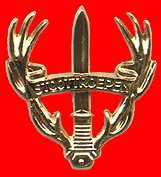
Collar badge of the Stoottroepen
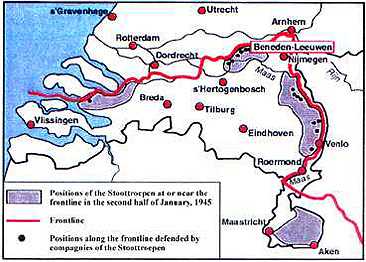
Old Soldiers Never Die. The veterans return 

In September 1984, a number of former members of the Old Hickory division visited Europe and also came to Valkenburg. Report by the Limburgs Dagblad on 09/21/1984:
They left this morning. Direction Schiphol and then the States. Back home. Seventeen days after they started in America on a – what was then called – visit to forty years of liberated Maastricht and South Limburg. A visit, however, that grew into an impressive, moving and sometimes gripping pilgrimage. Or, as EDWARD CIUCEVICH from Savannah in Georgia put it: “A journey that opened old wounds, strengthened existing friendships and forged new ones. Unforgettable! I am grateful to have been part of it”. Part of it. In the Netherlands, in France, in Belgium. Also in West Germany. But above all in Limburg. They left this morning.
Tired, full of impressions. A bit sad and a bit happy. One of them, BUSTER SIMMONS from Burlington, North Carolina, with a frivolité in his luggage. Gift from MARIA “IEKE” SONNENSCHEIN from Heerlen for Bessie-May, Buster’s wife. Another one, EDWARD MELNAR from Ventura in California, with gingerbread cake purchased at Bon Goût in Maastricht. Just some little things. Before leaving, they (again) said goodbye to many Limburgers. Such as EARL DEARBORN from Plymouth, to THEO DOLS from Heerlen. The Yank and the Limburger fought together at the time. Remained friends. Just as their wives, MARION and GEERTJE, are now. Such as ROBERT HILLEQUE from Franklin Park, Illinois, to PIERRE SCHUNCK from Schaesberg. Forty years ago, on September 14, 44, Pierre Schunck led an Old Hickory punch (in some open jeeps with machine guns) along the Daelhemmerweg street from Sibbe to the Grendelplein square, through the Grendelpoort gate, into the Muntstraat and deeper into Valkenburg. Guide Schunck was on the hood of the first jeep. Behind him some Yanks. One of them: Robert Hilleque. Pierre Schunck saw him again a few days ago at Hotel Voncken in Valkenburg. Photographer Theo Gijzen later immortalized them on the market of Kerkrade in front of the miner’s statue “d’r Joep”. Memories, (re)encounters, emotions, stories…
Veterans (NL) and their fallen comrads 

The first day of the war
On 05/10/1940 the conscript Evert Leendert Mirck died in Schin op Geul by a hit of a German tank on the loophole, behind which he sat with his light machine gun. Read more about soldier Mirck: (DB).
The other regular soldiers who fell in and around Valkenburg were English pilots and members of the US Army. See above.
„Voormalig Verzet“, Federation of Ancient Resistants
Also for the former resistance fighters the war would be a unique keepsake in every way for the rest of their lives. Many survived the war, but suffered from a posttraumatic stress disorder or worse. But also those who had been able to handle it better, the need for a permanent contact remained. They met each other at least once a year at the commemorative events at the Provincial Resistance Monument on the Cauberg. Here one feels also united with the resistance fighters, who were killed in action and whose names are written in bronze on the walls.
That list can be found digitally on this website, with each name accompanied, as far as was possible, by a short description and links for more information.
Source of the image: weekly “Het Land van Valkenburg”, Sept. 13th, 1974
No member of the L.O. Valkenburg died. But other citizens of Valkenburg, who have made resistance and the two resistance people, who were shot in Valkenburg.
So the list on the image is to be completed as follows:
- F. A. (Frans) Cobbenhaegen, born on 10/18/1921 in Valkenburg, postal officer, unmarried, arrested (date unknown) in Cologne for smuggling letters to the Netherlands, died on 12/20/1944 in concentration camp Kdo. Langenstein-Zwieberge, Buchenwald, buried Quedlinburg, Hauptfriedhof, 23 years old.
See memorial stone former post office: war victims among postal workers in Valkenburg.
Not a member of the resistance but working at the post and therefore also on this memorial stone:
Hub Vrancken from Houthem. He died after being hit by a shrapnel on liberation day September 17, 1944, when he was so careless about leaving his house to see how the liberation was going. - G. J. (Gerrit) van der Gronden, born 12/13/1895, driver-mechanic, married, took care of Jewish people in hiding, was arrested January 13th, 1942, died January 2nd, 1943, 47 years old.
In Chapter 10, Fred Cammaert writes: “In his garage on the Heugemer Weg in Maastricht he made stencils of De Vonk, the Limburgian edition of De Waarheid (The Truth)”.
At https://oorlogsgravenstichting.nl/persoon/54336/gerrit-jan-van-der-gronden we read:
Born on December 13, 1895 in Dordrecht
Died on January 2, 1943 in concentration camp Neuengamme near Hamburg
Cammaert: Van der Gronden died in the concentration camp Neuengamme on December 5, 1942 (Open Street Map). His brother A.C. van der Gronden was a member of Rayon Valkenburg of the L.O.
See also https://monument.vriendenkringneuengamme.nl/person/401623/gerrit-jan-van-der-gronden - Charles Joseph Nijst, born on March 5th, 1916 in Kerkrade
Died on January 18, 1944 in camp Groß-Beeren, District of Teltow.
He refused to sign a declaration of loyalty and went into hiding, arrested (date unknown) for spreading clandestine printed matter. - Rocks, J. (resistance group Erkens in Maastricht, co-owner of the guesthouse Samos House, later called hotel Atlanta), born on May 21, 1883, arrested in Valkenburg for spreading resistance printed matter on November 19, 1942, died in the Nacht und Nebel camp in Natzweiler (Alsace) on March 3, 1944.
“Bidprentje” (prayer card) of Jan Joseph Rocks:
https://oorlogsgravenstichting.nl/persoon/128452/jan-jozef-roks - F. G. (Frank) Smits from Hulsberg, born on August 29th, 1919, law student, refused to sign a declaration of loyalty and went into the resistance movement (mapped the activities of the Germans at Dutch airports and passed them on to the allies), arrested on August 12th, 1943, suspected of conspiracy and, after a stay in various prisons, eventually sentenced to death by a special court of war for prohibited possession of weapons, shot on 4/4/1944 in Utrecht.
- Jean Caubo from Schin-op-Geul, http://www.caubo.com/index_bestanden/index5.htm#jean
- Gerard Soesman ∗ June 23rd, 1922, mentioned in Erelijst van gevallenen 1940 - 1945 in the group Resistance. His father was Jewish. Died in Auschwitz, date unknown.
- Sjeng Coenen from Simpelveld and Joep Francotte from Vaals were members of the KP South-Limburg, shot on the Cauberg (sept. 6 1944).
Limburgs Dagblad, Tuesday, January 24, 1956
ROERMOND, Jan 23 (Limb. pers)
A bit less than two hundred Limburg resistance fighters founded in the Harmoniepaviljoen (Concert Pavilion) in Roermond a Limburgian division of the “Nationale Federatieve Raad van het Voormalig Verzet in Nederland”, Federal National Council of the Former Resistance in the Netherlands. Appointed to chairman by acclamation was Mr Jac. Crasborn from Heerlen, who presided over the meeting also. The department will consist of three sections, North, Central and South.
Into the section boards were chosen for North: Harrie Hanssen, Venray, Sef Mulders and Leo Jans Venlo. Central: Gerard van Appeven, Roermond; Jan Hobus, Roermond and Sjef de Groot, Heerlen. South: Giel Bensen, Heerlen; Pierre Schunck, Valkenburg and Theo Goossens, Kerkrade. The members of the section boards set up the divisional board. Sjef de Groot and Harrie Hanssen, as members of the national board, have a seat in the section boards. In the same quality Mr. Crasborn will be added to the section board of the Section South. The meeting at the Harmoniepaviljoen, which was also attended by the member of parliament, Jan Peters from Roosteren, was preceded by a wreath laying at the resistance monument at Zwartbroek Square.
…
After the speech of Mr. Crasborn the department Limburg had a very successful birth. The meeting was attended by some members of the main board of the National Federation and by delegations of Expogé (http://www.historien.nl/de-geest-van-het-verzet/) and of the resistance in Nijmegen and Rotterdam. After the discussions the delegation from Nijmegen contacted the board of section North in order to achieve a provisional affiliation of the Nijmegen group to northern Limburg.
Complete naam „Stichting Herdenking der gevallenen van het verzet in Limburg 194O-1945“
De afdeling Limburg werd opgericht op 8 juli 1953.
Hier vindt u de eerste pagina van een update van de statuten.
De Volkskrant schreef op 27 april 2010 over de landelijke organisatie:
Voormalig verzet heft zichzelf op
AMSTERDAM De Nationale Federatieve Raad van het Voormalig Verzet Nederland (NFR/VVN), in 1947 opgericht, heft zichzelf eind juni op. De organisatie heeft nog maar 300 leden, met een gemiddelde leeftijd van 89 jaar′
De NFR/VVN is een federatie van lokale verenigingen van oud-verzetsstrijders. De raad zet zich in voor de belangen van oud-verzetsdeelnemers en hun nabestaanden, alsmede voor ‘een blijvende en waardige herdenking van de gevallenen uit de Tweede Wereldoorlog’. Ooit had de organisatie meer dan tweeduizend leden. De belangrijkste doelstelling van de NFR/VVN is het levend houden en uitdragen van de vrijheidsidealen die de verzetsmensen in de Tweede Wereldoorlog bezielden.
eerste blad Heden, de achttiende juli --------------------------------- negentienhonderd negen en zeventig, verschenen voor mij, --- Maria Joseph Gulielmus Henricus Stassen, notaris ter stand- plaats Valkenburg, gemeente Valkenburg-Houthem: ------------ 1. de Heer Jacobus Renier Peter Crasborn, zonder beroep, --- wonende te Heerlen; en ---------------------------------- 2. de Heer Maria Joseph Arthur Sluijsmans, secretaris van de Gemeente Valkenburg-Houthem, wonende te Valkenburg-Houthem, ten deze volgens hun verklaring handelende respectievelijk - als voorzitter en secretaris van het Algemeen- en Dagelijks Bestuur van de stichting; genaamd: Stichting Herdenking der gevallenen van het verzet in Limburg 194O-1945, gevestigd te Valkenburg-Houthem, ---------------------------------------- welke stichting werd opgericht bij akte op acht juli negen- tienhonderd drie en vijftig voor de destijds te Valkenburg gevestigde notaris P.H.F. Roebroeck verleden, en wier statu- ten gedeeltelijk werden gewijzigd bij akte op twee oktober negentienhonderd zes en vijftig voor de destijds te Valken- burg gevestigde notaris G.P.J.H. Smeets verleden. ---------- De komparanten verklaarden: - dat in een speciaal daartoe belegde vergadering van het -- Bestuur van genoemde stichting, gehouden te Valkenburg- Houthem op tien september negentienhonderd acht en zeventig, overeenkomstig artikel 16 der statuten met de aldaar ver- eiste meerderheid van stemmen van de ter vergadering aan- wezige bestuursleden is besloten de bestaande statuten te wijzigen; ------------------------- - dat, overeenkomstig artikel 11 der statuten, de voorzitter belast is met de uitvoering van de besluiten van het Alge- meen Bestuur en samen met de secretaris namens het Bestuur alle akten en verbintenissen ten name der stichting tekent. De komparanten, handelend als gemeld, verklaarden thans ter uitvoering van het voormeld bestuursbesluit de statuten van de voormelde stichting geheel te wijzigen, zodat deze thans komen te luiden als volgt: --------------------------------- - - - - - - - - - - - S T A T U T E N: - - - - - - - - - - - - - - - - - - - - - NAAM, ZETEL en DUUR: - - - - - - - - - - ------------------------ Artikel 1. ------------------------ De stichting draagt de naam: “Stichting Herdenking der geval- lenen van het verzet in Limburg 1940-1945”. ---------------- Zij is gevestigd te Valkenburg-Houthem. --------- De stichting is opgericht voor onbepaalde tijd. ------------ - - - - - - - - - - - - - - DOEL: - - - - - - - - - - - - - - ------------------------ Artikel 2. ------------------------ De stichting heeft ten doel: het mogelijk maken en doen hou- den van een jaarlijkse herdenking van de gevallenen van het verzet negentienhonderd veertig-negentienhonderd vijf en --- veertig in Limburg bij het monument der gevallen verzetslie- den aan de Cauberg te Valkenburg-Houthem, gelegen op een --- gedeelte van het perceel, kadastraal bekend Gemeente Valken- burg, sectie B, nummer 2545 en wel bij voorkeur in de maand september. ------------------------------------------------- Zij tracht dit doel te bereiken door het inzamelen der nodi- ge gelden bij de gemeentebesturen in wier gemeenten de geval- len verzetslieden woonachtig waren en zo nodig ook bij andere zedelijke lichamen en natuurlijke personen. ---------------- - - - - - - - - - - - - - VERMOGEN: - - - - - - - - - - - - -
Death of an Ancient Resistance Man


From the funeral oration, held by a comrade in arms “Harry” (Theo Goossen (DB)), at the farewell celebration of “Paul”.
He was local leader of the L.O. in Kerkrade and chief of their intelligence service, that informed the Allies about the movements of the Germans. “Paul” provided him with data regarding Valkenburg.
Read here the farewell speech in its entirety.
Mrs Schunck, children and your families! The Resistance people and Stoottroepers gathered here wish to express their thankfulness towards “Paul” Pierre Schunck, also in the name of those who cannot be present:
- for his active dedication to recover our liberty.
- for his great commitment and sincere carefulness
- for his e special chummy attitude
- and all this with his engagement for God, queen and country!!
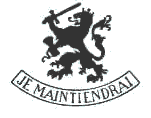
Mrs Schunck, children and grandchildren, it hurts to say goodbye.
… the VERY MANY good memories will strengthen you!!
Resistance comrades and Stormtroopers, we say goodbye to a good comrade.
“Paul” : may you rest in well-deserved peace !
Let’s say goodbye in an honourable way by singing the Dutch National Anthem:
1. Wilhelmus van Nassouwe
6. Mijn schildt en mijn betrouwen
“Harry”, Theo Goossen
No machine-readable author provided. Wilhelmus~commonswiki assumed (based on copyright claims).
Limburgs Dagblad, Tuesday, February 9, 1993, page 13
Last saturday Pierre Schunck was buried on the cemetry on the Cauberg in Valkenburg. He spent his last years in Schaesberg and died, almost 87 years old, in the hospital of Kerkrade. But his heart always remained in Valkenburg. There he was not only one of the founders, late chairman and member of the board of honour of the local public library, late chairman and chairman of honour of the wood-wind and brass band Kurkapel Falcobergia, but also for many years supervisory director of Valkenburg Omhoog. Above all things however, his name will stay well-known as a member of the Resistance Movement during World War II. In his laundry, that was situated a little bit outside the town (Plenkert street), lots of illegal “transactions” were concluded and many persons in hiding were provided with a save shelter.
…
For his heroic role as a resistance fighter, Pierre Schunck was awarded the Verzetsherdenkingskruis (Resistance Memorial Cross). …
One of the american soldiers, who liberated Valkenburg and was in the jeep with Pierre Schunck (see above) specially came from Chicago to attend the funeral. Bob Hilleque, who is 66 years old now (February 9th, 1993) is the only one of the A-company, 1st battalion, 119th regiment, 30th US Infantry Division Old Hickory who survived the war. (Meanwhile Bob died too.)
On September 13, 2019, this commemorative T-shirt was to be seen in Houthem during the celebrations of Valkenburg 75 years free.
A musical tribute to the resistance. This is the theme of the latest work of the artist, composer and musician Tom America (Heerlen 1949). The focus is on the history of Pierre Schunck (1906-1993) and a group of like-minded people who set up a successful resistance group in the Second World War. But the message is universal.
Source: Provincial edition of the daily newspaper De Limburger of Wednesday, September 10th, 2014
Premiere of „In zo een tijd te leven“ (To Live In Such a Time) on September 16th, 2014, the eve of the day on which Valkenburg was freed 70 years ago, in Valkenburg.
Commemorations after the war

 Valkenburg 2019 – 75 years liberated
Valkenburg 2019 – 75 years liberated
In September 2019 it was 75 years ago that South Limburg was liberated. So every municipality has developed its own program. Below you will find a number of photos of the celebrations in Valkenburg. A committee was established long in advance to coordinate the celebrations. A book was published, many of which had cooperated, including the author of this site with a contribution about the resistance in Valkenburg.
On September 13, 2019, during the celebration of Valkenburg 75 years free, this group of look alike American paramedics had lunch in front of the old church in Valkenburg. With their historic vehicles and uniforms, they had the task of giving the whole an authentic look. The real veterans present were also transported with their vehicles.
On September 13, 2019, this commemorative T-shirt was to be seen in Houthem during the celebrations of Valkenburg 75 years free.
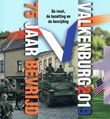
Front of the book “Valkenburg 2019 - 75 years liberated”
75 stories about the invasion in 1940, the occupation and the liberation September 1944.
180 full color pages 21/21 cm.
75 stories, told by people from greater Valkenburg and illustrated by artists from Valkenburg, children of a primary school and / or young people from the secundary Stella Maris College. The book contains many historical photos.
It’s about the resistance in Valkenburg on page 91 ("Valkenburg as an important hiding center"), the story of resistance fighter Harie van Ogtrop during the days before the liberation, told by his daughter Agnes as well as the beginning of the liberation told by Pierre Schunck on p.101. The full text of the latter can be read on this site
A release of the Platform Wereldburgerschap
Order data for this book on this site
Epilogue of Cammaert

How is the resistance in Limburg, in particular the Catholic-humanitarian main component of it, to be considered in national perspective? Although we can see a largely independent development in Limburg, many aid organizations in the country for the discharge of their refugees were depending on the networks in Limburg, networks with an international character which were built up from this province or connected with Belgium, France and even Germany and typically ended up in Switzerland or Spain. Individual refugees, people that wanted to go to England, various intelligence services and other national resistance organizations also used them. The province not only served as a transit area for refugees, they could also stay there. Limburg offered shelter and several groups made an increasingly frequent use of it. Confession did not play a decisive role in all this. In other words, the importance and influence of Limburg at the national level was especially noticeable, where the provincial development was most advanced: the nonviolent humanitarian resistance and corresponding methods and connections. There lay the intrinsic strength and the specific value of the resistance in Limburg.
Sources

- Texts written by Pierre Schunck himself and originating from his private archive often look as if they were written on an old typewriter. And in that case they are. But even if they are hand-written, you can recognize them by the orange line in the left margin.
- Textes, written by Pierre Schunck himself, from his private archive, have an orange underline or in the left margin.
- Especially the early days of the war is to be found in an article from the Auschwitz Bulletin, 1980, nr. 01 Januar of the Nederlands Auschwitz Comité, in English “One didn’t decide to join the resistance”.
Indeed, he had no other choice. - At the NIOD (Nederlands voor Instutuut Oorlogs-Documentatie = Dutch Institute for War Documentation) is an interview that somebody sent to me in a poorly scanned version. It contains in particular the history of the LO in Valkenburg. I typed it and the result can be found on this website.
- The History of Valkenburg-Houthem: A long time safter the war, our parents gave all of us kids a book, in the publishing of which my father, the resistance man “Paul Simons”, was involved, when it’s about resistance and liberation in Valkenburg. Because this book is sold out and the publisher is no longer existing, I do not know whom I should ask for permission to use this chapter.
- The doctoral thesis “Het verborgen front / Geschiedenis van de georganiseerde illegaliteit in de provincie Limburg tijdens de tweede wereldoorlog” (The hidden front / history of organized resistance in the province of Limburg during the Second World War ") of A.P.M. Cammaert is also a major source. An English summary and at the bottom links to the chapters of the original (PDF).
See also the chapter VIII.5.8. Valkenburg or
Het verborgen front, quotes from this book. - Jan (Jules) van Betuw, a comrade of my parents, spoke to me at my mother’s funeral. He had a shocking conversation with my mother. It is about the experiences of the old Jewish couple Soesman-Horn, and how the Dutch government and individual citizens took hold of their heritage. It is shown in its entirety
- From Australia, I got a response that you can read in German here. About Coen Grotaers - one of many
- In his funeral oration for “Paul”, “Harry”, resistance name of Theo Goossen (DB) described the activities of his comrade. He told mainly about the last year of the war. “Harry” directed the "rayon" Kerkrade and he mainly cared for the external relations of the district Heerlen. His relationships and experiences brought Goossen mid-June 1944 to build an intelligence service (ID), to support all the resistance organizations in the region. The first and most important task was to protect the underground people. The service also collected military information. After the Allied landings on the Normandy coast in early June the import of such information was even increased.
- Biographical details about Pierre Joseph Arnold Schunck
This text is a mosaic of different sources, which I have on this item. It is a patchwork of quotations, because they tell different parts of this story, sometimes the same event, but then they are complementary. Here and there they are connected by a commentary of my own. Much has been adopted literally from interviews. Scans of texts written by Pierre Schunck himself after the war have an important place. Whole pages from his memories look like typewriter font. Because that was it. The corresponding scans can be found right next to it, as a miniature. Click for an enlargement.
Also I wrote, what we, his children, can still remember from his stories.
By the color of the margin line at the left you see at a glance whose words these are. If you move with your mouse over a paragraph, the source is displayed as a “tool tip” text. (Does not work on mobile devices.) Literal quote blocks from the interviews have got a darker background (not in the printed version) and are indented. Below follows a listing of the sources, with links, so that you can read the originals as well.
Limburgse monumenten vertellen 1940-1945 Digital name memorial Oranjehotel Jan van Lieshout, Het Hannibalspiel Loenen Field of Honour Markante feiten in Limburg tijdens de Tweede Wereldoorlog Stichting Struikelstenen Valkenburg Roermond Front City Belgium WWII Former concentration camp Natzweiler-Struthof, Alsace The Jewish Victims of National Socialism in Cologne | A–Z Documentation Center on the National-Socialism in Cologne Camp Vught National Memorial The Margraten Boys - About the US War Cemetery
The Jewish Monument When the miners go on strike against the German occupiers Persecuted in Limburg Ons verblijf in het dorp Mergel (dagboek) (Meerssen 1989) Yad Vashem Beelden van verzet Regional Historic Center Limburg War deads in Nijmegen 1940 - 1945 Foundation Dutch Resistance Monument La résistance durant la guerre 1940-1945 Fallen resistance people Maastricht Stichting Herinnering LO-LKP The Forgotten Genocide – The Fate of the Sinti and Roma 1944-2019 ⇒ South Limburg 75 years free! ⇐ Short historic American film about the Divers Inn Database persoonsbewijzen uit de Tweede Wereldoorlog Memorial stone for the resistance people Coenen and Francotte Resistance Memorial of the dutch province of Limburg Call to everyone, but especially to the residents of Valkenburg Roll of honor of the fallen, 1940 - 1945 Grenzeloos verzet The hidden front Forgotten History – Pierre Schunck, Resistance Fighter
World War II in South Limburg Sources Network on World War II (NOB) Institute for Studies on War, Holocaust and Genocide Limburg gaf joden WOII meeste kans Tweede Wereldoorlog en bijzondere rechtspleging Nederlands Auschwitz Comité Secret Army Zone II/Limburg 30th Infantry Division Old Hickory
Bond van Oud-Stoottroepers en Stoottroepers The Dutch Underground and the Stoottroepers
![]()
![]()
Links List Resistance WW2
![]()
83![]()
It is one of the most frequently asked questions: who was imprisoned in the Orange Hotel? Unfortunately, there is no complete list of all prisoners. Much of the prison records were destroyed by the German occupiers shortly before the liberation.
See also Oranjehotel & Waalsdorpervlakte82![]()
![]()
![]()
![]()
A sinister game during World War II of the counterintelligence service of the Kriegsmarine (Marineabwehr), which led to the downfall of three Dutch-Belgian resistance groups, ISBN 10: 9026945744 ISBN 13: 978902694574880![]()
![]()
![]()
![]()
Over 3,900 war victims are buried at Loenen Field of Honour and include those who lost their lives in different places around the world due to various circumstances. There are military personnel, members of the resistance, people who escaped the Netherlands and went to England during the first years of the WWII to join the Allies (‘Engelandvaarders’), victims of reprisal and forced labour and …79![]()
Remarkable facts in (Belgian) Limburg during the Second World War
Anyone who thinks that hardly any resistance took place in the Dutch-speaking part of Belgium should definitely read this document. The emphasis is on the armed resistance. Author: Mathieu Rutten.78![]()
Also 45 Jews deported from Valkenburg did not return. The Stichting Struikelstenen Valkenburg (“Foundation Stumbling Stones Valkenburg”) was established to place so-called stumbling stones in the sidewalk in front of the house from which they were deported, in memory of the murdered Jews from Valkenburg. With a complete list.
See also Stolperstein on Wikipedia.77![]()
Series of stories by Eric Munnicks about the last months of the war.
See also the other War Stories of the Roermond Municipal Archives. Unfortunately no translation available. 76![]()
![]()
![]()
A virtual platform on Belgium and its inhabitants during the Second World War74![]()
![]()
![]()
European Centre of Deported Resistance Members. Camp and museum73![]()
72![]()
![]()
![]()
![]()
Virtual visit of the museum and the memorial in 8 languages, amongst them Hebrew and Spanish71![]()
![]()
![]()
![]()
The Camp Vught National Memorial (Nationaal Monument Kamp Vught) is located on a part of the former SS camp Konzentrationslager Herzogenbusch, also known as Camp Vught (January 1943 – September 1944).70![]()
Harrowing and redeeming, this is the history of a unique ‘adoption’ system. For generations, local families, grateful for the sacrifice of their liberators from Nazi occupation, have cared for not only the graves, but the memories, of over 10,000 US soldiers in the cemetery of Margraten in the Netherlands.
Free e-book by Peter Schrijvers. More e-books on WWII, in English and Dutch, by this author: https://www.google.de/search?hl=de&tbo=p&tbm=bks&q=inauthor:%22Peter+Schrijvers%2268![]()
![]()
Every victim of the Holocaust who was murdered is memorialised on the Joods Monument with a personal profile. The Jewish Monument is not only suitable for searching and commemorating. You can supplement the monument with photos, documents and stories, by making family connections and adding members of families. To place a call and get in touch with other users. You can also add information about stumbling stones and important other external links.67![]()
The mine strike in Limburg started on April 29th, 1943. The workload was rising and rising. The first Dutch men were forced to work in Germany. The immediate reason was General Christiansen’s order to arrest all released prisoners of war from the Dutch army again and to transport them to Germany. The strike is broken up by means of executions.66![]()
Jews and Sinti in Dutch Limburg during the Second World War
ISBN 978-90-8704-353-7
Dissertation by Herman van Rens on 03/22/2013, University of Amsterdam, slightly edited
© 2013 Hilversum65![]()
Our stay in the village of Mergel (diary, Meerssen 1989
Joop Geijsen from Meerssen tells how he and two other boys went into hiding for a year in the limestone caves just outside Meerssen, which was later called the diver’s inn.
As far as we know, sold out and only available in Dutch libraries.64![]()
![]()
![]()
The World Holocaust Remembrance Center63![]()
This book shows, how every Dutch generation deals differently with the past of resistance.
If you can read Dutch, you can find the download link for this essay by Sander Bastiaan Kromhout
Published by the Nationaal Comité 4 en 5 May, 2018
Print edition ISBN 9077294244.62![]()
![]()
Limburg has numerous specialized archive institutions that preserve relevant historical sources concerning World War II. However, it is not always clear to the public for which information they can go where. Archives have overlapping work areas, organizations and people have been active in the past in different areas and in different fields. So it often takes a long time to find the right place to find information.
Here you can search, but also share your documents with other interested parties. This can be done by donating them to existing archives or museums, or by making digital copies of the available documents or images.61![]()
With search function60![]()
![]()
![]()
![]()
Names of resistance fighters in the Netherlands and colonies during the Second World War59![]()
It is mainly about the network “Clarence” whose founder was Walther Dewez; evoked are also the names of various agents of Visé and the Fourons that were part of this movement.58![]()
A brief description and a long gallery of portraits57![]()
The foundation remembrance of LO-LKP wants to raise awareness of the history of the resistance by the organisations LO and LKP. To this end, she makes the contents of his memorial book and many original documents available to the interested reader in digital form.56![]()
![]()
![]()
Also known as Gipsies.55![]()
An overview of the activities in South Limburg around this memorable anniversary in september. It is celebrated in every municipality.54![]()
A silent film, shot by a USAmerican team after the liberation of Valkenburg. The first part has been re-enacted, with the help of the Valkenburg resistance. It shows how people going into hiding (divers) were taken to the divers inn. The man in the hat is always Pierre Schunck. The film starts at his home in Plenkertstraat, Valkenburg. The role of the policeman on the bike at the start is not entirely clear. According to the accompanying text, this is a courier.53![]()
About Dutch identity cards in the Second World War as well as images of identity cards in combination with other documents and genealogical and personal data including life stories.49![]()
In front of the Provincial Resistance Monument in Valkenburg. Here the underground fighters Sjeng (John) Coenen and Joep (Joe) Francotte were murdered on 5 September 1944, just before the liberation of Valkenburg48![]()
Every year on May 4, the commemoration ceremony for the fallen of this province takes place here. Meanwhile, also the veterans are no longer among us anymore.47![]()
On September 17, 2019 it will be 75 years ago that the town and all villages of the current municipality of Valkenburg aan de Geul were liberated.
To commemorate the liberation and to display the wartime as accurately as possible, the Museum Land van Valkenburg is looking for personal stories, eye witnesses and tangible memories.
Of all these lifelike stories, materials, photos, footage and equipment, we are organizing a unique and as complete as possible overview exhibition under the name “We Do Remember”46![]()
A website commissioned by the dutch Second Chamber (~ House of Representatives). The Honor Roll of Fallen 1940-1945 includes those who fell as a result of resistance or as a soldier.45![]()
![]()
Borderless resistance – On Spying Monks, escape lines and the “Hannibal Game”, 1940-1943
ISBN 9789056220723
Paul de Jongh describes in detail an escape line from the Netherlands to Belgium. Unique case study on the resistance in World War II on both sides of the Belgian-Dutch border. Focus is on the Belgian side. Extends the book by Cammaert, especially where it concerns the group Erkens in Maastricht.44![]()
![]()
History of the organized resistance in the Dutch province of Limburg during World War II
PhD thesis 1994, by CAMMAERT, Alfred Paul Marie.
The complete book in Dutch, with English summary, on the website of the University of Groningen.
Core literature!43![]()
42![]()
Very many pictures ordered by municipality. For Valkenburg: many pictures from the Nazi boarding school for boys Reichsschule der SS (former Jesuit convent) and from the days of liberation, by Frans Hoffman.40![]()
Search in 9 million documents, movies and pictures about and from World War II in the Netherlands.39![]()
![]()
Institute for Studies on War, Holocaust and Genocide
Issues related to war violence generate a lot of interest from society and demand independent academic research. NIOD conducts and stimulates such research and its collections are open to all those who are interested.38![]()
Dutch Jews had the best chance of going into hiding and surviving the Holocaust in the province of Limburg. This is apparent from the dissertation on the persecution of Jews and Sinti in Limburg during the Second World War by the historian from Beek, Herman van Rens at the University of Amsterdam.
More info in Dutch36![]()
About the trials of Dutchmen who collaborated with the occupiers: The so-called special administration of justice. This page shows you the way. Here you will find photos, the most used keywords, references to interesting archives, indexes, websites, personal stories and guides for research.35![]()
34![]()
About the failed attempt to set up a complete guerrilla army in Belgian Limburg. Use the built-in translator20![]()
Liberators of South-Limburg17![]()
16![]()
Stoottroepen (Stormtroopers) consisted of the ancient resistant fighters who entered in the Dutch army after the liberation of Limburg, to participate in the war against the fascism.15
.jpg/120px-Valkenburg_aan_de_Geul-Provinciaal_Verzetsmonument_op_de_Cauberg_(12).jpg)
